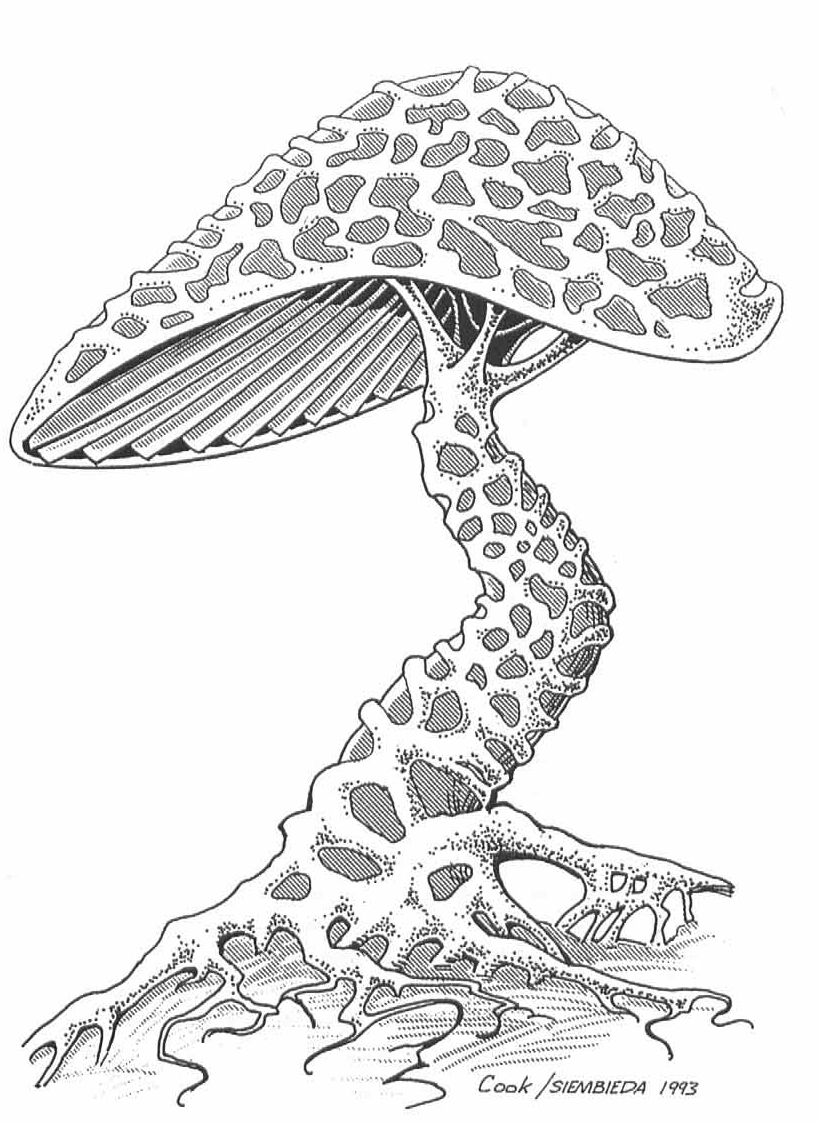Rifts World Book 3: England by occamsnailfile
Some Words from the Author
Original SA post
So I have been very behind on this thread and you people just keep pumping out the content. And so I am going to add more, which I was also behind on doing. That said, now it is time for
Rifts:™ England
Part 1: “Some Words from the Author”
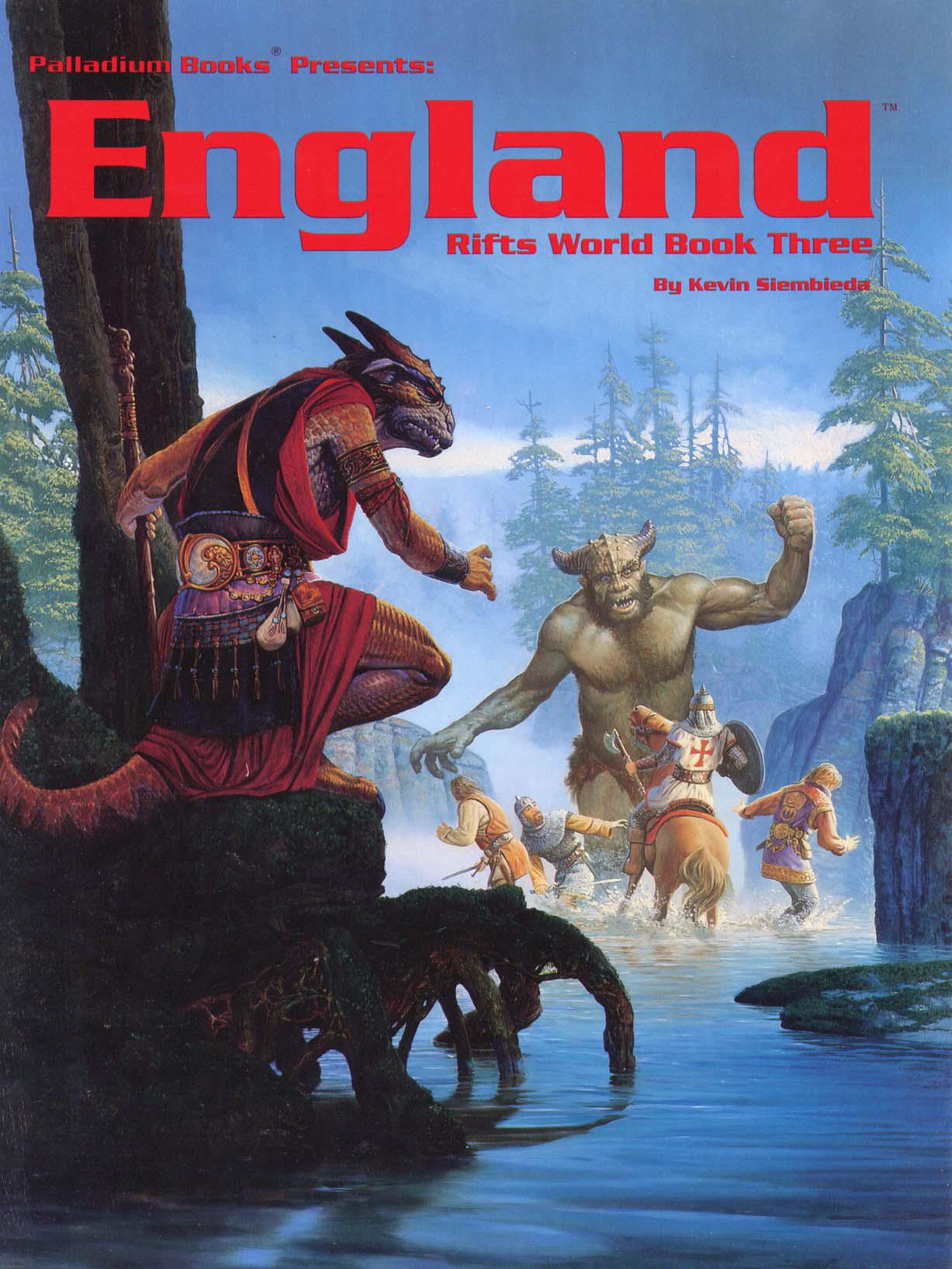
It is time for another Rifts World Book! This time England. The first several Rifts™ supplements had sort of a gesture of a metaplot with the Mechanoids sourcebook and the interconnections between the plots in Africa and other parts of the world. Of course, these were also Rifts at its rockiest. Well, that may not be entirely true, I haven’t read many of the later books and apparently they have not learned a goddamn thing about layout or organization in twenty years.
Here we go with England. The cover isn’t bad except that there are no guns in sight, or anything to suggest it isn’t just some random fantasy scenario rather than Rifts™. The details of it are explained later, it just doesn’t stand out. We proceed from there to Kevin’s usual warning about how all this is made up elfgames and don’t try to railgun your friends, kids. He then goes on to write a brief introductory blurb about the game:
Kevin Siembieda posted:
Of course, the setting is a future Earth, but I have to keep an atmosphere that is rich in British and Celtic myth, legend, and tradition.
I am glad to see that stereotyping is not being limited to non-white cultures, that is very progressive.
Kevin Siembieda posted:
Those of you who have skimmed through the book may be moaning to yourselves, “Oh no, not another version of King Arthur!”
Yes, yes I am moaning that to myself.
 Seriously. King Arthur is a rich mythos but its trappings show the weaknesses of those who use them. Also, is that really the only thing that defines England?
Seriously. King Arthur is a rich mythos but its trappings show the weaknesses of those who use them. Also, is that really the only thing that defines England?
 Technically the book is about ‘The British Isles and a little bit of France’, as Kevin explained earlier in the blurb but ‘England’ seemed like a catchier title. Also it’s where the Arthur is from, except for all those French guys or whatever.
Technically the book is about ‘The British Isles and a little bit of France’, as Kevin explained earlier in the blurb but ‘England’ seemed like a catchier title. Also it’s where the Arthur is from, except for all those French guys or whatever.
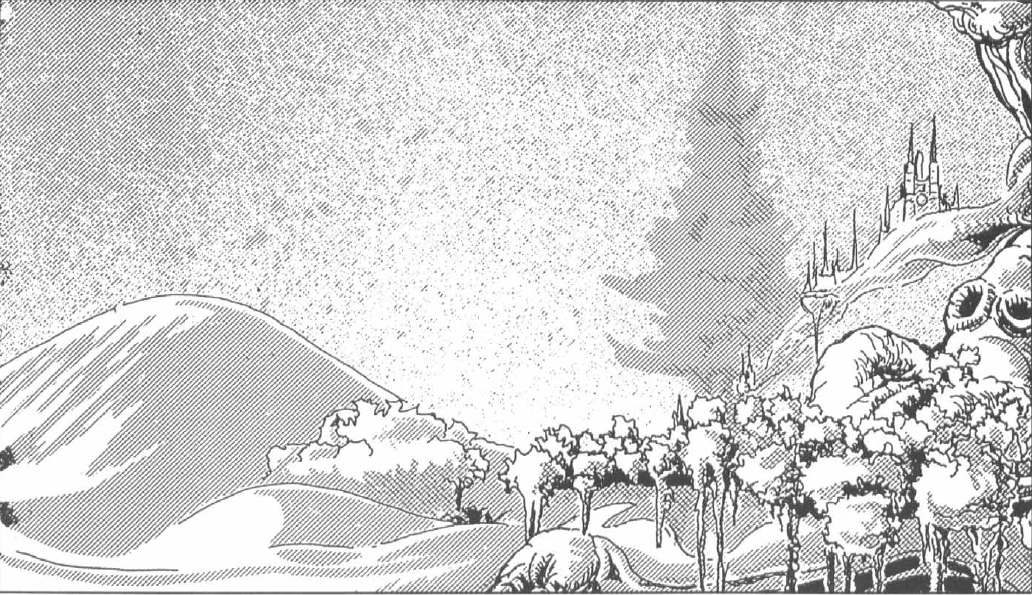
ah, yes, the green hills of unpopulated pastoral england
Then we move on to The Return of
 Erin Tarn
Erin Tarn

Erin is writing us (Plato) another letter! It’s been two years for you guys, she says, but only six months for me! Amazing. She then goes on to explain how she and her pals only traveled about 100 miles into Mexico and that people underestimate Vampires a lot. She can’t say if a Vampire Kingdom exists but it sure seems likely.

But back to the story, she agreed to take a dimensional rift as a shortcut to the Yucatan and yes she knows better and you’ve told her a hundred times and look it was a mistake, but they got to have an adventure in another dimension, isn’t that cool? The world was Wormwood which shall of course be of importance later, when another book comes out for you to buy. Anyway time was dilated there and only six months passed and she got back to Earth.
The rift took them to England of course, to stonehenge which has apparently been rebuilt by spriggans--which, well, they do like stone circles and all. The British Isles are apparently pastorally splendid, with rolling hills and forests and a giant multi-thousand story tree. Apparently it was the Millenium Tree and there are several of them and one of them gave her a gift of a magic twig-wand which totally flabbergasted her druid pal. She needed the wand because she was planning to visit the NGR and other parts of Europe soon, but that will be after she goes to New Camelot to meet Mrrlyn. Yes, Mrrlyn. She has heard some disturbing rumors about him but he is apparently a fan.
She winds up with some well-wishing and a little more expository writing about dire supernatural perils in Africa and maybe she’ll go to Asia and whatever.
There’s a small plug for Wormwood, coming out in summer 1993! I couldn’t verify the exact publication date well but I think they only missed that one by six months or so.
The book proceeds with a section on Millennium Trees which are inspired, in part, by ideas and drawings by Newton Ewell. Or so the heading tells us.
Millennium Trees are gigantic trees that stand over a thousand feet (305+ meters, thanks metric Kevin!) tall. They don’t change with the seasons or lose their leaves. The trees grow where they want, though apparently not in North America to date, but only at ley line nexus points because they feed on PPE. None of them have ever made seeds or fruit or whatever and scientists say maybe their lifespans extend over centuries because no real world trees do that. Their life cycle may be supernatural .

Druids and such believe that the seeds were present on Earth before the Time of Rifts, pointing to old legends about world trees and whatever. Others think they were just brought over by accident, which if the seeds are anything like the trees, it’d be like dropping a boulder-sized walnut on the ground and shrugging. Others think they’re an alien terraforming experiment.

The trees are probably intelligent. They don’t communicate in any normal way, but they seem to radiate benevolence and do react to the presence of other living beings, like Ms. Tarn. They heal the sick, reduce the intensity of storms, and sometimes seem to give people dreams or visions. But only those of good alignment. Evil creatures don’t get any love. Which perhaps makes these trees unique in the Rifts universe. And of course there are skeptics who say it’s all delusional perception bias. Testing the hypothesis with a scientific method sounds like commie d-bee talk, citizen.
The trees also grow big woody beehive houses for people to live in. the terraforming theory people suggest this as evidence, as part of the tree’s intelligent design. These house-burls have 100 MDC per ten square foot area, the book insists, with the smallest having 5000 MDC total. They look kinda like beehives divided into people-sized apartments and honestly this kind of weirdness is what I like about Rifts, even if all the druids-and-fairy-hugs stuff in this book gets annoying.
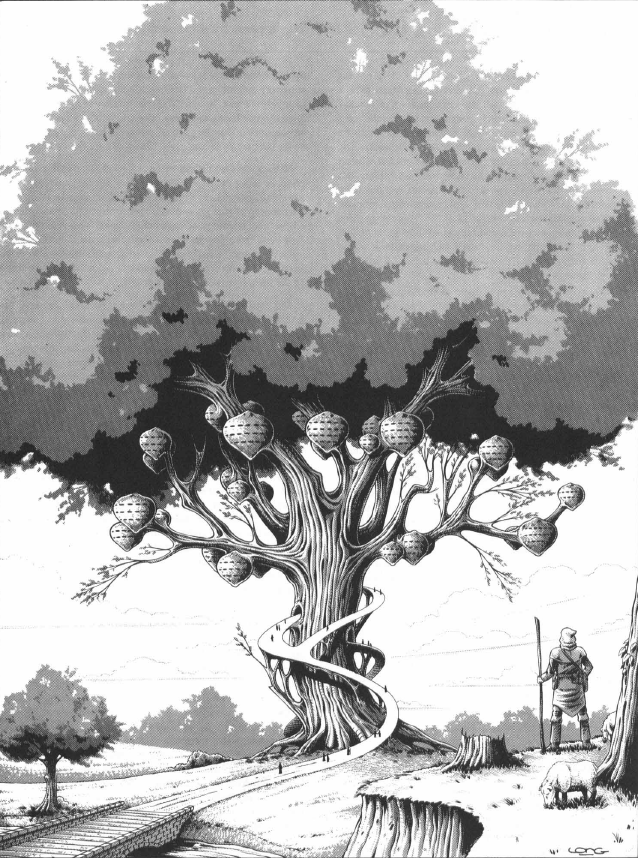
prime real estate there sonny, not full of giant angry bees.
Defenses
The trees apparently have some capability to defend themselves, which is a first for anything remotely good or non-fascist in Rifts-world. But first they explain that leaves and twigs of the Millenium Trees are magical items when they are dropped freely by the tree and replenish their PPE; segue from there directly to the tree being able to cause an MD explosion for...actually pretty stiff damage for breaking off anything. Even just a leaf is 2d4x10 which is enough to kill even most MDC humanoids. And it’s an area attack. Man, that’s a good idea in theory but if I were a tree-hating terrorist I’d just set off a bomb by the tree and then let it counter-explode for way more than whatever I just did.
It also says that the trees are usually home to a shitload of fairies who will swarm out like magic bees to defend their tree. It says they’re usually nice to other non-fairy residents, as opposed to their usual prankish nature, and also that all residents of the trees will be big friendly hippies who never abuse their home. With good reason, since it will explode. But it means that powerful supernatural creatures up the wazoo are always hanging around the trees. The trees, in turn, absorb normal ley line storms, but they can also apparently cause them as a means of self-defense.
This is followed by a repetition of the original ley line storm rules, along with some modifications like ‘transformed creatures including Myrrlyn and his Supreme Nexus Knights (not even a good band name godduh) grow or shrink or appear distorted’. Illusions disappear, magic goes a bit wild--because magic didn’t suck enough already most of the time. There’s also a table of random events to afflict those not nestled safely in the tree’s branches, including raining slimy things, random euphoria, and a rift opening, you know, good stuff.
Stats for the trees explain how tuff they are (pretty tuff at 50,000 MDC trunks) and how they are invulnerable to normal weapons and fire but take damage from mega-damage attacks. Thanks Rifts, I surely never would have guessed. And lastly, a rough inventory of trees, along with the statement that for some reason none of them exist in Asia or the Americas.
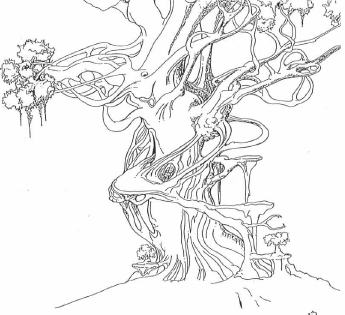
this looks a bit more like something Siembieda bought for his home in the 70s than a tree
"Gifts" of Magic
Original SA post
Okay, one more part for tonight; I don't wanna crowd too much, and I'mma going to bed.
Rifts:™ England
Part 2: “Gifts” of Magic

Because we did not spend enough time on these damn trees previously, here is more stuff about them. Specifically, the hippie-woodlands bling they will drop upon the worthy but unwary. For some reason “Gifts” is in quotation marks and I’m not sure if they explode or the tree actually considers these things a loan that must be repaid or what.
Anyway there are a ton of these. What the fuck. This is like Keebler Elves version of the Rune Weapons section in Atlantis.
Bark Body Armor: a full suit with 120 MDC (which is pretty good for personal armor) that has a reserve of 4D6 PPE spellcasters can use, and takes one-third damage from magic energy, fire, lightning and such. Conventional energy weapons do full damage though because the Coalition rules.
Bark Shield: a mega-damage shield. A basic understanding of the mega-damage system indicates how worthless this item is in the hands of a normal unarmored human.
Camoflage: It can cast the Camoflage spell on like everyone living there all at once
Control over Ley Line Storms and Rifts/Normal Weather: this is like the third time they’ve said this, seriously and how is it a “Gift” anyway?
Leaf Body Armor: If dressing like you gave a hoot wasn’t good enough, try on this fashionable photosynthetic piece! Suitable for day or evening wear, and has 60 MDC and gives +2 to saves vs. poison.
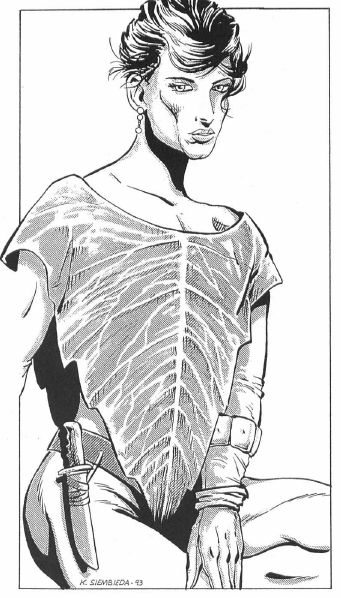
Leaf Blanket of Healing: If you don’t want to make it into a dress, you could just sleep under it. Heals 2D6 of whatever variation of -DC you have, camoflages the sick, and can cast Restoration (regrow severed limbs or whatever) once, then withers up and dies.
Ley Line Teleportation: Rapid Treensit Network. At the tree’s whim.
Magic Wands and shit: enumerated later. Wonderful.
Power to Heal and Purify Food and Water: Such nice trees all helping the sick and needy.
Resurrection & Restoration: can be done with some close time limitations, causes branches to wither away. Since we’ve previously explained that the growth of these trees is so slow as to be hard to notice, this seems like a major cost.
Sixth Sense Warning/Visions and Dreams: The tree may give small precognitive flashes or warning dreams and visions.
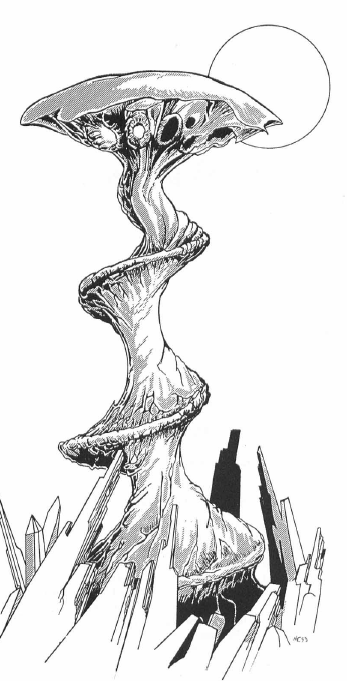
the colors man...the colors!
And now we get to
Magic Wands and Staves
, and to be fair they do probably deserve a whole separate section because there’s a crapload of them. This tree is like some kind of Japanese vending machine with collectible capsules full of magic.
Anyway all these wands and staves are sacred to Millennium Druids because if we did not make that clear, they worship these things. It is possible for alchemists and bio-wizards to corrupt wands to do other things, but otherwise they all behave exactly as written on the tin.
They’re all really hard to break, like 1D4x100 MDC for a wand and 2D4x100 for a staff. They do SDC damage as weapons except against vampires. They have a small PPE reserve that it regenerates over 24 hours. You can give them back to the tree at any time by just shoving them into it, blammo.
Wands
Wand of the Animal: Grants climb at 90%, cast five animal-themed spells per day as a 7th level sorcerer. Honestly the ‘climb’ thing makes me want to call it ‘wand of the Squirrel’

Wand of Deception: Golly, I thought these were truth-loving peace trees. Grants constant chameleon power to the owner. Five illusion-type spells per day, 7th-level.
Wand of Divination: This wand works a bit like an Augury spell in D&D except that it spins and falls in particular directions; fine. It only answers “serious” questions about death and harm though “will we win or lose” type questions generally net uncertainty. Only give this to players if you feel like spending a long time describing a spinning stick.
Wand of Dowsing: This is absolutely something I’d expect from this whole magic tree business. It can find more than water--it can also find the nearest ley line or nexus, Millennium Tree, home, or loved one--or for some reason coal. For all those steam-powered...things. Five times per 24 hours, grants constant direction sense. Not unhandy and not likely to result stupid games of twenty questions like divination above.
Wand of Knowledge: Grants user the power of tongues (
 ) and five castings of several knowledge-related spells per day. I don’t remember what they all do but at least one discerns truth from lies so is already more useful than the Divination wand.
) and five castings of several knowledge-related spells per day. I don’t remember what they all do but at least one discerns truth from lies so is already more useful than the Divination wand.
Wand of Life: A twig covered with 2d4
 oh sorry I meant ‘buds’. The number of buds is the number of times its weak-ass healing (1d6) power can be used. It can also negate poison, cure illness, and purify food and water a number of times per day equal to its buds.
oh sorry I meant ‘buds’. The number of buds is the number of times its weak-ass healing (1d6) power can be used. It can also negate poison, cure illness, and purify food and water a number of times per day equal to its buds.
Wand of Power: ‘The constant power granted to its owner is invulnerability’. What the shit? Like total? Is this like
 but an invincible star? It does not explain. It can also cast a few useful spells five times a day without giving up that other thing.
but an invincible star? It does not explain. It can also cast a few useful spells five times a day without giving up that other thing.
Wand of Seeing: There’s some kind of joke about blind people canes here. Grants see invisible and +5% to identify plants for some reason. Casts some vision-related spells 5/day.
Weapons of Wood: Vampire-slaying javelins and throwing sticks. It’s funny the tree would specifically make a vampire-killing weapon when all the vampires live in Mexico. The throwing stick is actually better because it damages vampires AND demons and “other supernaturals” and returns to the thrower. It still only does 4d6 though.
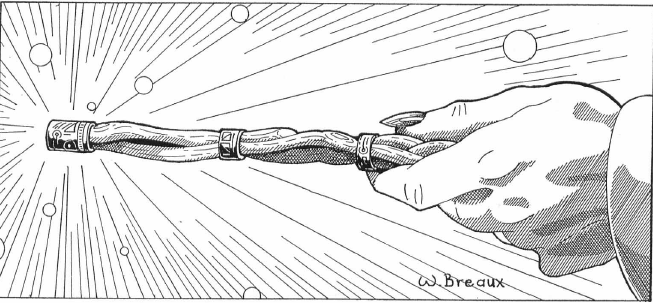
i would like to include more pictures but there aren’t any

Staves
Staff of the Earth: Senses magic/ley lines as a Walker. Ten spells per day that include a lot of wilderness survival and anti-undead stuff.
Staff of the Hunter: Can track humanoids and animals, tan hides, navigate and survive at 88%. Eight spells from a different set of wilderness-y stuff, that includes like ‘magic net’ or others that might help with hunting but are still not direct damage spells. Does mega-damage to MDC creatures.
Staff of Life: Giant version of the wand, more buds. This one clarifies something I didn’t understand on the wand: The number of buds indicates how often the healing can be used
per day
, not ever. The wand’s text sort of implied otherwise. Or maybe the wand just sucks. It can cast better and more healing/lifey spells and can be used to cast Restoration at a cost of four leaf buds.
Staff of Prosperity: Grants the ability to accurately identify fruits and plants (great for those wax buffets) as well as poisons in food, though uh, by taste. When thrust into the ground it makes a slowly spreading area (max 40,000 sq ft) into extra-fertile soil. If used as a supporting rod for a scarecrow, it reduces birds and other pest problems to less than 10%. This is an awesome staff though not for PCs most of the time. But I do like it when Rifts occasionally considers how their amazing magic and technology might do something besides shoot things.
Staff of Purity: This sounds like something they hand out at embarrassing assemblies in pro-abstinence high schools. When thrown into a well or buried in a spring, purifies the water no matter what pollutants are introduced. Take that, Dr. Blight. Alongside the Prosperity Staff, an interesting item.
Staff of the Serpent: aka “The Moses” I’m guessing. Sees invisible, invulnerable to snake venoms and dragons’ breath of any kind. Inflicts mega-damage to dragons (‘the St. Patrick’) and can in fact turn into a giant mega-damage serpent when thrown to the ground though honestly it kind of sucks compared to just using the staff as a weapon. It will obey simple commands though, so you can make your stick fetch other sticks.
Staff of the Wind: Allows owner to constantly float and sense wind direction. Ten spells a day, including call lightning and calm storms, so not bad I guess.
Corrupted Wands and Staves
Ah yes, the twisted and evil versions of all the hippie goodness. Powerful alchemists and bio-wizards (you know, those guys that
only exist in Atlantis
) can forcibly take twigs and branches from the Millennium tree and create items from them. It goes on with “Most of the magic wands or staves on Earth are made of wood from these mystic trees.”
 I’m just going to ignore that because that makes no sense at all.
I’m just going to ignore that because that makes no sense at all.
Anyway, all the corrupted wands and staves generally have the same basic features but some limitations like wands only having four low level spells or two high level, and similar reductions for staves. The spell strength of these items is also reduced to between 3rd to 5th level. The frequency of casting changes to some weird formula that is basically ‘less’. They still damage vampires. They do not grant the constant powers of regular staves/wands. Bio-wizards can also use corrupted staves/wands as the cores of other weapons, allowing them to inflict 1d6MD at the cost of one low-level spell casting. This is actually pretty worth it, except that it caps out at 4d6, which is in the ‘crappy gun range’. Still, given the cost of e-clips, mega-damage hand to hand weapons are a decent investment. Also they work with all those bonii from physical skills.
Enough of that! No more trees! Wait, what, the next section is about druids? FUCK
Herbs, teas, and magic potions play a key role in the everyday life of England
Original SA post
b]Rifts:™ England[/b] Part 3: “Herbs, teas, and magic potions play a key role in the everyday life of England”

Today we get into
Herbalists, Druids, Herbs, & Magic
so yes
 all around. Apparently the English crazy for tea has expanded into magic tea and potions and various herbological not homeopathic cures for diseases and whatnot.
all around. Apparently the English crazy for tea has expanded into magic tea and potions and various herbological not homeopathic cures for diseases and whatnot.
 Given that all of England’s major urbanization seems to have dried up and blown away in the wind during the time of Rifts, there are plenty of wild open fields and forests for nature’s bountiful magic plants to grow in.
Given that all of England’s major urbanization seems to have dried up and blown away in the wind during the time of Rifts, there are plenty of wild open fields and forests for nature’s bountiful magic plants to grow in.
Herbalists and Dryad Druids (the tonguetwister of sexy druids) seem to be the main purveyors of better living through magic chemistry, and keep substantial stashes around.
First up is the
Herbalist
OCC. By Steven Sheiring. Yes, that guy. The guy who stole all the things. Anyway he is credited with this section. Which means all pending drug-related jokes are his fault.
Ahem, anyway. Herbalists are indigenous only to England, Scotland and Ireland though they are permitted to travel to France or other parts of Western Europe, presumably with a Eurail pass or something. These guys are unique, and “more attuned to and in harmony with plant life than most druids.”

The Herbalist can do a lot of...plant stuff. Like grow trees fast and make magic teas and stuff. Herbalists must have been born and raised in Rifts England for at least the first ten years of their life.
Steve Scheiring posted:
This is important because of the special diet of mutant mushrooms that must have been eaten weekly to instill the characters unique powers over vegetation

That is to say, feeding infants special mushrooms. Mushrooms that are “permeated with microbes that, after years of consumption, cause a physical change in the person eating them.”
 So basically they eat magic mushrooms until they are themselves magic. Okay. But what does this let them do?
So basically they eat magic mushrooms until they are themselves magic. Okay. But what does this let them do?
Mysic Herbology : A new skill
Okay, they start off describing the skill as ‘holistic medicine’ and I am pretty sure they don’t know what that term means in either mainstream or alternative medical communities but we shall see. If they start talking about purging toxins I will at least feel secure that there is no Cherokee hair to be had in England. Mystic Herbology allows one to instill or draw out the magical qualities of plants and herbs, how to cultivate and preserve them, etc. It involves knowing all their properties, mystical and otherwise, and making them into appropriate potions/teas/unguents or whatever.
There’s a special note that this skill is a closely guarded secret, I guess because druids and herbalists are dicks who don’t want to feed all babies mushrooms so they have special plant powers.
Herbalists also get some class powers: They can sense weather conditions. Increase the potency of tea--turbo Earl Grey anyone? Detect Poison by smell and taste. They get a higher level of PPE than normal humans since they are magic users and some general save bonuses.
Now, on with the special magic powers . These powers cost PPE like spells, which is reasonable.
1. Identify alien/unknown plant life: this includes stuff about growth cycle, edible/poisonous, and other properties.
2. Sense locations of particular plants: They can do this after taking a hallucinogenic of course. Limited to five miles per level and one type per hallucinogenic dose.
3. Heal plant life: Total plant whisperer stuff, they can figure out what’s wrong and repair it.
4. Accelerate growth: This only works on ‘common’, not whatever counts as ‘exotic,’ or alien plant life.
5. Temporarily shrink plants: This is useful for travelling in dense woodlands, they say, but it’s 30 PPE for a 50 ft radius so it better be a small dense wood. It could also be a lame party trick at one’s next garden soiree.
6. Shape/Sculpt Trees/plants: Magical bonsai, okay. This one doesn’t say it’s limited to common plants and they can make frightening or weird shapes and such, get all artistic.
7. Shape Wood: Can mold dead/processed wood like clay, but for some reason specifically cannot be used to punch holes in doors, floors, boards, or boats. Because that might actually be a useful adventuring application for this power.
8. Animate Plants or Trees: This is like when the topiaries in the Shining TV series all ganged up on Jack, you know that one scene.
9. One with the Forest: This allows the Herbalist to meld with the plant life around them, and while they can’t move or do psionics or anything, they are also completely undetectable by magical and technological means.
10: Turn into a Tree: I suppose we all saw this coming. They can’t move or do non-tree stuff though they can hear people around them so pervy Herbalists probably abuse this power. It also gives them 200 extra SDC, so they have a 50% chance of surviving a single blast from the weakest gun in the game.
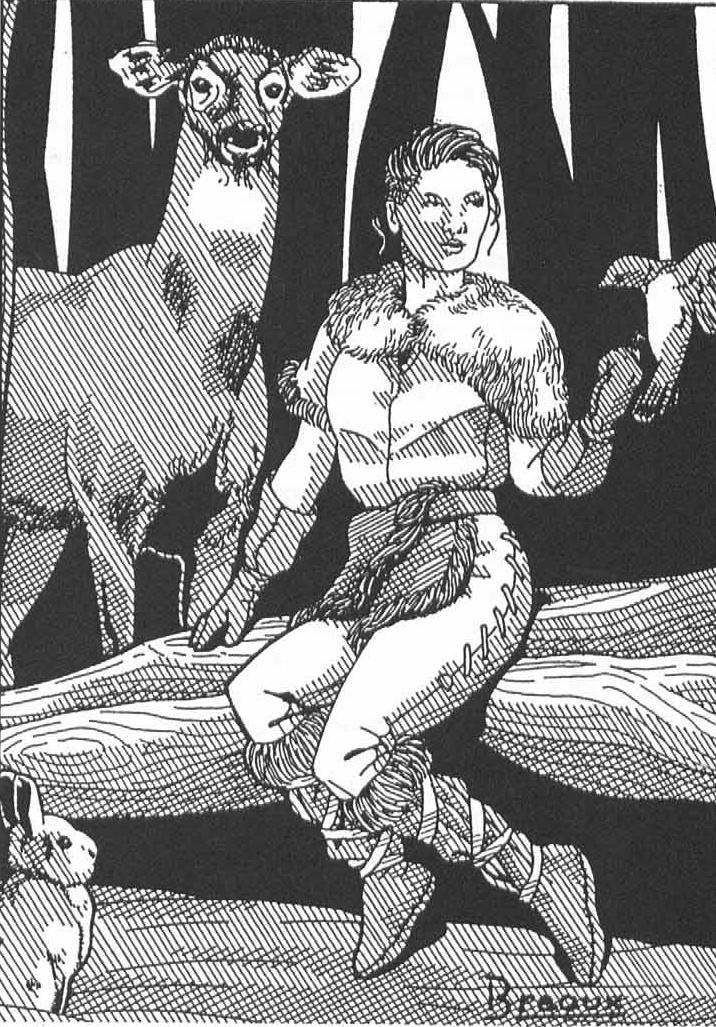
despite the art here, they are not special friends with animals. just plants.
After this we get into the nitty-gritty of class details, their various skills and whatnot. They’re not very combatty, they get some gardening equipment and some magic herbs. They don’t even get a gun by default. They get wooden stakes though! It also talks about their money and how kind herbalists will give their cool concoctions away for free, but most are selfish and mercenary and keep the best for themselves. Way to be jerk-hippies. It also says that players are not going to get more than 20% of fair market price when selling their goods to merchants, healers, or hospitals , you know, those places that need medicine all the time.
The Herbalist class is actually not bad in terms of having some quirky powers and being extremely useful to the society they live in, despite some oddness like the ‘selfish and mercenary’ bit. They are just not a good adventuring class by Rifts standards, at all. They’re geographically limited, for one thing, though you could get around that in various ways, and a lot of their abilities are kind of interesting but specifically limited in some cases to ensure they aren’t useful in an adventuring way. Also, how much time does the average party want to spend on gardening and picking berries in the woods? Though it is a hook to go out with, they just need more...stuff to make them a little tougher. Unless you’re playing a full game of Rogue Scholars and Wilderness Scouts.
Next we’ll cover the herbs and potions and such they can make in detail, and flipping ahead a little bit...it looks like a lot of fucking detail.
 So we’ll end this post here.
So we’ll end this post here.
An entire section of unscripted drug jokes
Original SA post Rifts:™ England Part 4: “An entire section of unscripted drug jokes”
Now we get to the Herbs section, which I am sure will tiresomely explain all the mystical properties of different kinds of new agey properties of herbal components. It first explains the process of making tea, and explains it incorrectly besides--their version is like ‘you grind up the herb and put it in boiling water’, no explanation about a strainer or anything. It also talks about how the potency of the herbs can be affected by the Sun and Moon (their capitalization) and ley lines and whatnot. A potion, meanwhile, is a tea or whatever created by a professional. This is stated specifically.
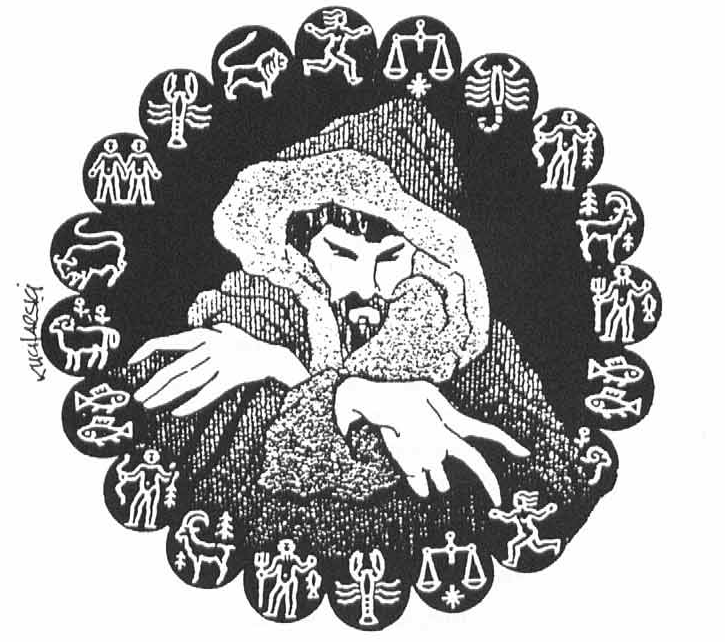
yes, this is all very mystical and meaningful, thank you
It gives us a quick overview of how pre-Rifts civilization viewed the Astrological Significance of things. All pre-Rifts civilizations were the same, of course, and held these mystical beliefs right up on through the age of power armored warfare that led to Rifts Earth. This overview is stuff like ‘the sun was thought to affect the human heart and reddish or yellow plants, or plants that looked like the sun such as the sunflower’. Brilliant! There’s a brief listing cribbed from some new age herb guide about each planet and astrological sign, I’ll spare you.
There’s a list of common food spices and their supposed curative properties. They must be prepared by an herbalist, druid, or “doctor of holistic medicine”
 to get their benefits. All these herbs must be administered as teas or they won’t work. That is the rule. There’s a long list with specifics that really aren’t particularly interesting, nor do they have actual game effects listed such as +2 to save vs. disease or something. Like cucumber is supposed to help with heart and kidney problems; I know cucumber is healthy but I am not sure it is what I would administer for renal failure in tea form. But hey, magic herb medicine in a world with a dinosaur swamp isn’t really that out there, so okay.
to get their benefits. All these herbs must be administered as teas or they won’t work. That is the rule. There’s a long list with specifics that really aren’t particularly interesting, nor do they have actual game effects listed such as +2 to save vs. disease or something. Like cucumber is supposed to help with heart and kidney problems; I know cucumber is healthy but I am not sure it is what I would administer for renal failure in tea form. But hey, magic herb medicine in a world with a dinosaur swamp isn’t really that out there, so okay.
The list of specific relatively mundane ailments these teas can cure is quite long and includes some stuff like ‘dried centipede’ as a treatment for lockjaw. Dried centipede tea? Ugh.
All of the previous was apparently just the regular-style herbology, the Herb Magic section begins now. Herb Magic is basically like techno-wizardry in that mystical energy is imbued into otherwise ordinary plant products to give them magical properties. A lot of that last section sounded like magic already, but apparently this is MORE magic. Often the PPE costs are pretty high so they do ceremonies on ley lines and nexuses and

It does mention that good druids will use animal sacrifice to get the double PPE bonus but only the evil Blood Druids of France do human sacrificin’.
Then we get yet another really really really long list of specific magic herbs and what they can do. This is several pages of solid blocks of text with no pictures. I’ll just pull out some highlights as examples.
First entry: Alder Tree. Mundanely, it is used to treat diarrhea, fever and fever aches, and colds. Enchanting three of the leaves and then burning them will summon a lesser air elemental. Enchanting a staff of alderwood allows one to control one lesser air elemental. Air elementals are immune to a lot of types of damage so actually kind of a pain to deal with, so okay, kinda useful. 20 PPE per leaf, 450 for the staff. Market value for staff: 600,000 credits. Market value for an enslaved spellcaster from SpluMart to churn these out: 60K-360K.
Belladonna: Your friendly neighborhood deadly nightshade. Can be made into a potion that causes paralysis for 2d4 minutes. Can also be made into a poison potion that does 2d4x10 MD and causes 1d6 minutes of paralysis. Market cost 6000/15,000 credits respectively. Actually pretty useful, though really really expensive for something you have to make your enemies eat.
Carline Thistle: Branches from these can be turned into wands that predict storms. Has three flowers that start closing when it gets humid and close completely when a storm is 4d4 minutes away. For 12,000 credits, I can also tell you when a storm is 4d4 minutes away. By listening to the thunder. This is a waste of 175 PPE.
There are a large number that grant some small bonuses to save versus poison or magic, or negate poison entirely; ergot can cause hallucinations, or make the drinker immune to illusionary magic for 20,000 credits.
Mandrake root: You knew this one would be here. Slightly narcotic, befuddling potion, Empathy potion, Telepathy potion. Can also be made into a voodoo doll that serves as a focus for bio-manipulation as per the psionic power. 150,000 credits for petty revenge.
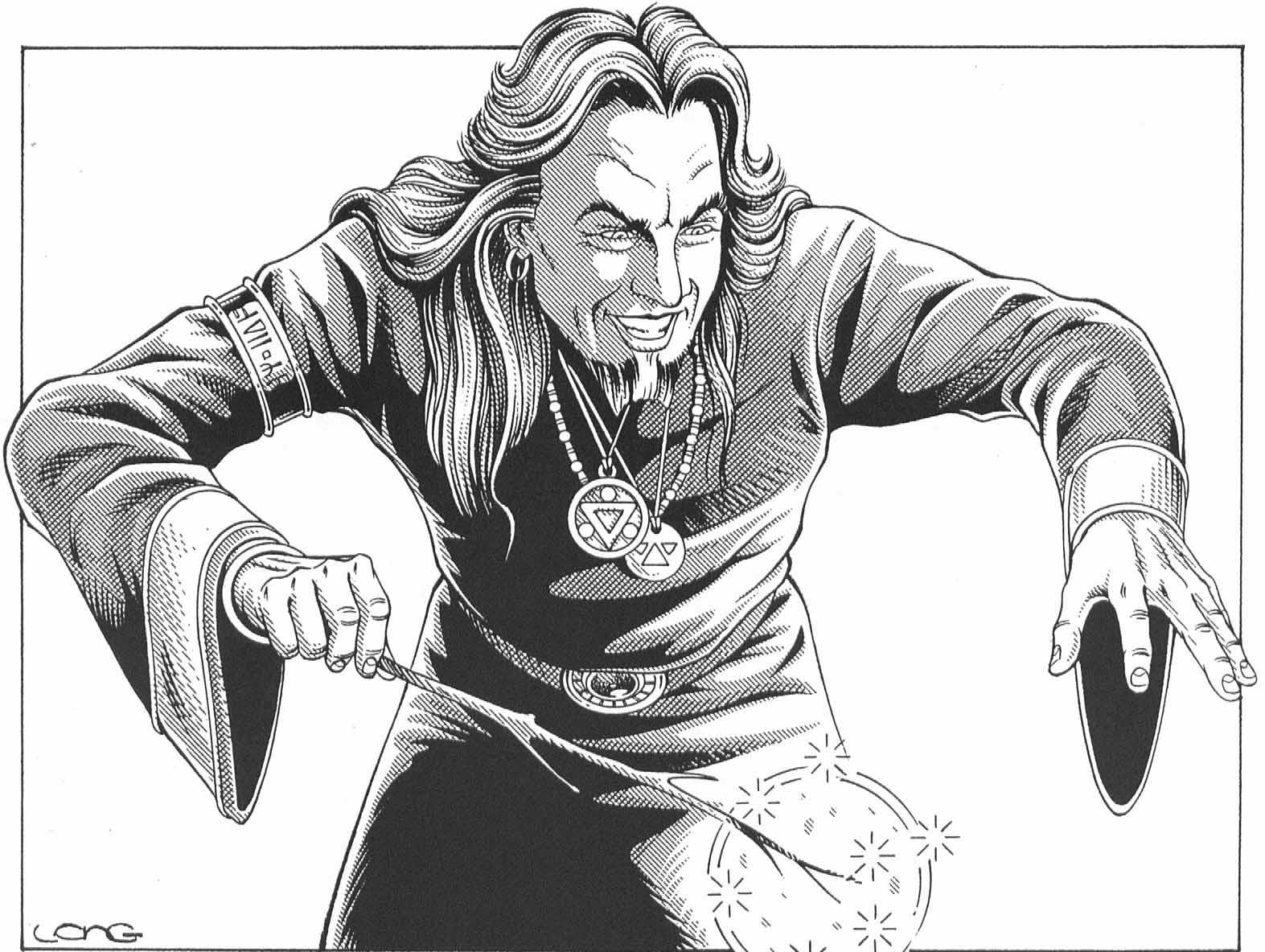
your friendly local magical pharmacist
Oak trees get like half a page of things you can do with them.
Solomon’s Seal will let you summon any lesser elemental and an enchanted sprig will also control any. 900K.
Willow tree potion makes the drinker impervious to energy attacks for five minutes per level of the herbalist--which, five minutes is a loooooooong time in combat rounds involving energy weapons. 20,000 credits, 75 PPE, totally worth it. Can be made into a staff as well that grounds the user and makes them immune to electricity. 250,000 credits for a lightning rod.
Magic wormwood (not the growth of the proper noun planet) can repel goblins, worms, larvae (termite repusion IS handy) and Worms of Taut as described in the conversion book. 1000 credits a pound. 100 PPE to enchant 10 pounds per level.
Then they go back through and give an alphabetical list of all the uses for herbs and which have them, and poisons and staves and so on and really this is a huge, padded list. Though some of the actual magical items are kind of useful, the pricing on them is weird (as the Rifts economy often is) and PCs would be spending a lot of time ritual casting on ley lines. Also Millennium trees grow on Nexuses and so take up most of the big energy there.
Herbs of Legend, Alien, & Magic
Good grief, more fucking herbs. Wait, no, these are like alien plants and stuff. Which is kinda cool, weird roaming malignant intelligences shouldn’t be the only things that travel through rifts. Though some of these specifics are as usual a bit strange.
First we get the Brain Tree , which is a weird lobey cluster thingie that really looks like something you’d have to shoot through to continue progressing towards Mother Brain.
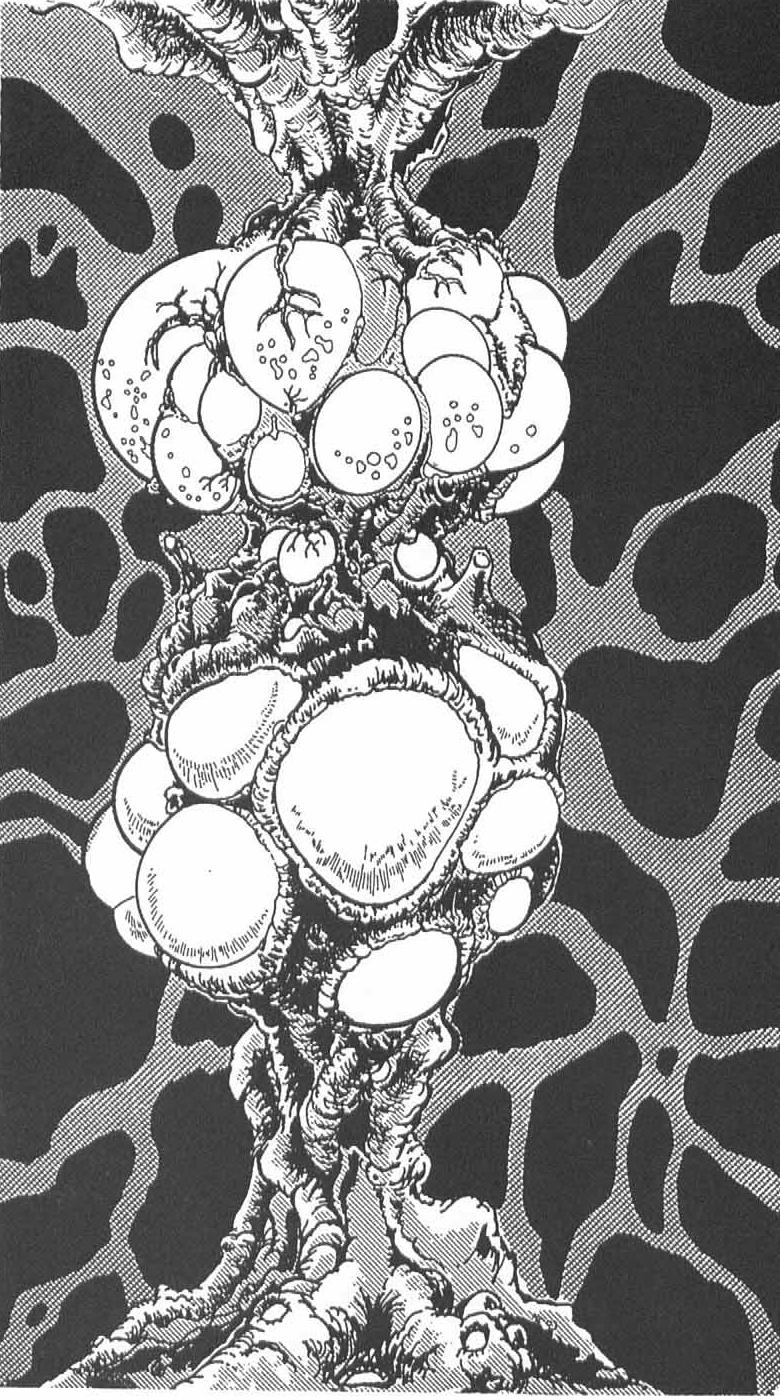
seriously that thing is going to take like, ten missiles
It glows, so areas it inhabits tend to be monster-free since subterranean monsters don’t like light, and it’s generally benign; you can even cut off and eat parts of its roots safely. The problems arise when you try to cut one of the lobes free--then it unleashes a psychic storm that does 6D6 MD three times a round and forces a save vs. paralysis or lose permanent use of a limb. That is pretty vicious, good thing they completely forgot to give an MDC value for the lobes so you could be trying to pry on that sucker for a while.
For your trouble, you can make some potions that can cast the equivalents of spells and cost between 2-12,000 credits, which is a great profit margin for risking loss of a limb every three seconds. You can also make a staff that does some spirit controlling spells and costs a million credits or a helmet that gives you electrokinesis for 400K...or you can make a crystal ball that allows remote viewing of known targets up to 300 miles away for 5 minutes per level of the viewer and has a listed price of 250 million credits. Way to go, Rifts economy.
Cobra Vine : Our next entry is another alien plant that has a ‘cobra-like head’ and tendrils that can move around. It has a pungent odor that resembles decaying flesh to attract scavengers and such, and then it lashes out at the animals who come to investigate. Take that, vultures. Its ‘heads’ have sticky undersides that adhere to prey, and then the needles come out and suck the blood out. Of course. Humanoids who were for some reason drawn to the smell of decaying flesh usually survive, suffering 4D6 damage.
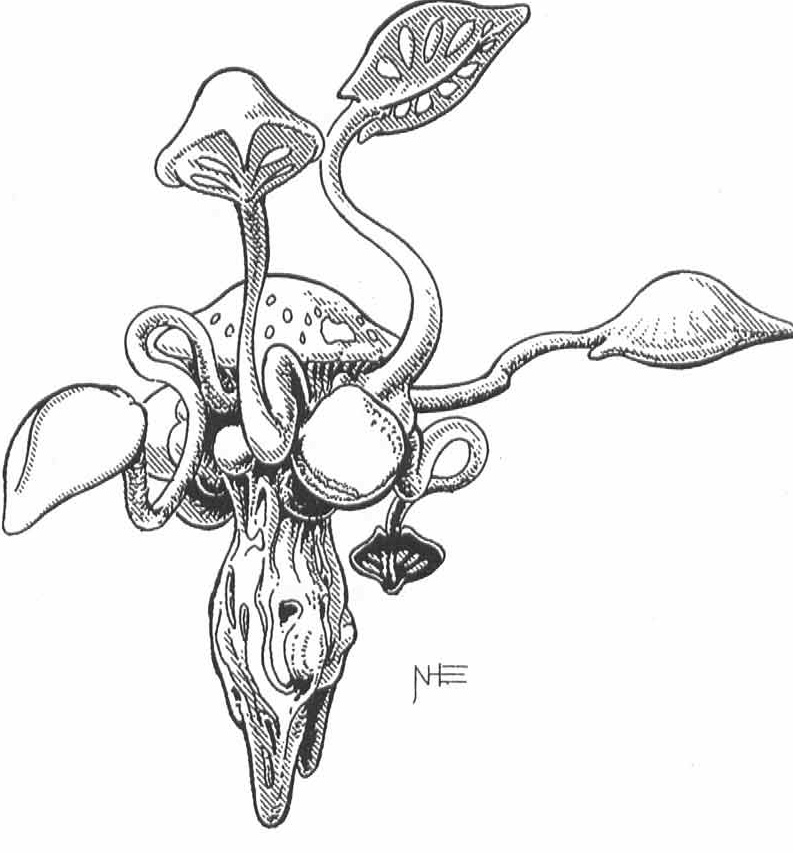
yeah, that doesn’t look suspicious at all, go take a sample
As a magic herb potion it can cure vampire bites, leukemia, bone cancer, and other problems of the blood. And wizards sometimes plant them in the gardens as guardians.
Dagda’s Scepter : Another alien plant that grows on Earth. They say that when pulled from the ground it resembles a scepter but seriously look at this thing:
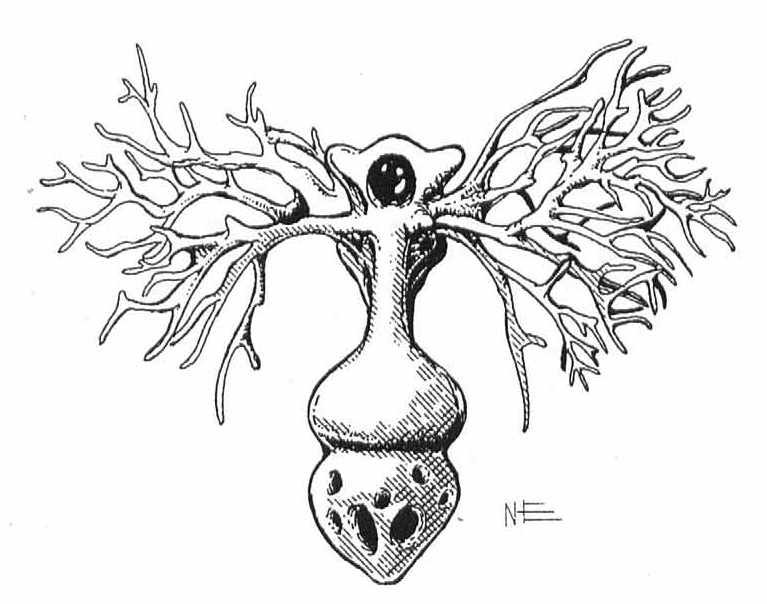
I don’t know what word I would use but ‘scepter’ is not it. Seriously, I can’t even get a dick joke out of that. It’s completely immune to fire and heat and it can be made into several useful kinds of teas and potions for healing or fire resisting, and doesn’t seem inclined to attack local wildlife or permanently paralyze the unwary.
The Faeries’ Cauldron More alien plantlife carried to Earth. You know, I am really surprised there are not more interdimensionally invasive species than are usually detailed, but then, thinking about the setting too hard is not a good idea. Anyway this is a mushroom with inverted cups that collect rainwater and fairies will sometimes swim in them. The bowls and bulbs can be broken off and are little PPE batteries, and are also edible so long as they have PPE in them. Drinking the water is mildly narcotic, grants see invisible and 2D6 points of healing and stomach cramps, nausea, and ‘worms’. Putting human blood into one of the cups makes a deadly poison. Faerie blood makes a potion that will literally turn you into a faerie for a while. Dragon blood will make a shapechanging potion--take that , boomslang skin. They may also grow into a magic circle that can grant up to 200 PPE before it starts shooting lightning.
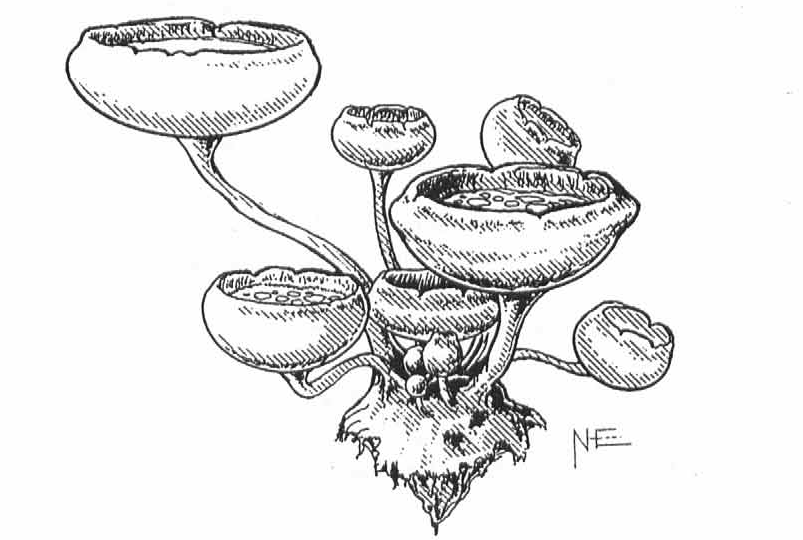
It can also be specifically prepared into several magic potions with generally healing properties, plus shapeshifting. All fiendishly expensive. Honestly I am amazed that herbalists do not just cultivate swarms of these around every ley line they can find.
Snapper Heart : These are large-sized flytrap kinda things, mostly harmless to humans unless you go sticking fingers into the obvious mouths. The root acts like a mild amphetamine and hallucinogenic.

i am almost certain this thing prefers drainage pipes
And lastly, we have Towershrooms .
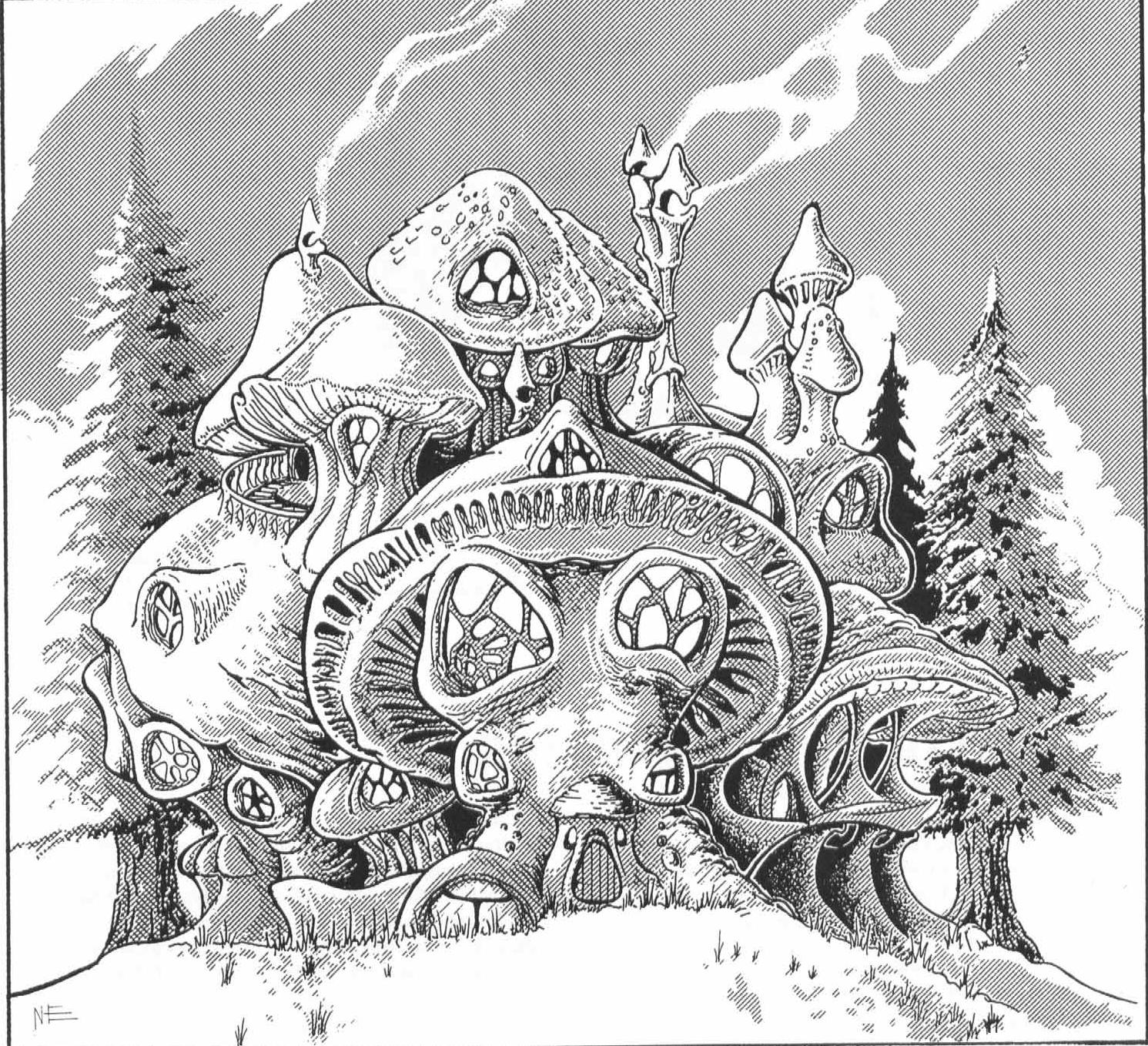
finally the smurf nation can cease its wandering
These have no special magical herbal properties, but they do naturally grow hollow, so they are totally made for building into a mushroom house.
Okay, no more plants. I think the alien plantlife is sort of cool but it’s also something a lot of players are really not going to care about too much unless they really just like reading a field guide to alien plantlife. The whole herbs section is super-padded and sort of out of step with Rifts’s general tone of ‘shoot all the things, forever’, though to me a campaign around gathering rare and valuable plants could actually be fun, as I often have PCs with some kind of side business that sends them into the wilderness. It would just be made difficult by the rest of the setting. The value of many of the things that can be made from even mundane plants is probably why the weird notes about how Herbalist PCs can never get good prices for their wares despite them all being listed at the price of several farms.
This is why we hate druids
Original SA post Rifts:™ England Part 5: “This is why we hate druids”
Another installment of merrie olde Englande which is apparently now free of all that urbanization that was clogging up its glorious green fields and now full to the brim with Druids!
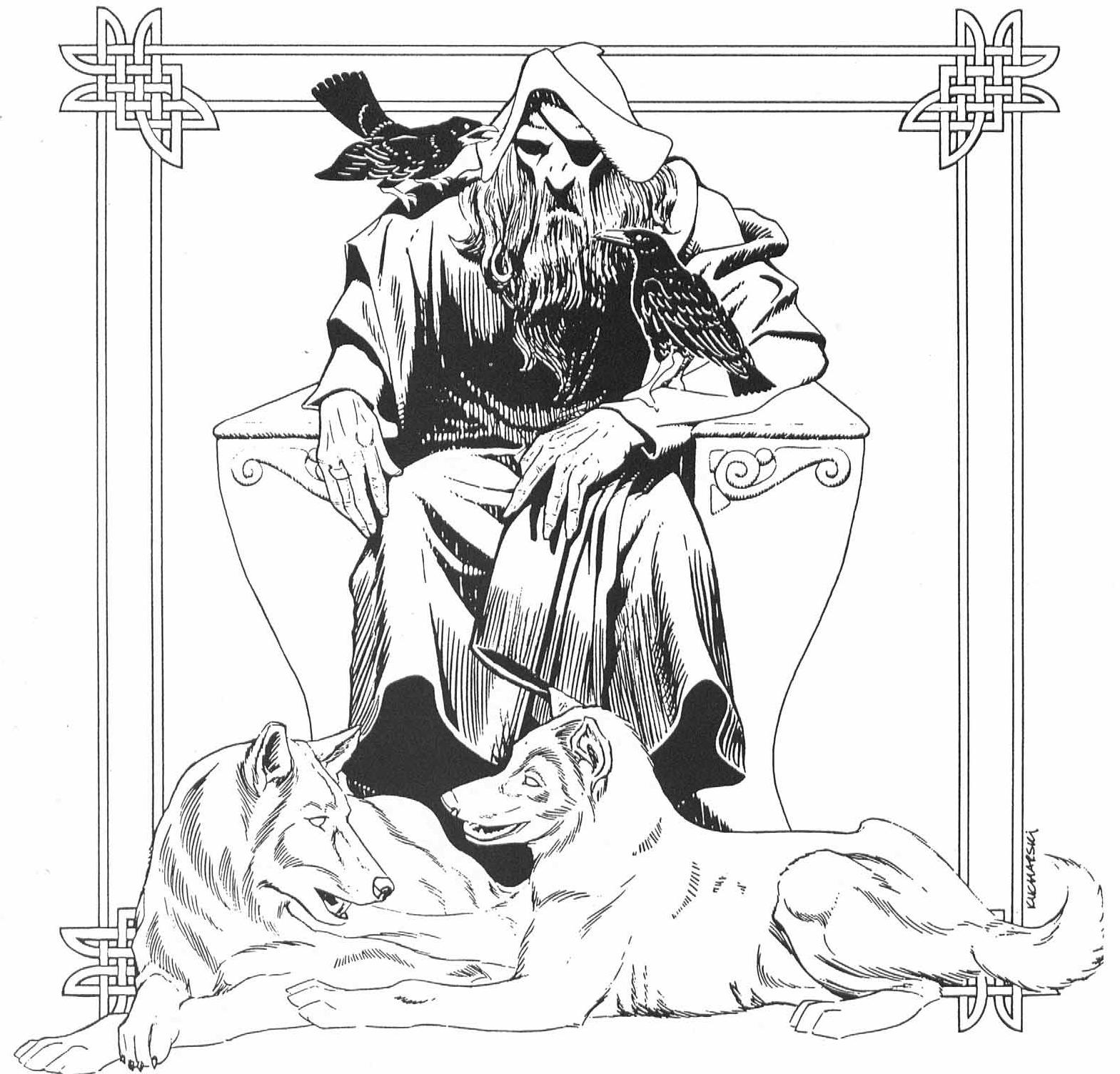
and by ‘druids’ i guess they really meant ‘odin’
There are apparently three divisions of the so-called Woodland Druids, the Dryads, the Filidh, and the Scathach. I suppose if White Wolf can just randomly steal words for their splats, so can Palladium. All of these druid-types are basically ‘an it harm none, do as you will, love is the whole of the law’ etc etc and they should come with a tie-dye shirt in their default gear. They don’t object to reasonable amounts of logging to build tract housing, but want balance and whatever.
The Filidh (‘fil leed’ according to the book) is basically a Fianna Galliard minus the werewolf part. They’re poets, scholars, herbalists, etc. Also, many have learned to use such modern tools as cameras and computers to help fight evil! Their magic herbal knowledge is limited to “divination, clairvoyance, and protection against the supernatural,” I guess to give the Herbalist OCC a reason to exist. They get a fairly usual selection of skills though the fact that ‘Euro’ is a language will always be dumb...but then I bet ‘Chinese’ is also. They get a bunch of herbs and a wand and staff of choice...which some of those are pretty buff. And they all specifically have a walking stick which may be the aforementioned staff, and dress like Cary Grant Robin hood-types. They also get a horse. A normal horse. They are extremely boring.
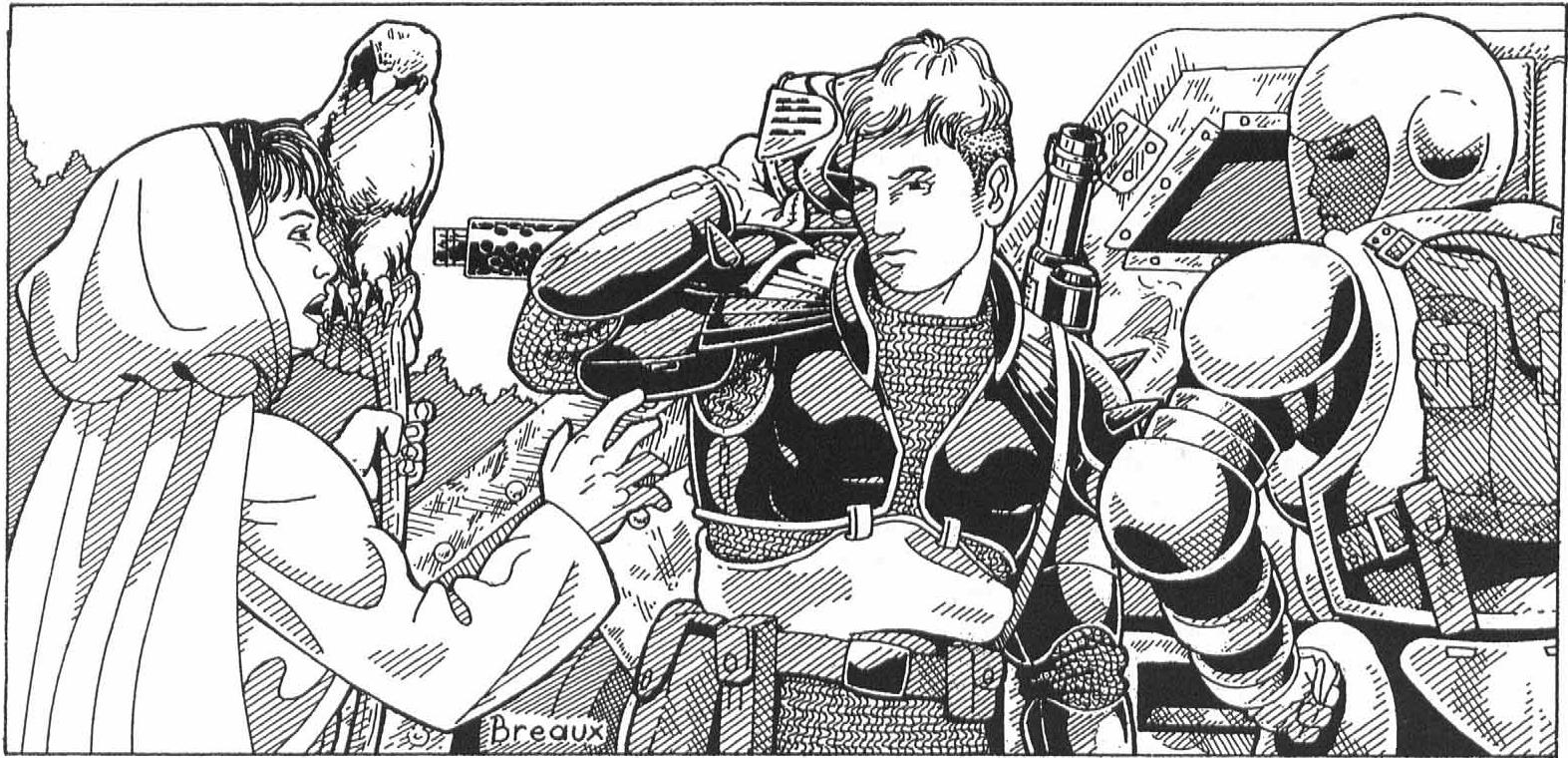
why do i get the feeling that she and her parrot are lecturing those guys about littering?
The Dryad OCC is described as the ‘master of herb magic’ because we didn’t already have one of those, healing, and making wands and staves. Wait, what, seriously? We really did just have one of these. Also that is not what a ‘dryad’ is, even if this class is restricted to women.
It’s noted on all the druid types that they have far less PPE than other practitioners of magic, no particular reason why since they don’t even have any actual spells except--oh right the first time we get magic-item creation rules that might actually be useful. The Dryads are also noted as ‘the ultimate masters of herb magic’, which seriously, I thought that was the mushroom-fed mutants up above, what is this class even doing here? Also apparently it’s ‘dray ad’.
Equipment is two wands or a wand and a staff and a bunch of wilderness gear; it notes as well that both the filidh and dryads mostly wear magical bark or leaf armor, it doesn’t specify that they receive it automatically. Also they don’t get a horse and apparently don’t like learning to drive. This class gets better equipment than the Herbalist but their shitty PPE numbers mean it will be hard for them to use their magic plant skills much, and they can’t do all the funky plant manipulation the Herbalists can. It was apparently just really important to call this class ‘dryad’ and restrict it to women and then not make them interesting in any way.
Lastly, the Scathach . These druids are warriors and blacksmiths who can work with more than just trees--they can manage metal! And maybe even rock. Also it looks like they have a whole big list of stuff they can create. They again get really limited PPE, lest their item creation powers actually manage to function. These guys have a huge list of special magical junk they can make which is separate from the usual list of magical herb crap that already got its own fifteen page section, so here we go.
1. Magic Cauldrons! (sic) They seem very excited about this. Perhaps Williams Sonoma has not re-opened yet and so cookware must be magically-hand-crafted through rituals involving animal sacrifice. Anyway, these things take months to make, 133 PPE per stage (awfully specific) and there are several kinds. The PPE cost apparently does not vary based on size of cauldron.
So here we go: Cauldron of Boiling. Makes anything placed inside it boiling hot without any need for fire. PPE Cost 450. Wait, is that in addition to the other cost? for a magical hot plate? 30,000 credits on the black market. The people of England must be really short electric ranges.
Cauldron of Destruction: Anything, including rune weapons, can be melted down to slag or ash in this cauldron. Now this has actual plot potential, though it only works at a ley line nexus on the winter or summer solstice or a lunar or solar eclipse. For 1600 PPE there has to be an easier way. Also requires a scatach to be 10th level or higher, which is basically unachievable in any normal campaign length.
Endless Water: Endless water. 40,000 credits, which I can see many communities investing in.
Plenty: Jesus cauldron, food or drink prepared in it will feed ten times as many people as one of its size normally would. Given that they can make these basically as big as they want according to the text above, this is another thing I would fully expect every town or city with enough barter to invest in, which is probably why they’re 300,000 credits. Take that, starvers.
Purity: Apparently not abstinence-related, it just purifies poisons or pollutants or whatever and only costs half as much as the cauldron of plenty! A bargain for those organic food lovers out there.
2. Other Magic Irons
I guess there are other magical metalworks the Scathach can make, I’m not going to list them all in as much detail. Magic chains that require supernatural PS 40 or higher to break but only have 10 MDC per link, magic fireproof hammer that does SDC damage, magic horseshoes that give horses a speed buff, magic javelin that is less good than the ones the Millennium Trees drop on people, Magic mallet that is like the hammer but ‘bigger’, magic manacles that are like the chains but slightly stronger, magic nails and spikes that never rust or bend, magic sword that does minor MD to creatures of magic, magic throwing iron like the sword but ranged.
3. Weapons of Wood
As with the ‘other magic irons’, not going too deeply into these. Magic arrows of specific types of wood that damage specific types of supernatural creature exceptionally or just do extra SDC, woo. +1 bow. Magic Flute that always sounds like a pro. Magic war hammer +1 (of wood?) and throwing stick.
That’s it for their list of various magical goods; Rifts tends to discourage improvisation from their highly detailed lists of course, and a lot of these items pretty much suck. The ones that don’t are mostly the ones that would help a post-Rifts society survive like the Cauldron of Plenty, but they never examine the impact of conveniences like that where they exist, in magical or technological form. Though really the technology people only ever invent various kinds of robot, just read the Triax book, you’ll see.
Anyway they get some average skills and ‘two cauldrons of choice’ except destruction, so that’s like, two out of a list of four. Or two of a kind. Some other ‘magic irons’ or iron and wood. And they get a horse with magic horseshoes. Says they like to wear heavy armor but gives no specifics--and while they can choose one of the magic weapons from the selection for their starting gear, they don’t have a lot of offense either. Also, this is not really a good adventuring class anyway--set up shop by a line nexus with a town and start working, done.
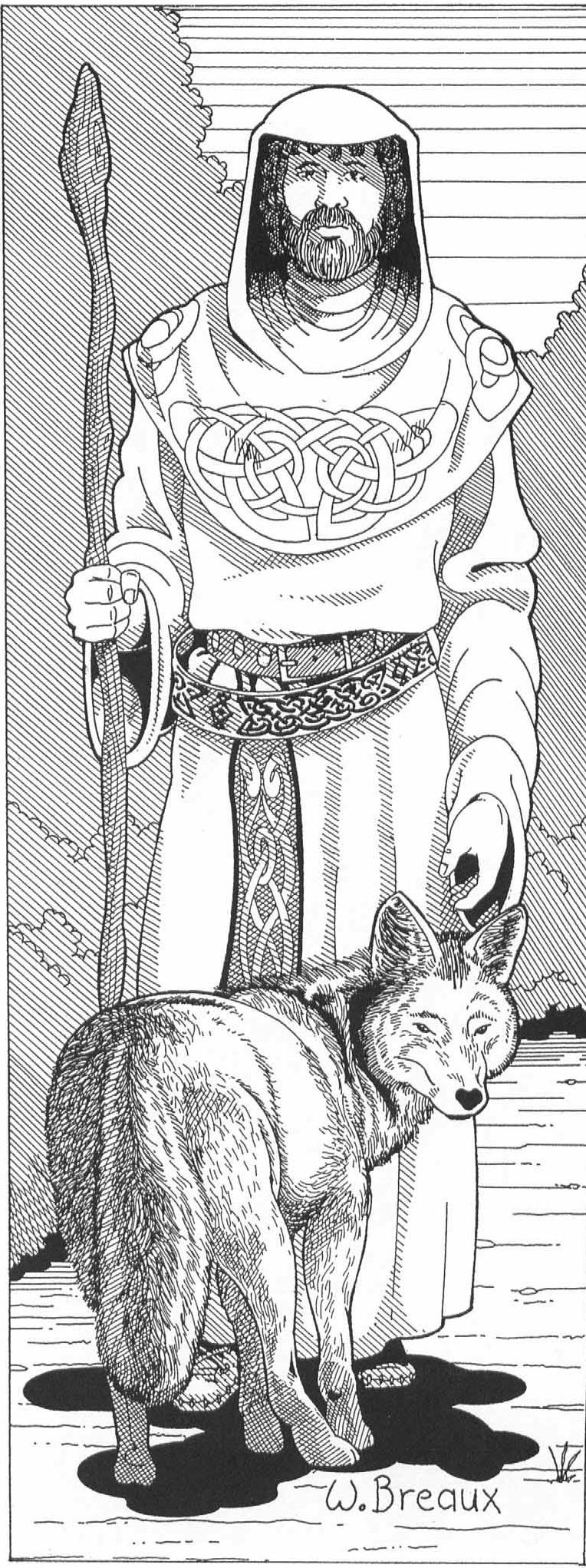
The first three were collectively called “woodland druids” which makes sense because the next type of druid, the Millennium Druid, patterns themselves after their sacred Tree of Life. They’re all vegetarians though not the fanatical kind who lecture people about factory farming, and mostly they wander around like hippie knights-errant, healing and helping and spreading farming lore and whatever. Like Batman, they don’t like to kill, and so often just let their enemies go to return to being pests later, because that is the law of nature: never kill. Note: The Millenium Trees are specifically noted as having the power to kill the shit out of things that bother them, including exploding themselves violently, so these guys are just morons.
Powers of the Millenium Druid
“One might argue that the real powers of these druids are kindness, strong will and dedication to their beliefs rather than magic.”

Mostly though their powers are ‘getting to know the Millennium Trees’ and it says that the better a tree knows a particular druid, the more frequently it’ll give them visions or healing or all that fancy tree-swag they can make, though staves and such tend to be reserved for 7th level and up. Because Millennium Trees can sense XP. There isn’t any other qualitative data, just “the trees like them better the more often they visit.”
They also don’t get the Mystic Herbology skill, just Holistic Medicine, so they can only do the weaksauce herb powers. They do get some starting tree gifts, bark or leaf armor, a hooded robe to look properly druidly, and a horse. It mentions that experienced druids may ride exotic mounts. And that’s basically it. The whole class’s powerset is ‘the trees like you better and may give you things, at the GM’s discretion’. All of these druid classes kind of suck, but this one may be the worst. They don’t even get the very minimal caster PPE boost that the item-crafters do; they are totally dependent on the Millennium Trees and having adventures be conveniently located near them. There isn’t even a ‘commune with trees’ unique skill to maybe give some numbers to what they can get. Also: They don’t speak English by default. Just Euro and Faerie.

All of this is pretty poorly laid out but it is nothing compared to what comes next. A hint: Chiang-Ku Dragons
Also yay, Meikyuu Kingdom!
The Creators of Tattoo Magic
Original SA postAlien Rope Burn posted:
It bears mentioning these magic goodies don't have any unusual costs of creation other than magic power and ritual, so somewhere in England it follows there must be a Scathach cabal or cabals that are filthy fucking rich. Not that there's a whole lot to spend your money on in England, since it's all pastoral and rural communities, but...
Scathach and Herbalists (or Dryads I guess) are both moneymaking machines if they apply themselves a little. Of course the ley line nexuses thy would need to be near to do most of their useful magics can be a bit dangerous but that is what standing armies are for. I actually like magics/effects that do more than have combat stats, but these are A) absurdly expensive and B) never mentioned again for the most part ever. And a lot of the magical items listed would be useful things to have around--but Rifts communities are not noted for their investment in infrastructure.
But enough about wanting actually functional societies, let's have more dragons.
Rifts:™ England Part 6: “The Creators of Tattoo Magic”

Pretty much all Rifts books will include some fairly random new classes that may be half-assedly worked into the local theme, or may just be there because. In this case, we have somebody’s 80s tattoo of a mystical dragon race who were mentioned as being the original inventors of tattoo magic and extinct back in Atlantis. Well, surprise, they’re not extinct, and equally surprisingly, they are not too special for PCs to be allowed to play. These wise and benevolent dimensional-traveling dragons taught the Chinese all their Chinese-y magic like “Feng-shui” and astronomy, and they helped build the pyramids of Egypt and stonehenge and such, but nothing for mesoamerica because fuck those guys.
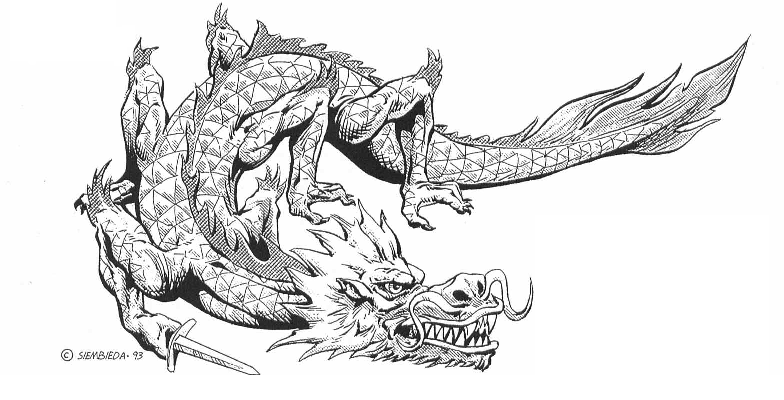
but this one’s got a knife
Most of them died when Atlantis first vanished and most of the rest left Earth as its magic started to wane and nobody knows where they originated (apparently including the Chiang-Ku themselves) but there was one in Villains Unlimited as an enemy I guess. It’s also stated as mysterious why most of the others died in other dimensions; I thought it was explicitly stated that the Splugorth basically hunted them down. But no, the book suggests maybe it was dragon Ebola or something. There’s maybe like a hundred left, total, two dozen on Earth, half of which live in England because that’s what book they’re in.
Eleven of them are disguised as yet more druids (but with tattoos) and acting as the ‘Nog Henge’, protectors of Man and Faerie, enemies of Camelot. They’re secretive and stick mostly to Scotland but help out rural folk and negotiate between humans and fae, which, given what dicks most Rifts faeries are, is probably a skill in high demand. They flee from Mrrlyn but he hasn’t figured out their secret yet, and we also don’t know Mrrlyn’s deal yet because the game is throwing all the class crunch at us before finishing the setting details. Oh, wait, it explains he’s a manipulating evil alien intelligence as foretold by Lazlo’s edict of planetary distress. Hey look, a reference to the Mechanoids book! Fortunately the Chiang-Ku, while good-aligned, are masters of subterfuge and have not been discovered.

There’s also a Chiang-Ku hiding as a knight in Camelot, Prrcyvel, because Siembieda loves these dumb spellings, and it explains his stats are in the Camelot section at the end of the book. Another one is pretending to be an Undead Slayer in the NGR. There are three in Africa as well. The first is “Pharaoh Rama-Set” who is apparently the evil overlord of the Phoenix Empire in Egypt. Another is ‘Abkii the Defiant’ who likes to fight and party, and then there’s Fang-Lo, who has had troubling visions of the giant metaplot that dominates the Africa book. We didn’t get fancy NPC writeups for any of the dumb druids but these guys are apparently manipulating human history left and right, now and in the past. Original Rifts was advertised partly as ‘the RPG where you could play a dragon’ but now we have secret, specialer dragons.
Now we get a statblock. They have both adult and hatchling stats and it doesn’t say you’re limited to playing hatchlings on these, it just gives stats for both. They’re about as tough MDC-wise as other dragons, though they lose some of their MDC when they change shape, which is their first main power--they’re master shapeshifters and can even turn into mist, but not inanimate objects or insects, specifically. They can try to mimic specific people, if poorly--10% at first level. Despite being ‘supreme’ shapeshifters, Rakshasa and Changelings can both do that better. They can’t teleport and don’t have a breath weapon, but they get a lot of psionic powers, and have an instinctive understanding of magic even if they start with no direct spell knowledge--apparently they can pick up a magic OCC but still use their RCC XP table.
They can also all do tattoo magic which works only on humans, elves, ogres, and other Chiang-Ku. I can’t remember if this is consistent with Atlantis or not but it would seem odd that the Splugorth would practice it so commonly if it wasn’t usable on their loyal minion races. They get the “Marks of Heritage” that True Atlanteans get, and can give themselves new ones every other level. Chiang-Ku who take the Tattoo Master class get a few bonuses. Their skills are kind of crap though their magic senses and such help a little, and as with a lot of RCCs, they don’t specify skill advancement well. They start with practically no equipment or money and cannot get cybernetics.
Also they can make The Elixir of Power and Deceit which has been sort of mentioned briefly. Despite being primarily good-aligned, they all instinctively know how to make this and this potion’s sole purpose is to dominate and enslave others.
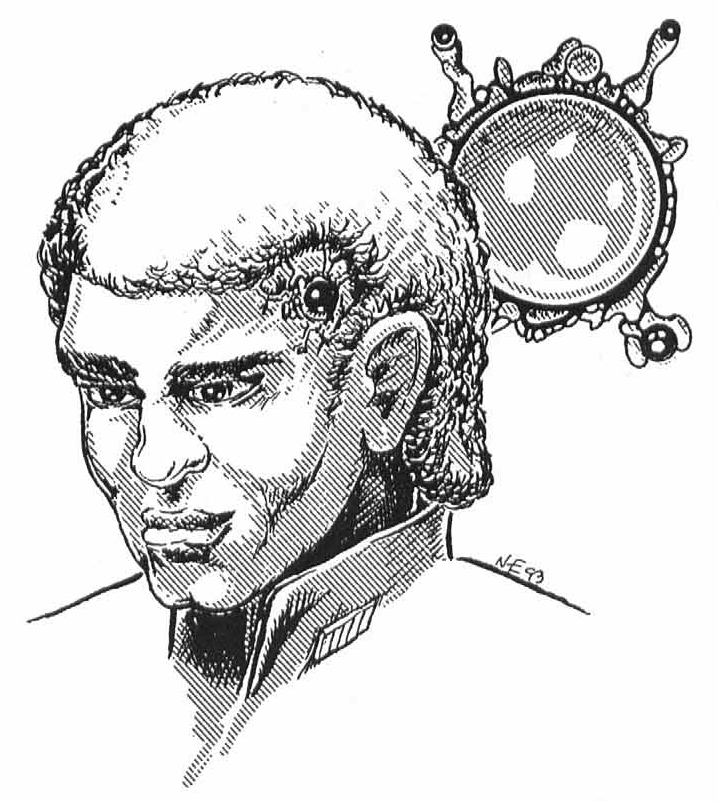
for some reason, this is the accompanying illustration
It grants ecstasy and a superpower chosen from a list by the maker, and each drink grants gradual mind control over the drinker though it doesn’t work on dragons of any kind. The super-powers listed are things like super-strength, flight, some of the converted Heroes Unlimited powers from the Conversion book, eyebeams, etc. Each dose lasts for two weeks and a power can’t be chosen more than twice for some reason. So we have shapeshifting tricky oriental dragons who like living with and influencing humans--but mostly for good! Except when they are evil and decide to brew their special mind-control drink, for which no stats or cost are given, it just says they can do it. I think the Camelot stuff later is dumb but these guys are just kind of random--though we’re far, far from done with random classes for this book. The Chiang-Ku are just extra-special. They are very clearly meant to be an important force in the Rifts universe, though they have to work in secret because :shh: they’re good guys. Mostly.
Children of the Earth aka druids who don’t call themselves druids
Original SA post Rifts:™ England Part 7: “Children of the Earth aka druids who don’t call themselves druids”
More OCCs/RCCs to come. First we get Children of the Earth and Stars which are often thought to be druids or elemental warlocks but are not actually. Instead they’re a weird inbred cult that teaches their children to master the power of the transformation of Earth or Stars respectively, and seems to be passed on by heredity, but others raised in the clan environments have also developed the transformations, though usually ‘late-blooming’, like nine or ten. Most regular children in the RCC (it lists it as an OCC as well, but then specifies later) learn by six. Because what you want to have is a six-year old who can throw mega-damage tantrums. Both of these clans are druidlike in that they go around helping people and believe that all beings with honor (ie not slavers/murderers/etc) must be treated with respect and love.
Child of Earth RCC

flayed terror look a free class bonus
An earthchild can draw on basically ‘ambient’ PPE to instantly transform into a 12-ft mega-damage stone form--or more precisely a stony veneer forms over the fleshy inside. They get 40 MDC per level and regen 40 per minute, resistance to faerie magic, poison, fire and cold, and supernatural strength. They can also ‘draw on the Earth’ to gain more capabilities but this makes them steadily get stupider each time they do it, until IQ drops below six and they go berserk for several minutes. Remember that most of these RCC-members can do this by age six. They also get some miscellany about sensing water and scaring animals, and they all get eight physical psionic powers. They wear brown or green clothing like everyone else in this book, and like to wear heavy body armor too, because they totally need it in addition to their natural transformation. It isn’t explained what happens if one of these guys transforms, takes damage, then untransforms--can they just change back and be instantly healed? I suppose the ‘regen per minute’ is supposed to cover this but it reads oddly.
Then there’s the Star Child OCC (this one’s an OCC for some reason) and has the same instant-change capability, but they turn into a shining beacon of light.
 They only get 20 MDC per level but are impervious to all ‘radiation’, which includes lasers for once. Fire and heat do half, but immunity to lasers is actually somewhat useful, at least until you meet a rail gun. At least they’re also harder to hit. They can also sense time and direction, see all spectrums, and shoot light blasts of their own--though these ‘only’ blind opponents with no save and are +6 to strike. They can emit soothing heat, float around at ‘speed factor 14’, and become a ‘shooting star’ that can travel at near-light speeds but is unable to remember where they were going most of the time, they get 3% per level to reach their destination. They also get eight psionic powers from sensitive or healing. They dress in white or light tan because if one isn’t wearing clothes with similar colors to one’s superpower, you’re doing it wrong. Both star and earth children get a selection of mundane gear and actually get weapons--it just says ‘weapons of choice’, which boy, is that abusable.
They only get 20 MDC per level but are impervious to all ‘radiation’, which includes lasers for once. Fire and heat do half, but immunity to lasers is actually somewhat useful, at least until you meet a rail gun. At least they’re also harder to hit. They can also sense time and direction, see all spectrums, and shoot light blasts of their own--though these ‘only’ blind opponents with no save and are +6 to strike. They can emit soothing heat, float around at ‘speed factor 14’, and become a ‘shooting star’ that can travel at near-light speeds but is unable to remember where they were going most of the time, they get 3% per level to reach their destination. They also get eight psionic powers from sensitive or healing. They dress in white or light tan because if one isn’t wearing clothes with similar colors to one’s superpower, you’re doing it wrong. Both star and earth children get a selection of mundane gear and actually get weapons--it just says ‘weapons of choice’, which boy, is that abusable.
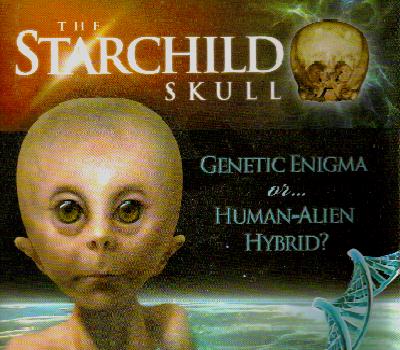
Both of these classes are pretty strong, though the Star Child probably wins out for being able to auto-blind people and still shoot them with ‘weapons of choice’, which the Earth Child transformation is not clear on but it seems to enclose all equipment, unless dropped ahead of time I suppose. They’re also both something I would expect to be painted on a Lisa Frank poster or something--well, weird Siembieda art aside, they’re extremely new age ‘in tune with earth and stars’ sort of stuff, though at least they don’t consider technology to be evil. Britain just doesn’t have any of it.
Still more random classes to go though. The next section is just labeled Intelligent Life Forms which seems to mean it’s focused on non-human classes. Okay.
First we get ‘Dabuggh’ RCC, whose description begins with “The Dabugghs are natural enemies of the sectle race” which is...described next. These are basically human-looking D-bees with various (randomized) insectlike traits and powers. And so they are named ‘Dabuggh’.
 And, like so many other races in the Rifts universe, they are aggressive and driven to enslave and conquer all other intelligent life. They are also apparently living in Britain in larger numbers than anyone suspects! It might be a trap! They can turn into a giant berserker bug form under stress and for some reason despite being aliens they transform into giant Earthlike insects or arachnids. You can also roll to determine how many additional insect powers the individual gets, and then there are several other tables of various features (mouth, exoskeleton, antennae, etc) one can have, but no table for choosing a table. Palladium missed a chance to include a percentile table.
And, like so many other races in the Rifts universe, they are aggressive and driven to enslave and conquer all other intelligent life. They are also apparently living in Britain in larger numbers than anyone suspects! It might be a trap! They can turn into a giant berserker bug form under stress and for some reason despite being aliens they transform into giant Earthlike insects or arachnids. You can also roll to determine how many additional insect powers the individual gets, and then there are several other tables of various features (mouth, exoskeleton, antennae, etc) one can have, but no table for choosing a table. Palladium missed a chance to include a percentile table.
 Some of the powers are pretty buff, like being able to spray 3d6MD acid at people, or 300 MDC natural body armor. Of course, a lot of them immediately preclude passing for human but who cares.
Some of the powers are pretty buff, like being able to spray 3d6MD acid at people, or 300 MDC natural body armor. Of course, a lot of them immediately preclude passing for human but who cares.
Then we have their mortal enemies, the Mantaz Sectle . These are just basically praying mantis people. No really, look.
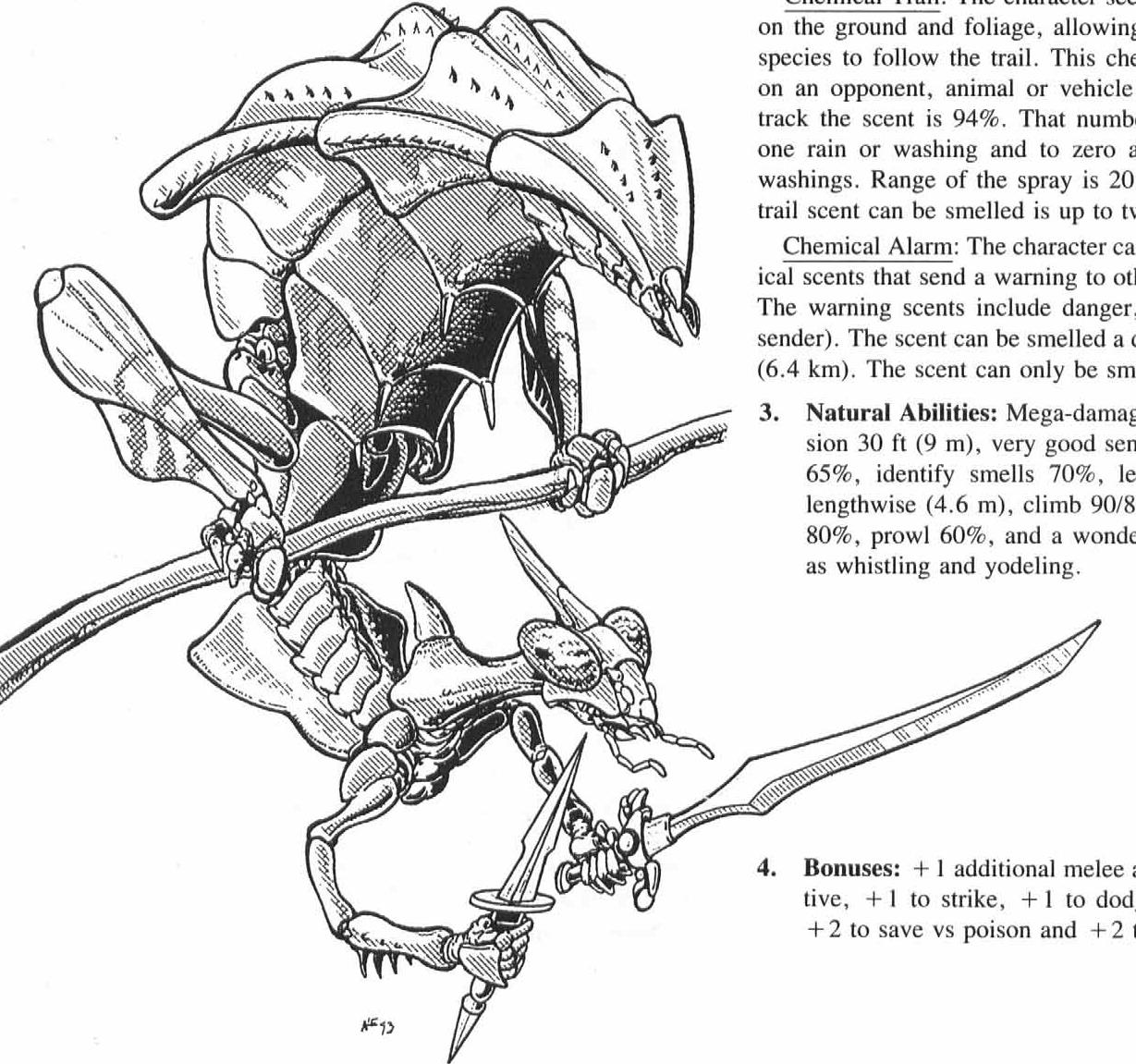
well, okay, chickadee mantis people
They mostly keep to themselves and don’t bother people, except Dabuggh, whom they hate. But because they are ugly, humans are often mean to them and nice to the Insectors up there. They get a few minor magical abilities and pretty good attributes, decent MDC. Really they’re just supposed to be a lesson in how not everything ugly is evil etc etc. There’s a note about other types of ‘sectle’ existing but only the Mantaz are on Earth. Enh.
Cernun Mystic RCC
AKA Ram-Horned Serpent Men
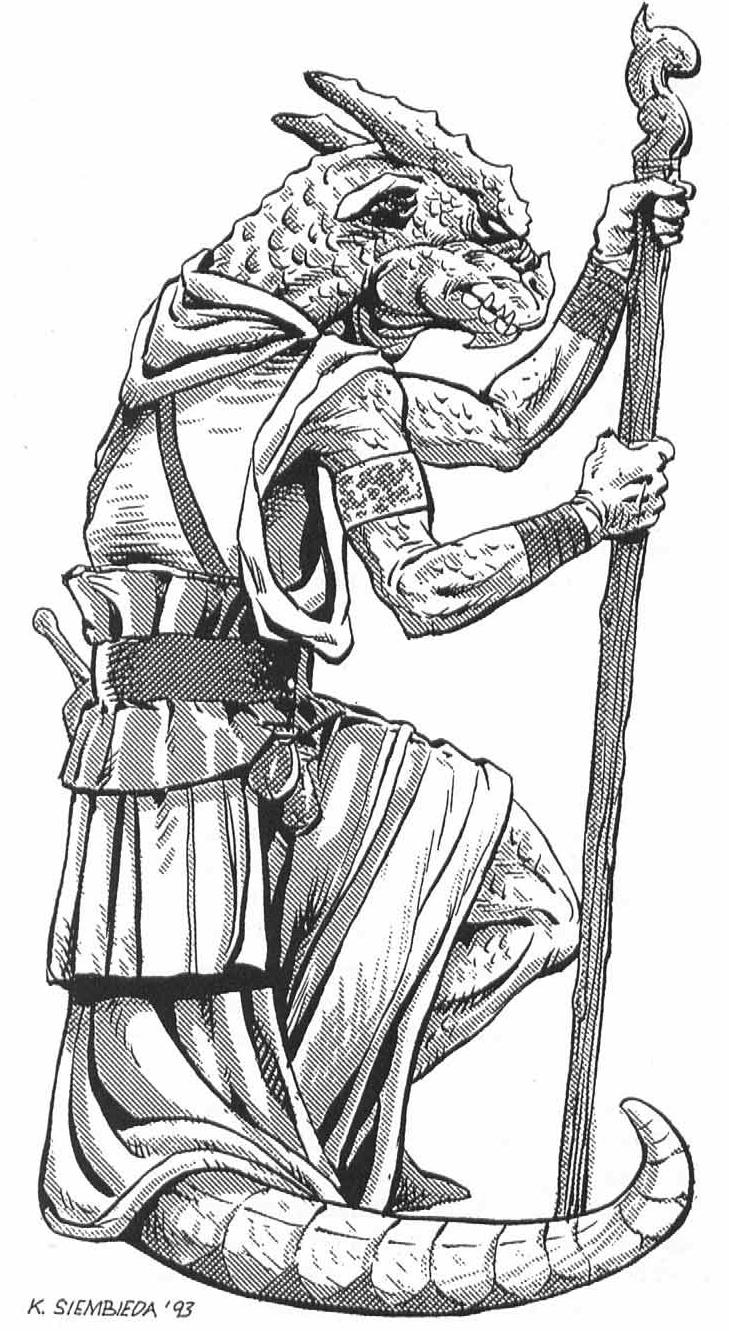
These are the lizard dudes like the one on the cover of the book. Apparently there was a ram-horned serpent theme in Celtic myth and these guys are probably the origin of that, like maybe Cernunnos, lord of animals, dun dun dun. It also explains that most of these guys are greedy and seek wealth, and the one on the cover is controlling a gigantes to attack some travelers.
The cernun all have the ability to control gigantes, the giant species listed back in Conversions. They can only completely mind control Gigantes with IQ 6 or lower (which is not uncommon, the race gets 2d6) but gives no statistics for chances to control smarter ones; maybe they just can’t. They can also regenerate lost limbs and other damage short of decapitation in a matter of days. They get powers equal to the Mystic OCC from the core in addition to that, are naturally mega-damage and get a magic wand or staff of choice. Basically, the Mystic was really one of the more boring options for mages in the core book, but that’s okay; here’s an upgraded version!
That’s it for ‘Intelligent races’ presented as optional player characters. Next we get into the monster section.
Aliens, Insects and Monsters
Original SA post Rifts:™ England Part 8: “Aliens, Insects and Monsters”
Since we had alien plants, it’s only fair to have some alien animals. These are something that players are more likely to encounter/interact with, given the life cycle of the typical murderhobo. ARB has pointed out that many of these creatures were ripped heavily from Nausicaa--which I guess those beetle things in that other book were too. I am unversed in this area so I’ll just assume that’s true and be unsurprised.
First we have the Armored Devil Fish
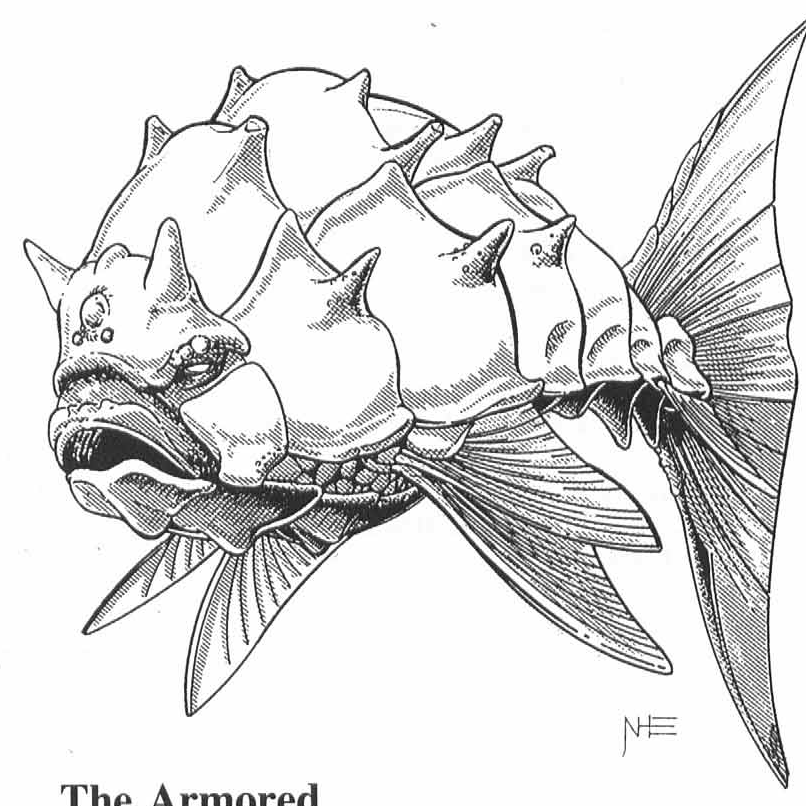
i actually like this picture, it’s Ewell at his most restrained. its major downside is just that it isn’t half as terrifying as the things that live in the actual ocean already.
“This is one of the many sea monsters that inhabit the waters around the British Isles.” I know there’s been some mention of how bodies of water are a bit more dangerous these days, but not a lot of attention has been given to that (Rifts: Underseas doesn’t have nearly enough sea monsters in it for my tastes either, IIRC, too many evil undersea civilizations) but it’s pretty tuff, with 650 MDC, 1D6x10 bites and 20-30 ft long. It’s also noted as edible and tasting delicious. Otherwise unremarkable. I don’t think they’ve introduced the rules about how lasers don’t work underwater yet in this book so at least you can ignore that noise.
Crawlies aka Hill Beetles
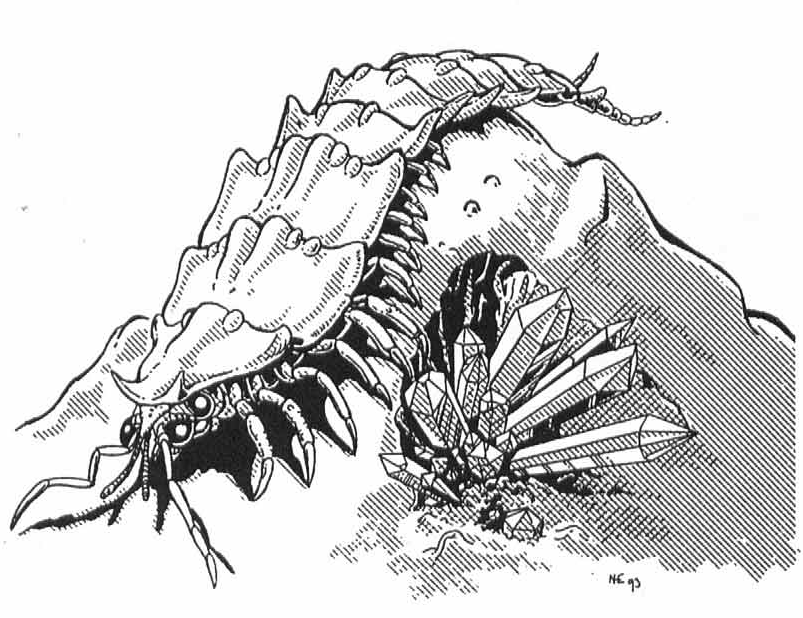
With a name like that I expect them to enjoy the finer points of banjo music and moonshine but no, they’re just extradimensional centipedes so not beetles at all. They’re basically non-aggressive carrion-eaters though they bother trappers by eating their catches, and they have enough MDC to be annoying to kill, especially since they can shoot a short-range chemical spray that causes -10 to strike, parry and dodge with no save. At least to things vulnerable to poison.
Giant Clamp-Mouth Dragonfly
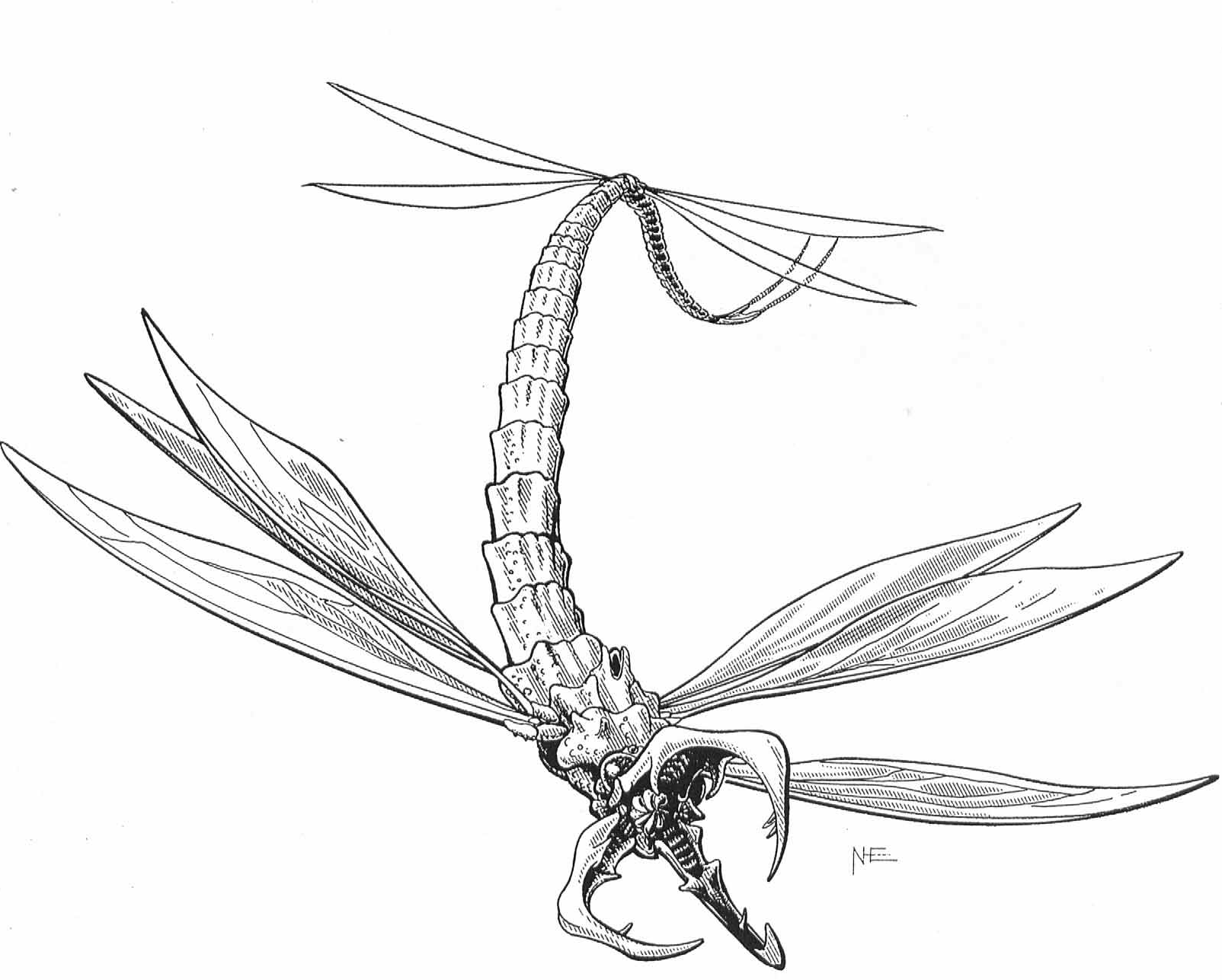
Giant, terrifying predators who eat only living prey and are attracted to PPE. The first paragraph reads like somebody saw a photo spread of insect mouthparts in a nature magazine and got really scared. Anyway, these things are hunted by the bold and daring to try and kill them by jumping into their backs and doing 65MDC to the rear head-plate so body armor can be made out of the rest of the shell-plates. You have to roll percentile under your PS number to hold on, none of this ‘Acrobatics’ or other physical skills actually helping you. There’s a bunch of
 about how hard they are to catch and really it seems like using the Crawlies to make armor would be easier, they’re much weaker and easier to pin down. Also: there are eight salvageable plates assuming one manages the trick, and each is worth 1200 credits. A complete set of armor has an amazing 65 MDC and costs 34,000 credits, giving the armorer a 300% markup over the PCs.
about how hard they are to catch and really it seems like using the Crawlies to make armor would be easier, they’re much weaker and easier to pin down. Also: there are eight salvageable plates assuming one manages the trick, and each is worth 1200 credits. A complete set of armor has an amazing 65 MDC and costs 34,000 credits, giving the armorer a 300% markup over the PCs.
Flash Beetle
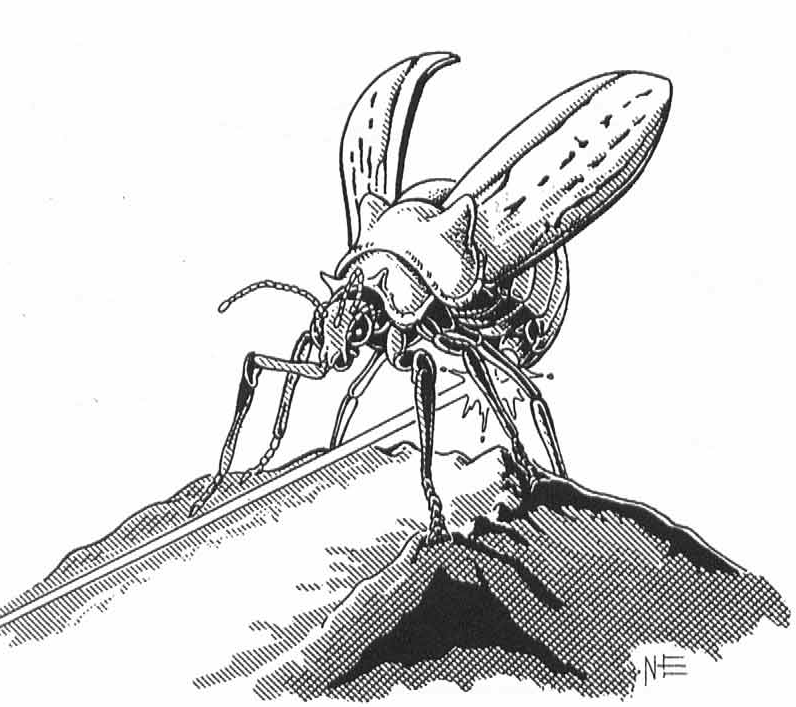
that’s either a laser or a dreadfully accurate stream of urine
Another alien bug attracted to PPE that eats living creatures. Its armor plates are ‘too brittle’ to be valuable for making anything, so these are basically just ammo-and MDC-drains for your PCs; the butt-laser only does 1D6 MD but they have 300 MDC. It also exudes a chemical that may attract more beetles or dragonflies above; really, these things aren’t that fast, it is probably better to just go do something else.
Petal Thing
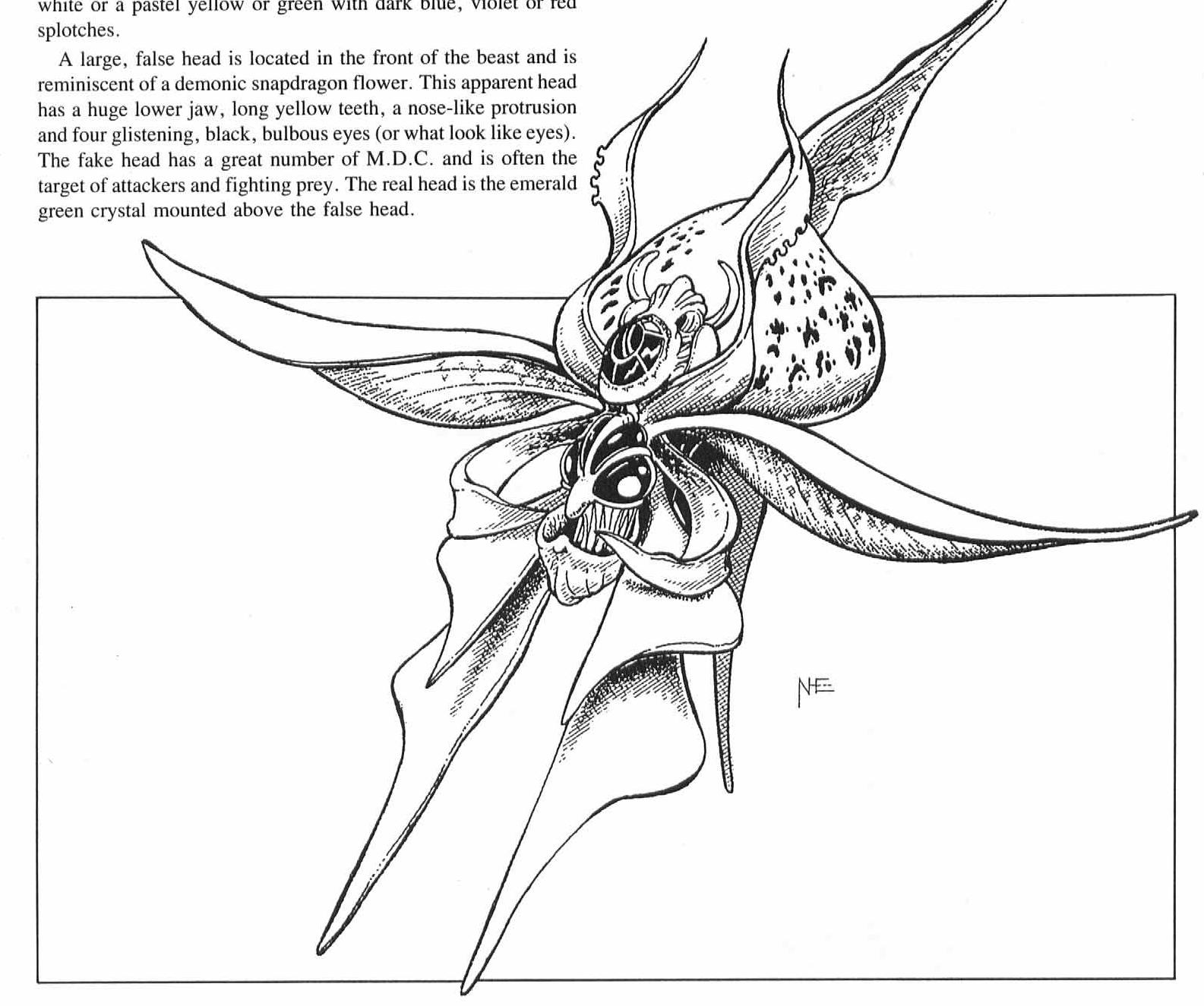
an evil flower in my hippie book?! how can this be!
This is a ‘horrible monster’ that is an alien nightmare that resembles both insect and plant. That main headlike structure is a ruse that has a bunch of MDC to draw fire. You should aim for the emerald. They’re white or pinkish and look really graceful, but they feed on PPE of living creatures and enjoy killing. Of course. It can also make a hypnotic attack that is again no save and makes a creature helpless to its initial attack, and it’s psionic. They don’t have that much MDC so killing one wouldn’t be super-hard assuming you do not aim for the head for once. It’s just not really worthwhile. Its body parts aren’t worth anything. Hunting is a really useless profession in Rifts: Earth, with all these monsters with brittle armor plates and useless organs and poisonous meat. It does mention on all these that Simvan Monster Riders might be able to talk up any of these various vicious insect predators.
Stone Ball Bug
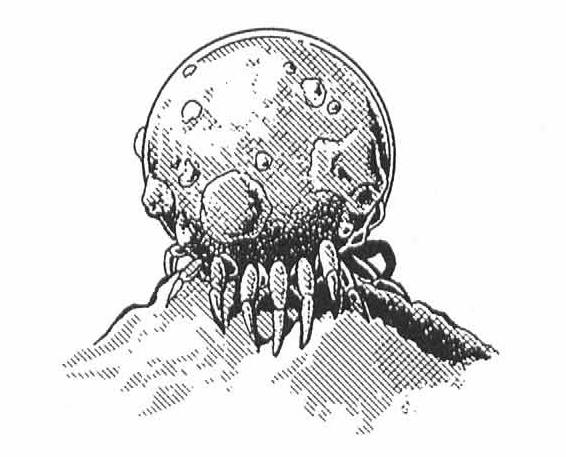
truth in advertising
These are harmless carrion eaters that pull their twelve legs into their ball-shell when threatened and wait for trouble to pass; country folk use them for games, or keep them around as refuse disposal. Herbalists can use their ground legs to make poison-curing potions. Not really worth much, though assuming these didn’t go all invasive species elsewhere they could actually be useful in other areas of the world.
That’s it for the random monster (insects) section. Next we move on to Temporal Magic, which is kind of cool but yet another puzzling inclusion in a book that has yet to give us substantial setting details about anything but giant trees and the dips who worship them.
Temporal Magic: Or, finally something that isn’t about herbs.
Original SA post Rifts:™ England Part 9: “Temporal Magic: Or, finally something that isn’t about herbs.”
Temporal Magic is magic that controls time and space. Fine, fine. There are three OCCs associated with this: The Temporal Wizard, the Temporal Warrior, and the Temporal Raider. Guess which one is a supernatural evil monster?
Anyway, the Temporal Wizard
Since there aren’t a lot of these guys, they have to learn (70% it says) from the demonic Raider, so of course they explain the Wizard and the Warrior first. They have to spend six years learning the magic and the ways of greed and villainy. There are also options to take longer periods of servitude and start at third or fifth level, if they agree to take steadily eviler alignments, and roll on an insanity table. Also they get extra bonuses for having put in all that time. They get an increased spell selection with longer servitude of course. All of them can sense rifts and teleport along ley lines like a walker.
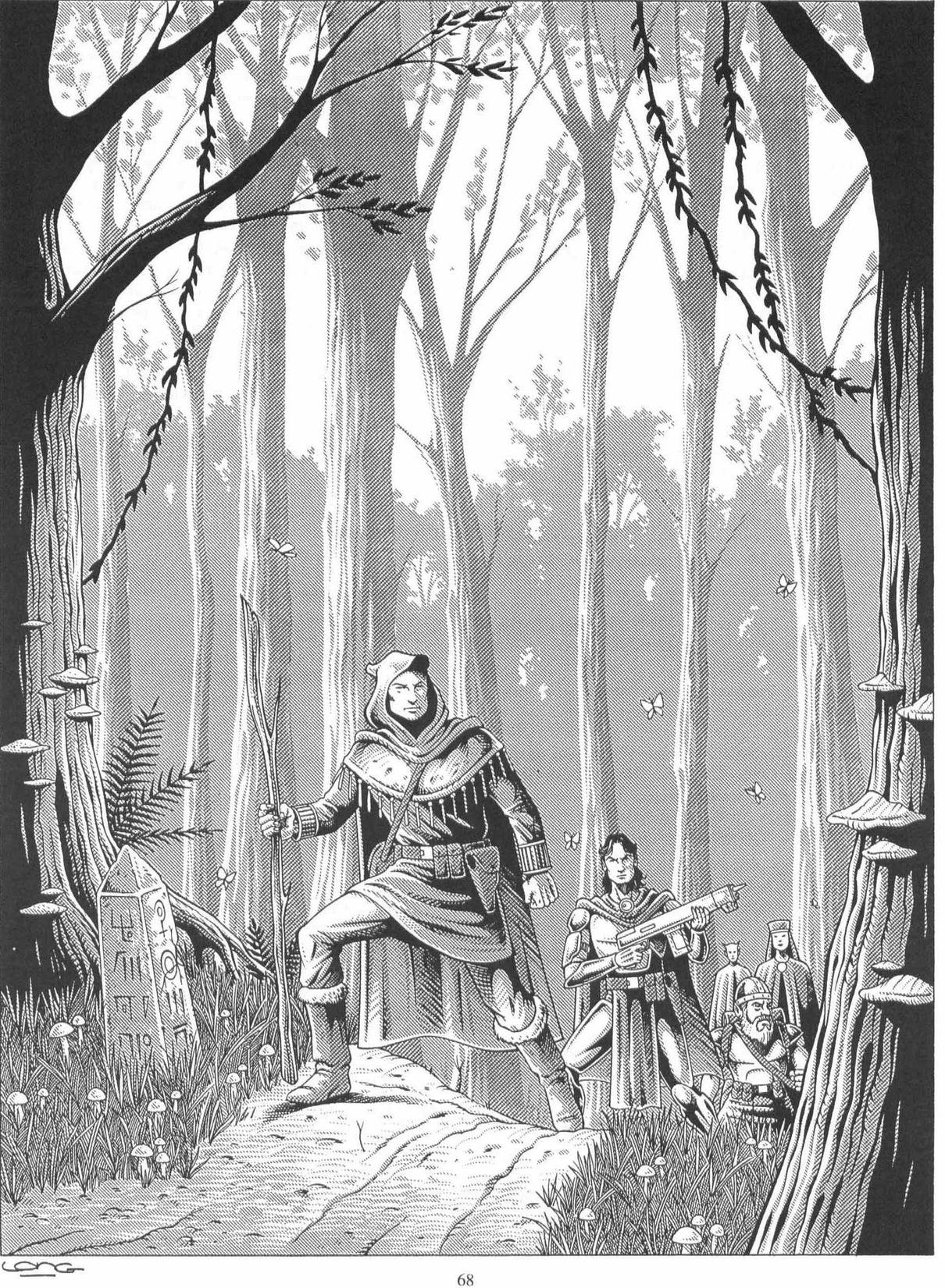
here, have a repeat of the inside front cover
They get some minor weaponry and gear and have a class uniform, like so many others, but avoid heavy armor because of the mobility and penalties and also it’s the only armor worth wearing. They start out with a fair bit of money after having worked with evil time-shifting demons for a while. Actual temporal magic spells are fairly powerful that I recall, but we’ll get to those in a bit.
Next, the Temporal Warrior
Basically a fighty (probably shooty) type who uses some basic temporal magic to be a better killer, also trained by a Raider with similar length of servitude/insanity problems. They get fewer spells but better combat options, including the sacred Acrobatics/Gymnastics combo. Basically, they are shooty guys who have the ability to store their guns in hammerspace and maybe a few other tricks. Not a bad class, overall, though I need to get to the actual spells section to remember how much better it is to have magic over the gun choices. Oh and they get ‘traditional’ armor that looks like a Temporal Raider, in case anybody was making any mistakes about them being good guys.
Temporal Raider : Here we have the source of all this time chicanery. Since there are no Hounds of Tindalos, nobody enforces linear time on anybody else and the trick is just knowing how to bend it. The Raiders appear to be a race that developed this capability, though since they can teach it, it’s not just a natural capability. They’re vicious predators who feed on life energy though they don’t need to kill to do so, they just often do it anyway to be dicks. They have a lot of the ley line walker powers, plus the ability to see characters transformed into fourth-dimensinal beings (this doesn’t come up a lot) and invisible alien intelligences, which does. They have natural energy blasts that inflict up to 5D6 MD and are used in place of regular attacks, with two ‘light’ blasts being one melee attack...which is pretty buff. The downside to all this is that they have to feed on the equivalent of 10 natural MDC per day--or 1000 SDC, but that’s a lot of humans per day. They can store some extra energy camel fat for those slow day but still need to eat. And on top of that, they are resistant to all forms of energy--all forms do half-damage. What the twinky fuck?
These are listed as optional RCCs but also suggested that maybe they aren’t great for that, yeah. Pretty strong natural MDC, plus they can wear armor, solid PPE, All temporal spells plus others, good combat bonuses. They have heat vision and stuff and can see ‘even when bathed in the blinding light of a sun’ which I guess means daylight? Good job on that, I guess. They are in a range where they would make pretty good recurring nemeses, they have listed treasure the PCs could try to claim though it’s hidden in various dimensional caches. They also have the usual ‘teleport away’ bullshit that plagues major Rifts villains, but that’s just an ongoing theme.
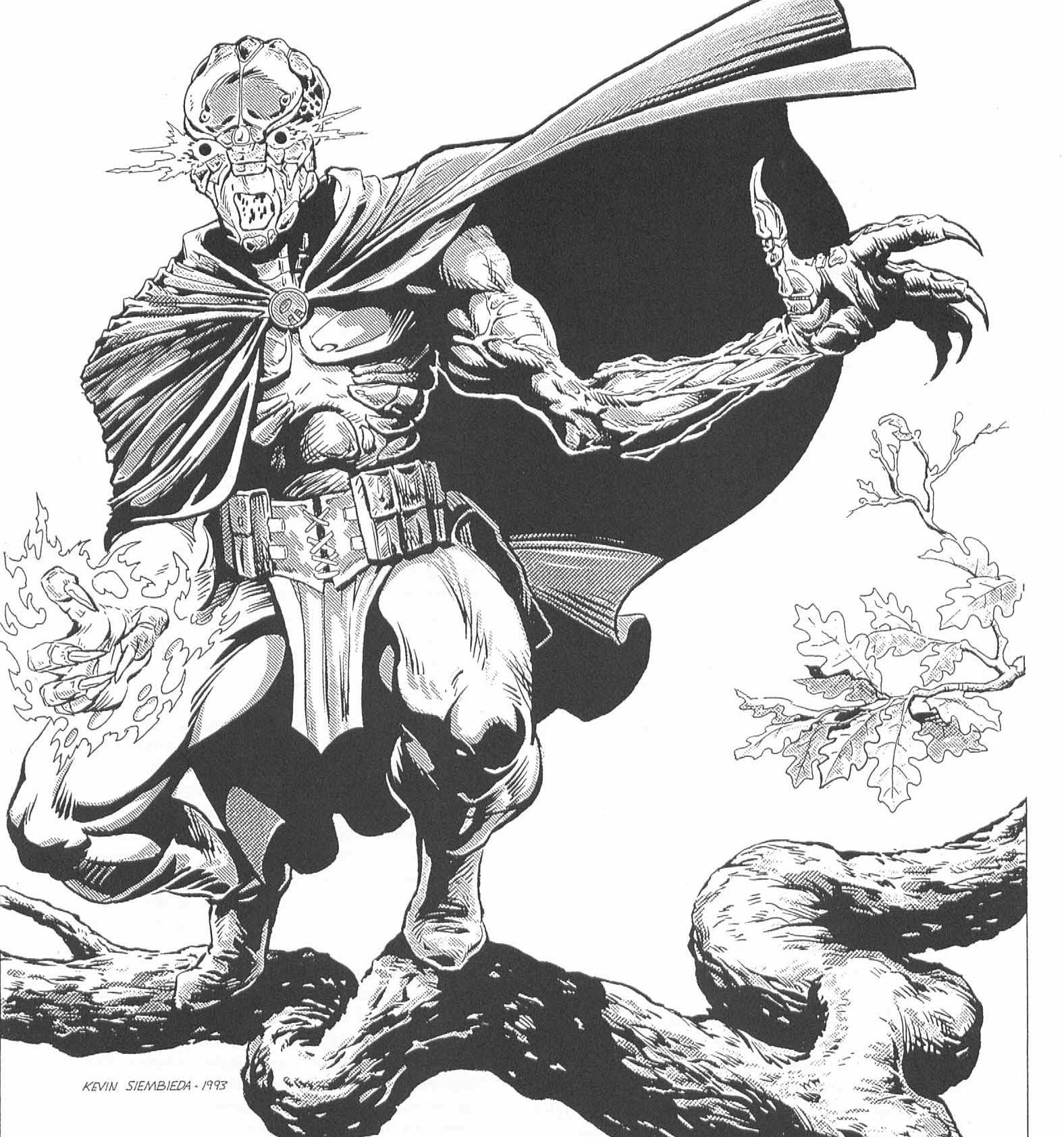
and since they’re in the England book, they have to be standing on a tree or something
Now we finally get to the actual Temporal Spells. I remember some of these at least being pretty good, and it seems they’re all considered to be between 7th-12th level on the regular magic scale. Let’s see how that shakes out. The spells are listed alphabetically in the book and later re-tabled by power, so we’ll go through them in that order, generally briefly.
A temporal caster can attune an object to an owner so no one else can use it for a full year, phase through solid matter with deleterious but non-fatal side effects for losing concentration, can turn into a non-interactive but visible hologram for whatever reason, can turn themselves two-dimensional (becoming invisible to thermo/heat/motion) and difficult to see in general.
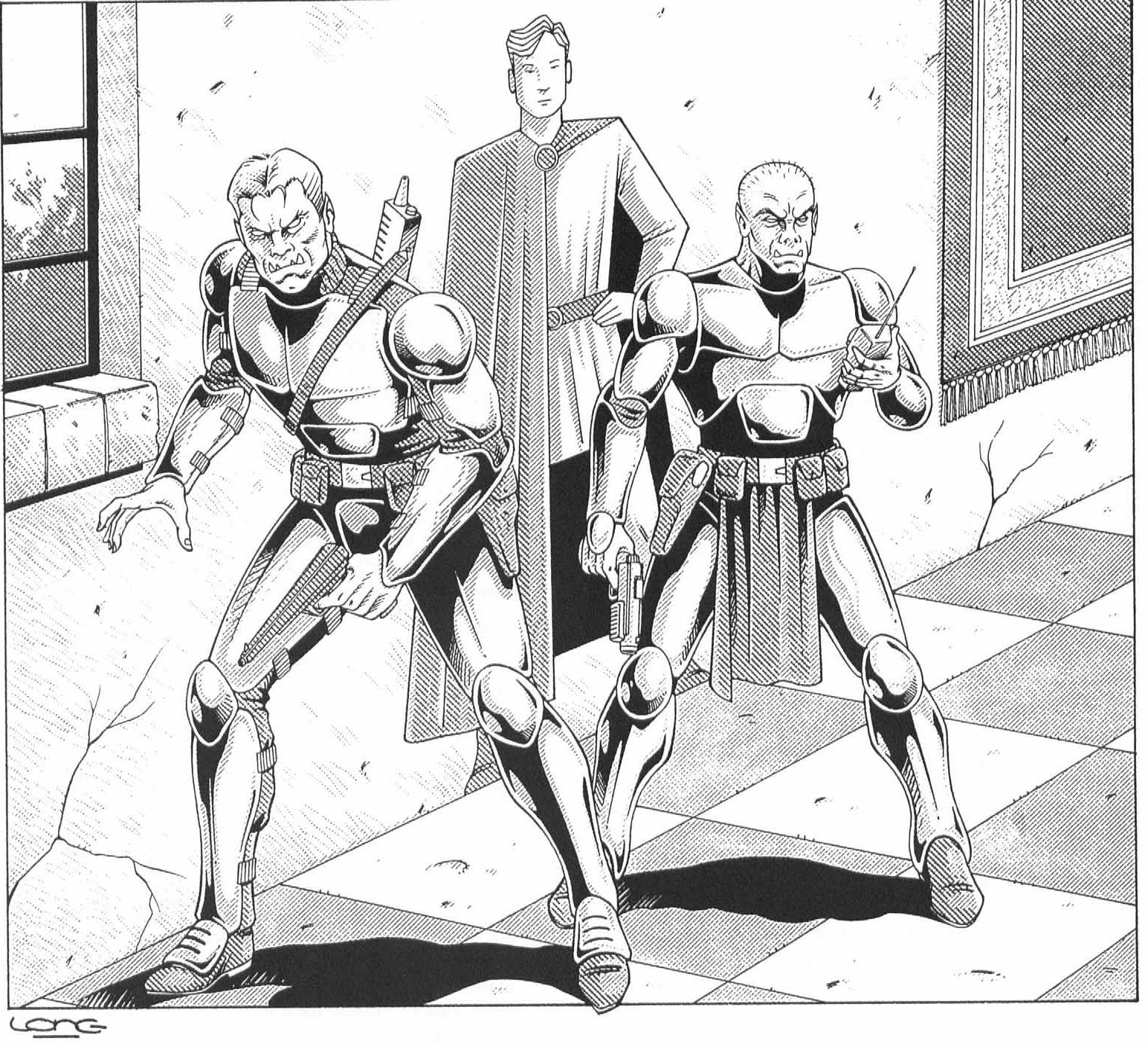
those dang graffitoes get more and more obnoxious, now where is that guy?!
They can make little dimensional envelopes in which they can store things; time passes at its normal rate and it has about two hours of air. The entry of the envelope is fixed, but it’s invisible. Only Temporal Raiders can see these automatically, Shifters might sense them. This tends to be where Temporal classes keep all their stuff, long-term ones can be made to last for decades. They can also make ‘pockets’ that are smaller, focused on a bag or literal ‘pocket’ so they can be portable. It stores about ‘30 lbs’ of stuff versus the walk-in closet of the envelope.
Ah, here we go, the ‘Fourth-Dimensional Transformation’. I think this comes up again in Pantheons of the Megaverse, as for some reason Ahura Mazda was a 4D being who was even weirder than the average weird or something. This spell turns the character into a ‘fourth-dimensional sub-creature’ and gains various capabilities that can sort of be summarized as ‘cosmic awareness’ and also 50 MDC. Also, you have an 85% chance of gaining a permanent insanity. This spell is useful but costs 350 MDC which is enough to make some of those 100K wands back in the fancy tree catalogue and lasts for one minute per level. Even Temporal Raiders appear to suffer from the effects of this spell, though they can see beings transformed into this state. Perhaps a hit of LSD would be better for feeling more cosmically connected?

There’s also Id Self which is a weird name for the spell, but it summons a duplicate from a parallel world and you roll on a random table to see how they’re different and it is extremely random. The longer they stay, the harder it is to send them back. Aside from the randomness this kind of thing has been the plot of a lot of good sci-fi stories so you could do some neat stuff, it’s just not likely to be useful for what it costs.
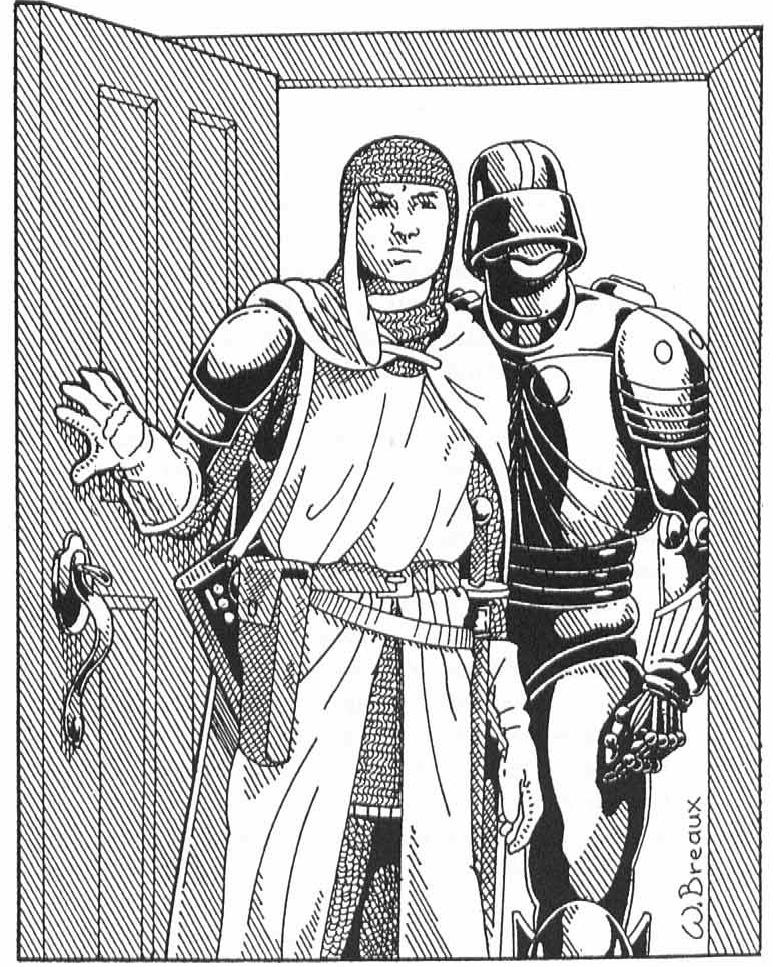
picture unrelated?
Anyway, on to some more spells. Remote Viewing for seeing far away, Retro-Viewing for seeing a few minutes/hours into the past, sensing anomalies, seeing anomalies (separate spells), putting things into stasis, sensory deprivation, temporal deprivation (weird), Temporary Time Hole which takes everyone in a 50ft radius into a pocket dimension, a time barrier spell that actually prevents a lot of these temporal magic spells from working and so might be able to trap some of those d-teleporting jerk villains in combination with the time hole, ‘time capsule’ which perfectly preserves items in an enchanted box, time maelstrom which disrupts others’ attempts at time travel. I am glad to see some spells that actually block various teleport-cheese that Rifts villains can use, though this would really only mess with a Temporal Raider rather than an ‘Alien Intelligence’ generally.
Next, various spells beginning with ‘time warp’, including a ‘send forward’ for self only with
 about how to avoid the temporal wizard getting too out of sync with the party, ‘slow motion’ which is basically haste but not too crazy on the bonii, ‘send’ to send small things forward in time, ‘space and time’ which allows fast-forward and unspecified teleport distance, unless it means ‘as teleportation, the core book spell’. I suppose it probably does. Lastly, ‘Wink-Out’ which is kind of a rope-trick spell.
about how to avoid the temporal wizard getting too out of sync with the party, ‘slow motion’ which is basically haste but not too crazy on the bonii, ‘send’ to send small things forward in time, ‘space and time’ which allows fast-forward and unspecified teleport distance, unless it means ‘as teleportation, the core book spell’. I suppose it probably does. Lastly, ‘Wink-Out’ which is kind of a rope-trick spell.
This is a relatively limited list of spells though some of them are quite useful. I don’t have the Core book handy to compare the spell costs against those of standard spells but they seem to be in a somewhat similar range, including the ones that will break the bank unless you do all that ritual magic-y stuff at a line nexus to build up extra PPE. My readings are somewhat brief, but while these spells are often useful, most of them do not seem to be immediately game-breaking--though I may not be thinking them through all the way. I played a T-Wizard in some game long ago, and don’t remember shattering the balance with it, though the ‘expanded level/evil/insane’ options are something I would probably disallow. At the end of the section there are some helpful indices and another really random illo I’m skipping.
The temporal classes in general are fairly useful--the Raider is listed as an ‘optional’ PC but if I were a GM using RAW Rifts I wouldn’t allow it, they’re very strong even for 1st level. Wizards and Warriors both get good abilities in the spells, and pretty good equipment selection, especially if you happen to own Triax or South America by the time you are reading this. I honestly like having a reasonably buff magic class, as some of the others were kind of anemic compared to anything using technology. Even all the druids earlier were not great adventuring classes though some of that depended on equipment selection.
My only real question is why are they in here? but that is always a question in Rifts books. The Chiang-Ku got a lot of writeup about where they are in the world and what the few remaining ones are doing, this is just ‘hey, new class!’ which is okay I guess. I just probably would have put them at the back, along with actually a lot of everything between here and Millennium trees.
Next: Dark Forces at New Camelot! Finally! They’ve been hinting at this for ages and it’s central to all the other plots in the book, godduh.
New Camelot, which they have only mentioned every other page and now bother explaining.
Original SA post Rifts:™ England Part 10: “New Camelot, which they have only mentioned every other page and now bother explaining.”
Now we’re getting into it! “It” being the setting details of ‘England’. The stuff we really needed to know earlier. But first, a visual aid.
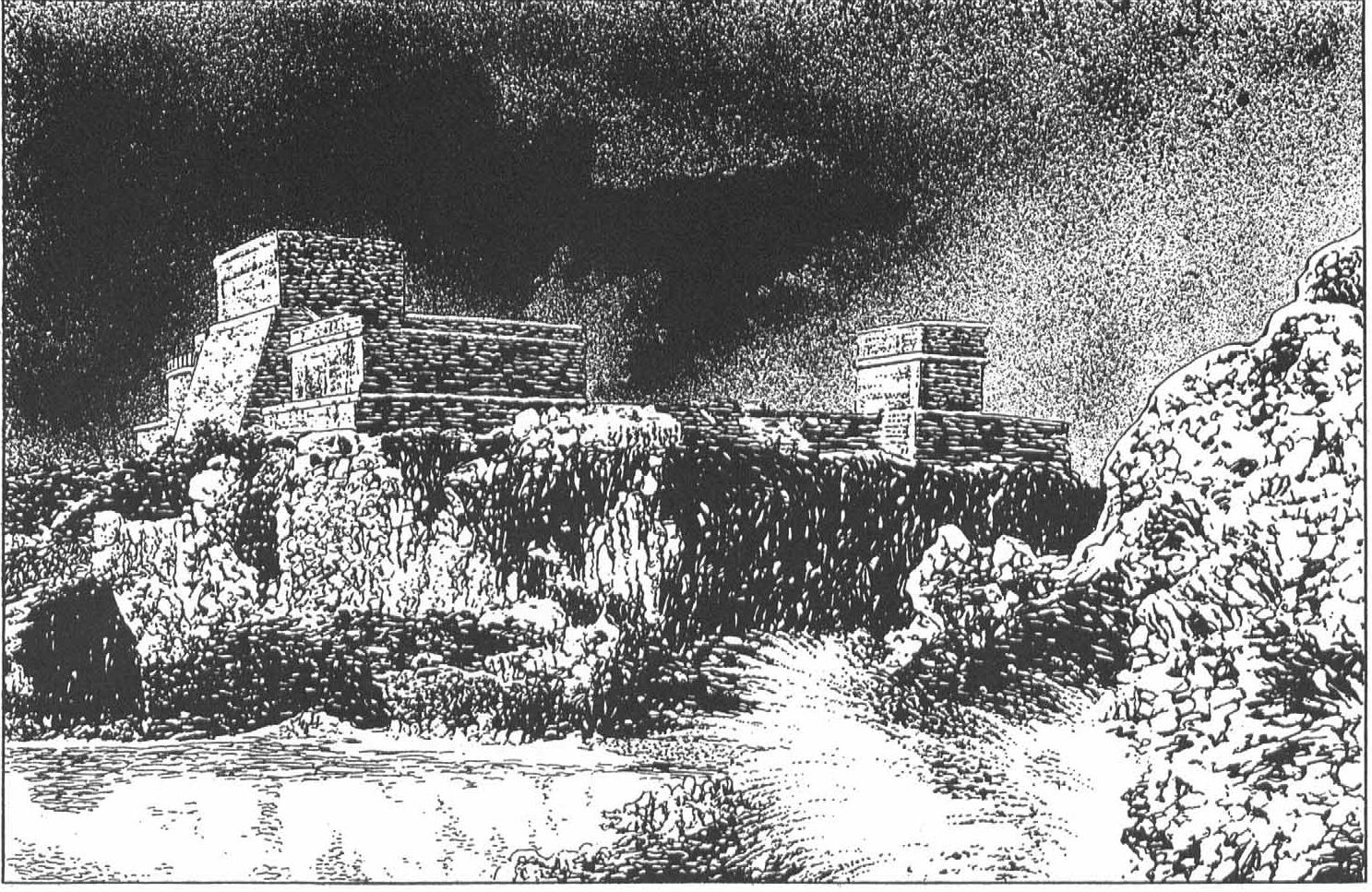
i can’t make out the artist’s sig on this one but i'm guessing Breaux. also: It’s in Mexico.
It’s time for Mrrlyn the Enchanter! The flavor text here says the stories refer to Merlin as “the spawn of a demon” and I am not going to bother to check that, because it goes on to use whatever context that was written in to be incredibly stupid. Mrrlyn is of course the same Merlin as the one in the past, he’s a fragment of an Alien Intelligence named Zazshan.

Zazshan straddles multiple dimensions as these intelligences are wont to do. This one belongs to a species called the ‘Zllyphan’ and they have the special specific ability to possess the recently dead with their fragmentary essences. We had a page and a half of rules for possession by ‘Intelligences’ in the Conversion book, and now we are likely to have yet more. Anyway magic energy didn’t fade in Britain as fast as it did everywhere else because Britain is ~magical~ and ‘Merlin’ could start scheming. He built up Camelot as a front for a world-domination plot. Then the energy did fade and the shard got stuck. Fast forward a few thousand years to the time of Rifts.
He found a dopey front man and started up another Camelot and sent several other essence shards to pretend to be creatures of myth or knights or at least beautiful women to cement his hold--The Lady of the Lake, the Supreme Nexus Knights, and Guinevere (she didn’t get a funky spelling for some reason) are all pieces of the same alien god. There are a lot of
 which may be summarized as one of those old newsreels where the nazi empire spreads in the form of giant arrows over a map if we don’t do something before it’s too late. Fortunately, The Zllyphan and Splugorth hate each other. Amazing, evil factions that are actually rivals.
which may be summarized as one of those old newsreels where the nazi empire spreads in the form of giant arrows over a map if we don’t do something before it’s too late. Fortunately, The Zllyphan and Splugorth hate each other. Amazing, evil factions that are actually rivals.
Zazshan gets a stat block and it’s as tough and fuck-you annoying as these evil gods tend to be, including being immune to “cold, heat, fire” but “supernatural beings” inflict full damage in the vulnerabilities section. Augh. There’s also stats for generating more Zllyphan if you somehow felt the urge. Therere is something important missing however, which is the rules for possessing the dead. Zazshan’s block says ‘see Important Notes . There is no Important Notes . The general Zyllphan statblock lists natural abilities as ‘see Zazshan’. Mrrlyn and the other essences’ blocks say ‘See Zyllphan’. Nowhere does it list the rules for possession, like how long the being has to be dead, or what. Reducing the MDC to 0 destroys the body and can force the energy being out, but it doesn’t say what’s required for it to get in, other than that it must find a body within 24 hours.

Mrrlyn’s statblock is considerably weaker with only 2000 MDC but can still dimensional teleport its essence back home at 98% success. He counts as 7th level...something and has a bunch of magic and psionics and several temporal magic spells. He and all the other essences use the Alter Aura power to appear good and human. It also mentions he has a secret lair protected by rune statues where half his money is stored.
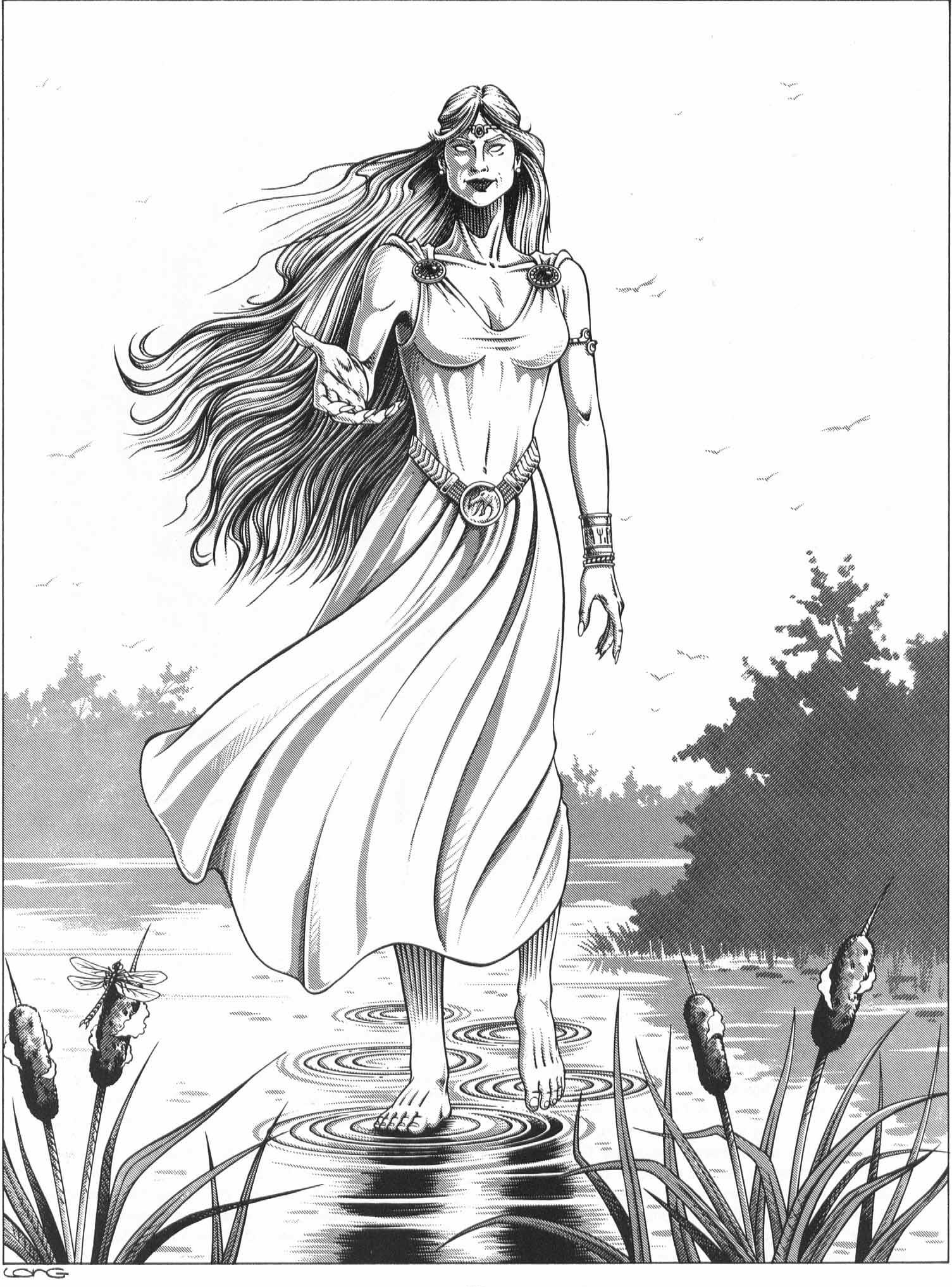
totally non-sinister jesus-lady
The Lady of the Lake is much like Mrrlyn in every way except that she has given ‘King Arr’thuu’ the sword ‘Caliber-X’.
 I mean I know this section was in some kind of stupid names contest apparently but come on.
I mean I know this section was in some kind of stupid names contest apparently but come on.
Then there’s Lady Guinevere. I hope we’ll get to how the feudal organization of Camelot actually works soon but more importantly, she is the shard of Zazshan that is boning Arr’thuu. She pretends to be a prissy noblewoman in love with the King. She also pretends to study magic with Mrrlyn.
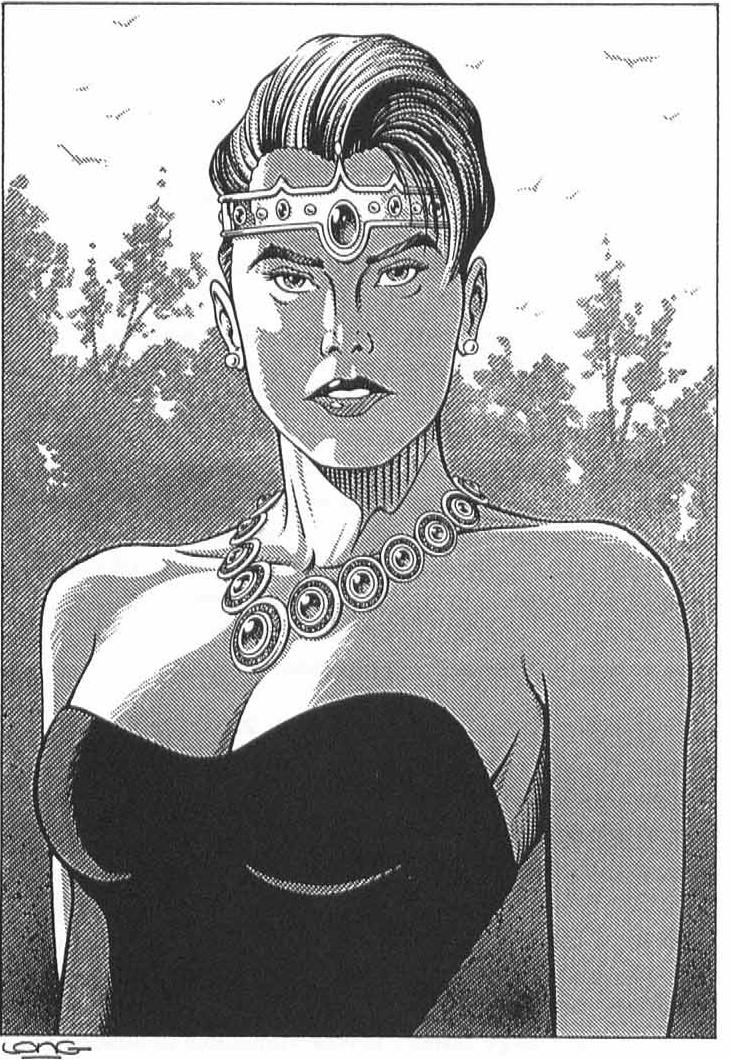
And then there’re the Supreme Nexus Knights “aka SN-Knights”, which I will use because I am already tired of typing that too. These are lesser life essences of Zazshan. They are not official Knights of Camelot or something and only work for Mrrlyn. Certainly, in a military dictatorship (which Camelot is), a highly-placed advisor having his own private army is not at all suspicious! There are lesser, human or humanoid Nexus Knights as well. They go around like secret police and refuse to answer to anyone but Mrrlyn or (sort of) Arr’thuu. They all have an ‘M’ on their armor and on their shield, “along with Mrrlyn’s demon crest.” It’s like he’s not even trying to be subtle. They have horned helmets and flaming swords. They have 180 MDC plus 100 MDC armor and if the body is destroyed, the lesser life essence is just immediately hurled home--no chance to destroy it--though it can’t return for 2D6 months. I recall there being some upper limit to how many of these can be created, so that could be some kind of a limitation but mostly it’s annoying.
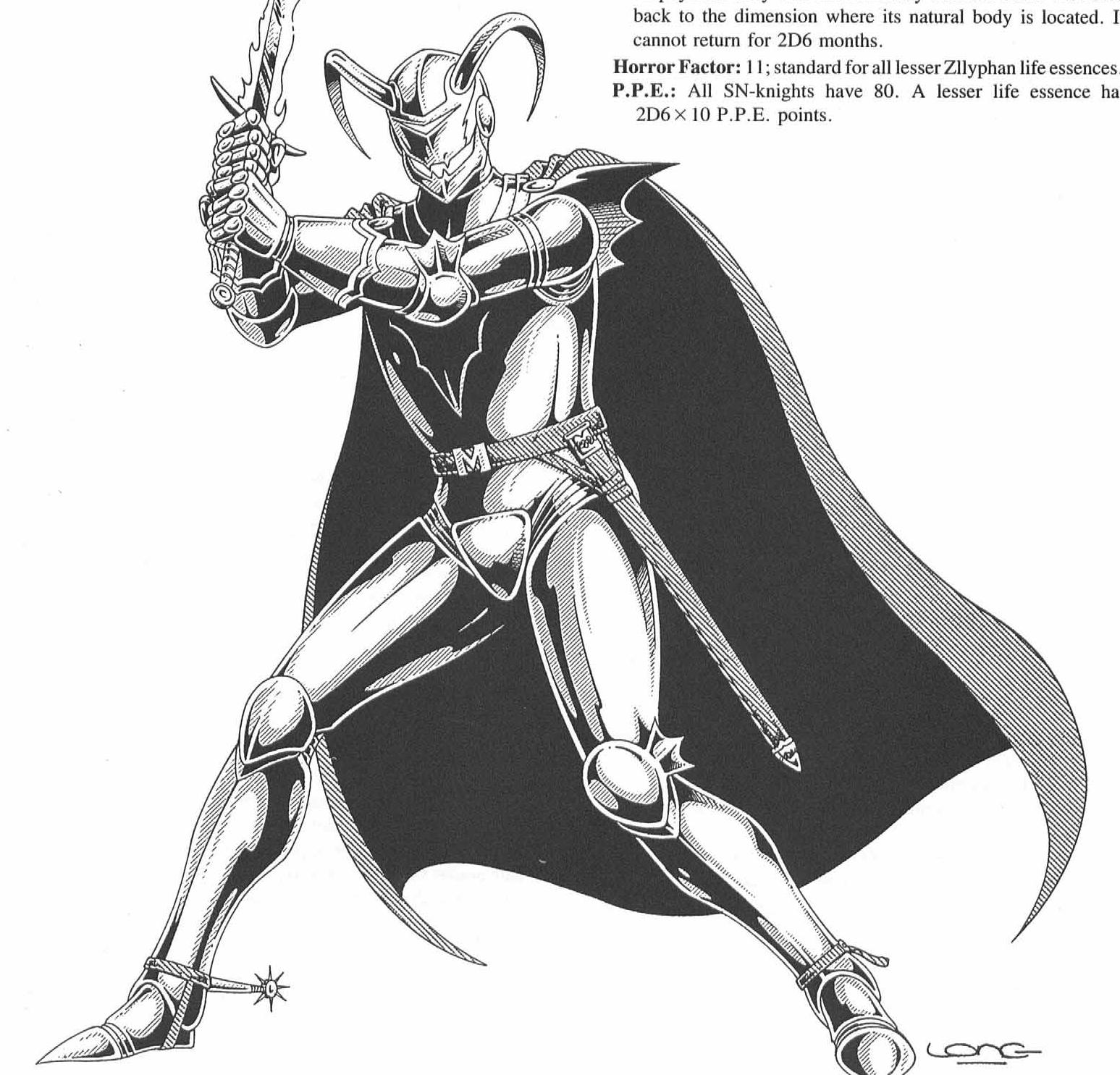
i mean really
The Nexus Knight OCC is described later; this ends the section about shards of Zazshan. This is one of the stupidest writeups of any version of the Arthurian myth I have ever seen and I thought this when I was a teenager. The next section is the “Champions of Camelot” and it looks like a lot of
 and also more about Nexus Knights, because that is what the people came here to see right?
and also more about Nexus Knights, because that is what the people came here to see right?
Champions of Camelot, now with more Nexus Knights
Original SA post Rifts:™ England Part 11: “Champions of Camelot, now with more Nexus Knights”
So now we get to the section about the Knights of Camelot who are not secret police, are treated like heroes, given discounts (“20% to 50%”) and otherwise pampered like small-town quarterbacks.
 They also get petitioned for help all the time and tough guys gonna try ‘em. Some are more respected than others, and some, like the specifically named “Sir Dred,” may be considered nettlesome troublemakers. Sir Dred?
They also get petitioned for help all the time and tough guys gonna try ‘em. Some are more respected than others, and some, like the specifically named “Sir Dred,” may be considered nettlesome troublemakers. Sir Dred?
 This is all part of Mrrlyn’s clever plan of course and he has staged several of their key victories to make sure they get extra famous.
This is all part of Mrrlyn’s clever plan of course and he has staged several of their key victories to make sure they get extra famous.
To be an official Knight of Camelot requires several feats of incredible heroics and living by the Code of Chivalry detailed below, there’s only a few hundred of them, most of them are fighters, and only 12% are women.
 When a Knight is becomes “official” (their quotes). Mrrlyn gives them a new knight-name, generally either directly or partially from the original Knights of the Round; the book includes a short list of names not already used, including ‘Egglame’.
When a Knight is becomes “official” (their quotes). Mrrlyn gives them a new knight-name, generally either directly or partially from the original Knights of the Round; the book includes a short list of names not already used, including ‘Egglame’.
The Code of Chivalry is “very similar to that of the cyber-knights, however, it is important to understand that the cyber-knights are unique to the Americas.” Well that’s kind of a let-down, they’d seem like a natural fit.
W’ev, on with the Code business. Serve the Crown and Country, live with honor and justice, don’t attack an unarmed foe--awesome, can’t shoot guns out of peoples’ hands anymore. “Never use a weapon on an opponent not equal to the attack.” This kind of excludes Glitter Boys from knighthood. “Never charge an unhorsed opponent.” Now that’s just dumb. “Never attack from behind.” I suppose that this is indeed honorable but given the incredible danger and immense power of some of the evil forces at play, some of these restrictions are really not practical. Also old chivalric codes were kind of written for knights against other knights, not peasants, or you know, monsters, to the extent that they were ever really followed at all.
Anyway there’s several more bits about obeying laws, respecting women (specifically, twice) and being merciful and all that sort of thing--it’s very much a Victorian romantic conception of Chivalry, which is fine, since the Court of Arr’thuu is an alien plot based on a made-up romanticization of an alien plot according to this book. There’s a note at the end that not all of these rules get totally strict adherence, especially when dealing with supernatural foes, so that’s at least some understanding of how impossible those rules are to obey.

the idea of a good mech pilot earning a knighthood is cool to me, but i am not sure how the ‘unhorsed’ rule applies here, or which weapon it could use that ‘is not equal to the attack’ in some cases. also triax and coalition markings are hard to tell apart.
From the Code we go on to details of Camelot’s military. Now, it has stated that “Official” knights of Camelot are treated kind of like celebrities but not what, if any “official” powers they get, or if they’re paid, or whatever. Getting into these troop listings, we see that there are 258 total Nexus Knights, 80 of which are “Ghost Knights” (explained shortly), 50 ‘Supremes’ (the shard ones) and 128 human. Then we get into ‘Other Troops’ (3500 total) which seems an odd heading for what should be “Actual Military Forces.” These mention “Knights of Nobility” so there is presumably some level of actual feudal stuff going on, along with “Rival Cavaliers,” whatever those are. This section is making me crazy, we really need to know more about New Camelot before they explain its army. They don’t even explain the army, it’s just this brief heading with force listings. Argh!
Instead of going on to talk about New Camelot or give a statblock for Arr’thuu or any of the Champions of Camelot promised by this section, we instead go straight to Ghost Knights. These are a type of Nexus Knight that is actually a tectonic entity (see Conversion) animating a suit of armor. Mrrlyn can apparently control these as long as they are on British soil which is why nobody has noticed that a large number of the secret police are g-g-g-ghosts I guess.

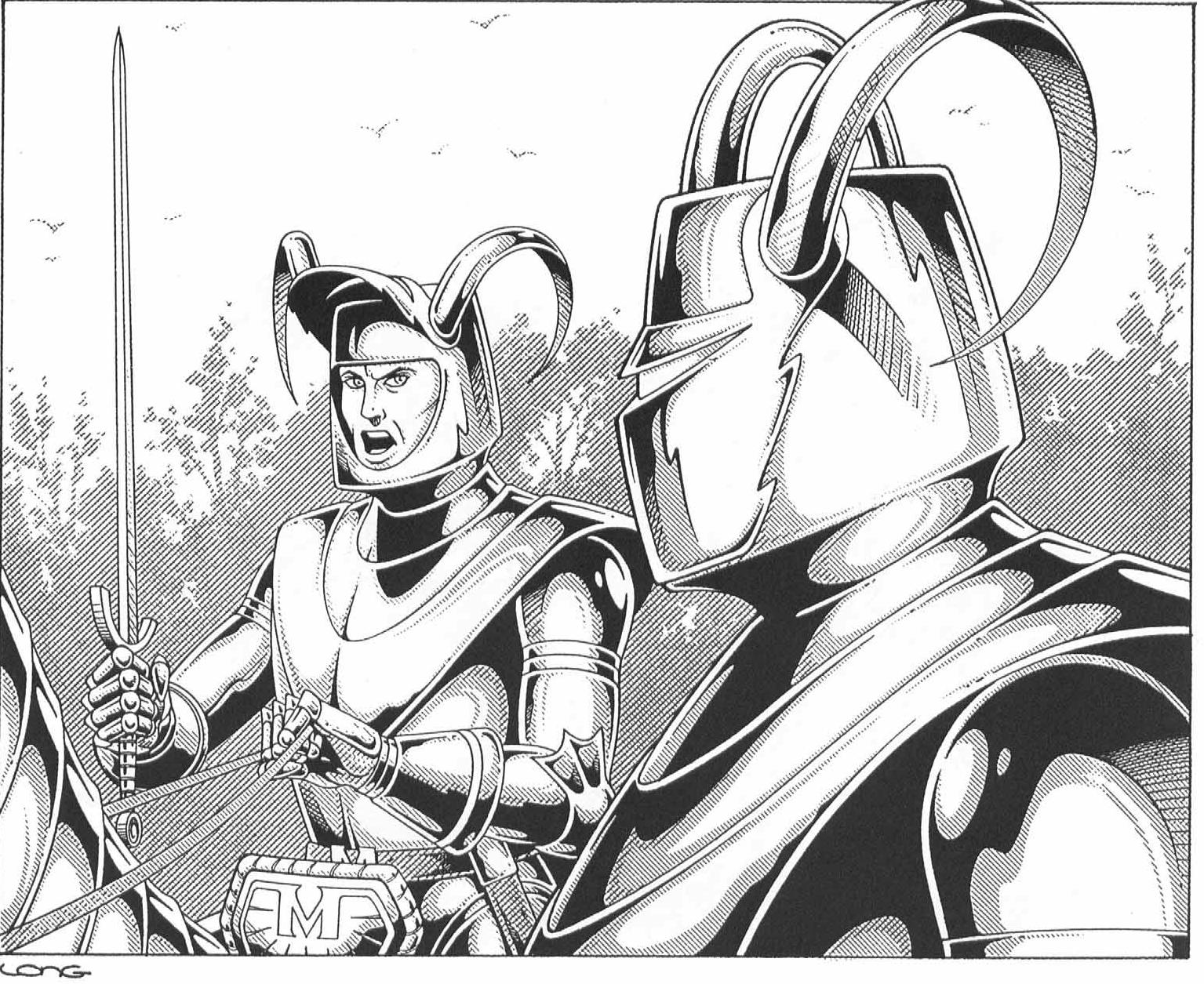
i’m including this picture because it is one of several the Nexus Knights get, compared with all the other ‘Knights the PCs will want to be’ that follow.
The Nexus Knight is detailed here, and you can’t play a secret traitor knight, you have to be loyal. Their actual OCC varies but is generally some kind of ‘man at arms’ type. They get some neat (well, as neat as Techno-Wizard stuff gets) devices and equipment, and of course the ability to travel unchallenged and make arbitrary arrests and the like.
The Knights of Nobility get a little blurb to follow. They’re “A men’s club exclusive to humans, human-looking d-bees, and elves.” Wonderful. Wealth, lineage, and arrogance seem to be the requirements, though it’s hard to have too much lineage in Rifts Earth. This is basically a Knight-Fraternity that likes to party and gossip. They’re lead by a ‘Lord Chairing’ who is a right bastard though not actively evil. Just mean.
The Rival Cavaliers are the group the PCs will probably actually want to join or at least hang out with, being a “rowdy band of adventurers.” Apparently the founders of the group have proven themselves a hundred times over but have never been elevated to true KoC status because of politics, looking too inhuman or ‘too undignified’ (gay? I have no idea what this means) to fit the image of the KoC. But that’s okay, they laugh and joke about it all the time and are not filled with simmering resentment of class- and speciesism.

The Rival Cavaliers are also specifically listed as “men and women” versus the others which are listed as “men” in the case of Nexus Knights though that isn’t made a specific requirement, and the Knights of Nobility which are a “men’s club” so presumably that is a requirement. They hang out with poor people and require a sense of humor and disregard for convention. This is sounding like the plot of Animal House but, you know, with plasma lances. There are stat-blocks given for a few notable members (“Pretty-Boy,” an elf bowman, “Silver Mane,” a wolfen headhunter, and “Kreb-lyrc the Gentle One,” an adult dragon (!)
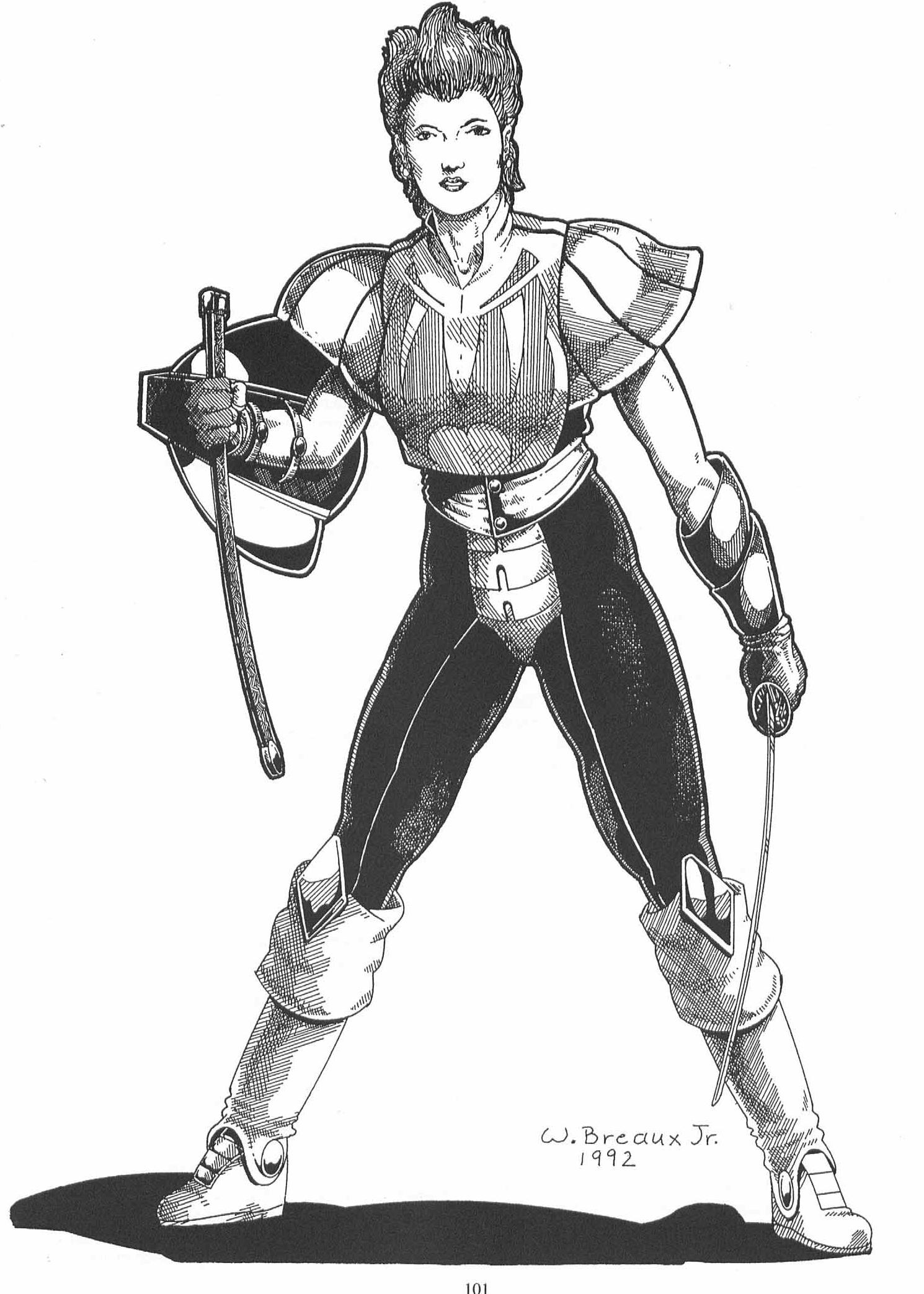
i think this is supposed to be a picture of that dragon NPC in human form but I have no idea what the katana is about
Alright then, next we get to a Knight OCC. The text here proceeds to explain that
”Rifts™: England” posted:
The Knights of Rifts Earth are a little different than the knights of old. In ancient times, most knights were members of nobility -- landowners, kings, dukes, lords, and those of royal/noble lineage. Most were educated and wealthy.
Okay, a lot of that is wrong but let’s keep going:
”Rifts™: England” posted:
The knights of Rifts Earth are more like the Musketeers of old, men and women, humans and D-bee, trained in the ways of combat and the use of weapons, united by a common dedication to life, freedom, country and the codes of chivalry.

The Knight OCC wanders the land protecting the innocent in a world filled with cruelty. Okay, okay, sure. To become a Knight one usually becomes a squire, though “Some kingdoms” or groups of knights offers schools, or one can self-teach by trying to live up to storybooks. They wear MDC armor that is designed to look like medieval plate. Becoming a “Knight” in this sense seems to be a self-declared or community-approved thing rather than a civic title with responsibilities about maintaining two battle-ready horses and armor and and obligation of service, and the NGR is getting concerned about them because they’re all just a bunch of vigilantes. Also knights who manage to be ‘knights’ and then forsake chivalry are Black Knights and everyone hates them. This is making my brain hurt.
The class itself is kind of a standard ‘man-at-arms’ class and the equipment is highly variable--they tend to have 1d4 stakes and mallet, but otherwise their weapons can vary tremendously--magic weapons can include “rune weapons (!), magic wands and staves, bio-wizardry (which they got from Atlantis somehow), techno-wizard devices, talismans and similar” or even modern weapons and explosives or, you know, whatever.
The common thread is that they traditionally wear that MDC plate-styled armor which has 60-100 MDC and look like whatever kind of plate really, and maybe have a detachable jet pack. Or just wear power armor. Or big floppy hats with feathers capes and stuff, and hope they can withstand plasma fire. Really this class is super-vague, and as with many man-at-arms classes, the equipment makes all the difference in the effectiveness of the character. Likewise their vehicles vary from regular horses to one of several promised designs of Triax robo-horses, or just ATVs or jetpacks. 15% may ride an exotic animal like a pegasus but really there’s no other table or way to determine what you get--it seems like you just call yourself a Knight and you’re on the job. They can even choose two cybernetic (not bionic) implants if they desire.

This class is differentiated from the Royal Knight that follows it, and these are apparently actual children of nobility and wealth who still manage not to be dicks and try to use their power for good. They can be “kings, princes, lords and sons of the wealthy.” And maybe daughters but let’s not get too crazy--the major problem here is that we don’t know anything about any “kingdoms” that may be producing these individuals, not even New Camelot as yet. They get some better equipment and more money than the regular Knight and suggests that artificial enhancements are common among knights, “especially those from the New German Republic.” They have hereditary nobility? I assume it probably means children of plutocrats in that case but it’s still weird. Wait. No. A cyber-Habsburg! My next character is done.
The last bit I’ll cover here is an optional background table for knights. This seems to be a table mostly intended either to keep people from playing Royal Knights, or just space-filler, but it does specifically mention “Son of nobility (women are dissuaded from such manly pursuits)” because
 I guess, and various ‘son or daughter of some lowly profession/species that wishes to rise above their origins’. This does offer a few interesting suggestions for someone trying to think of a good distinguishing background for a ‘Knight’ character besides ‘Batman’ though it was clearly written and shoved in as an afterthought.
I guess, and various ‘son or daughter of some lowly profession/species that wishes to rise above their origins’. This does offer a few interesting suggestions for someone trying to think of a good distinguishing background for a ‘Knight’ character besides ‘Batman’ though it was clearly written and shoved in as an afterthought.
And I’ll stop there. This one got long, but it’s a lot of words, randomly jumbled together. Next we get to statblocks for Arr’thuu and some of the actual Knights of Camelot and then in like six pages, New Camelot itself.
Actual New Camelot, no for reals this time
Original SA post Rifts:™ England Part 12: “Actual New Camelot, no for reals this time”
So now, some statblocks for actual Knights of Camelot. We start with King Arr’thuu of course. I am still astonished each time I type that spelling that somebody thought it was cool. He is a charismatic 22 year old who took the throne at 16 after being groomed by Mrrlyn. He “replaced King Ebor after the good king and his two sons were ambushed and slain by demons on a trip to a neighboring kingdom.” Firstly, I thought Mrrlyn created New Camelot, and secondly, this book seems to assume a network of medieval-styled feudal fiefdoms it has not gone to any lengths to explain. Rifts Core did note that a lot of settlements are ruled by petty warlords and such but they didn’t go around styling themselves knights. I guess that wouldn’t be Amurrican.

Anyway Arr’thuu has a tendency to recklessly throw himself into battle and Mrrlyn can’t talk him into hanging back. He is best friends with Prrcyvel which if one can avoid drinking all memories of this book away, you may recall that he is in fact a Chiang-Ku dragon trying to block Mrrlyn’s plans. Arr’thuu, being a dope, doesn’t suspect anything about Mrrlyn and his secret police force but thinks Prrcyvel might be a True Atlantean because he totally knows what those nearly extinct half-legendary people are, but not Chiang-Ku dragons.
It also states that Arr’thuu is exactly 4d4 months from asking Guinevere’s hand in marriage. I am glad they’re being exact about that. Apparently Caliber-X (
 ) is a pre-Rifts artifact meant to be used by psychics with a specific wavelength and Arr’thuu is one in ten million who can handle it and is maybe descended from those guys, who knows.
) is a pre-Rifts artifact meant to be used by psychics with a specific wavelength and Arr’thuu is one in ten million who can handle it and is maybe descended from those guys, who knows.

that is the most harrowed 22 i have ever seen
For all that talk about how chivalrous he is, his alignment is actually Scrupulous. He’s a sixth level Royal Knight and has psionic powers and recognizes a lot of magic but can’t cast it.
Caliber-X is a special pre-Rifts weapon that works like a Cyber-Knight’s psi-sword but can also shoot energy bolts that cost 1 ISP per blast (Arr’thuu has 75) and can be telekinetically thrown and return for the same cost. It can be destroyed when not in psi-sword mode though it has 300 MDC; Mrrlyn has a spare, and one other one that has a different attunement. He wears that dumb plate-styled armor with 100 MDC. They really should get him something stronger. Also he has a robot horse called Morgana, which is kind of gross.
Sir Prrcyvel is as we know a Chiang-Ku dragon and the only knight who has figured out Mrrlyn’s deal. Unfortunately he has not figured out Guinevere’s deal. He has a bunch of magic tattoos, I don’t feel like looking those up. He has an Undead Slayer squire. Supposedly he and Arr’thuu are the best of friends but Prrcyvel hasn’t been able to gather enough evidence or whatever to out Mrrlyn. Also it says Arr’thuu would be shattered to find out that his father-figure and his lover were both puppets dancing on alien strings, he has such a dilemma.
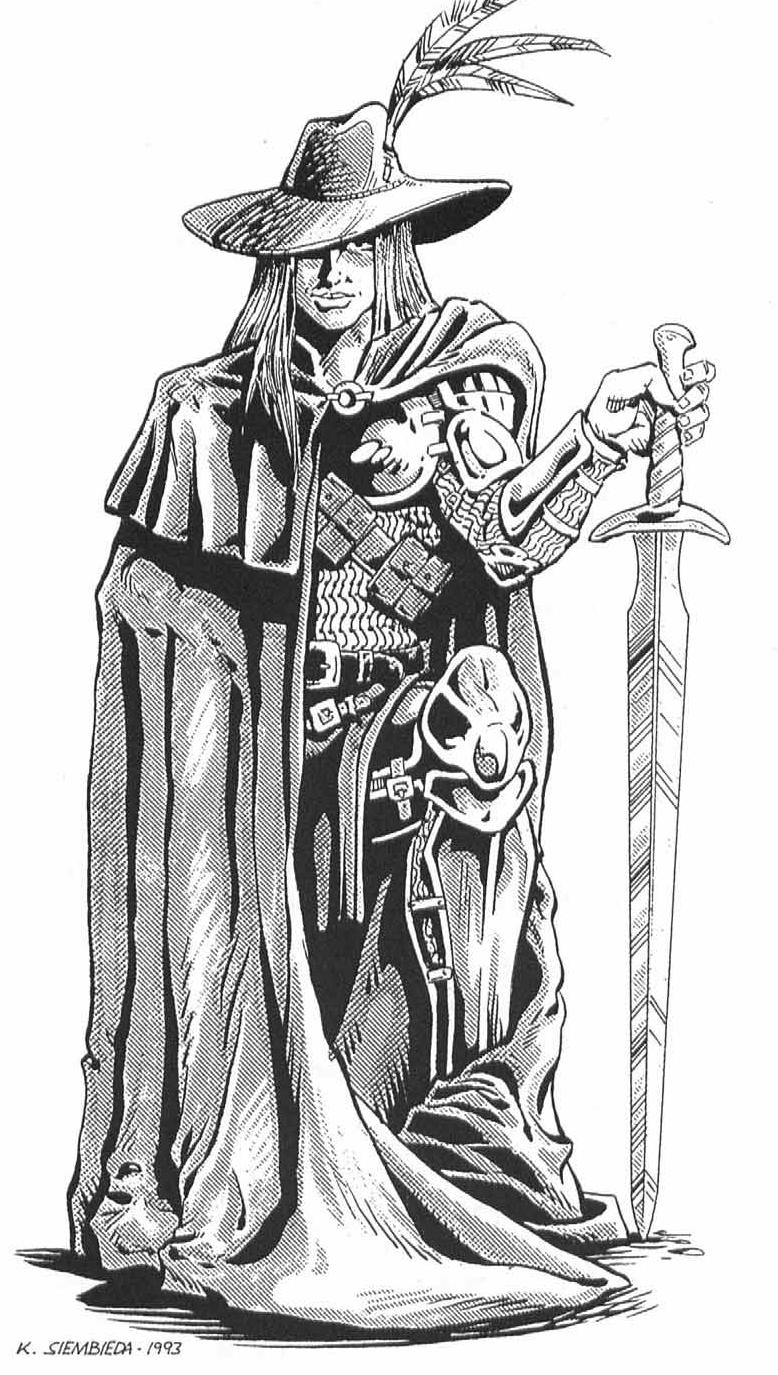
i am completely a human, this is how humans dress right?
Sir Dred
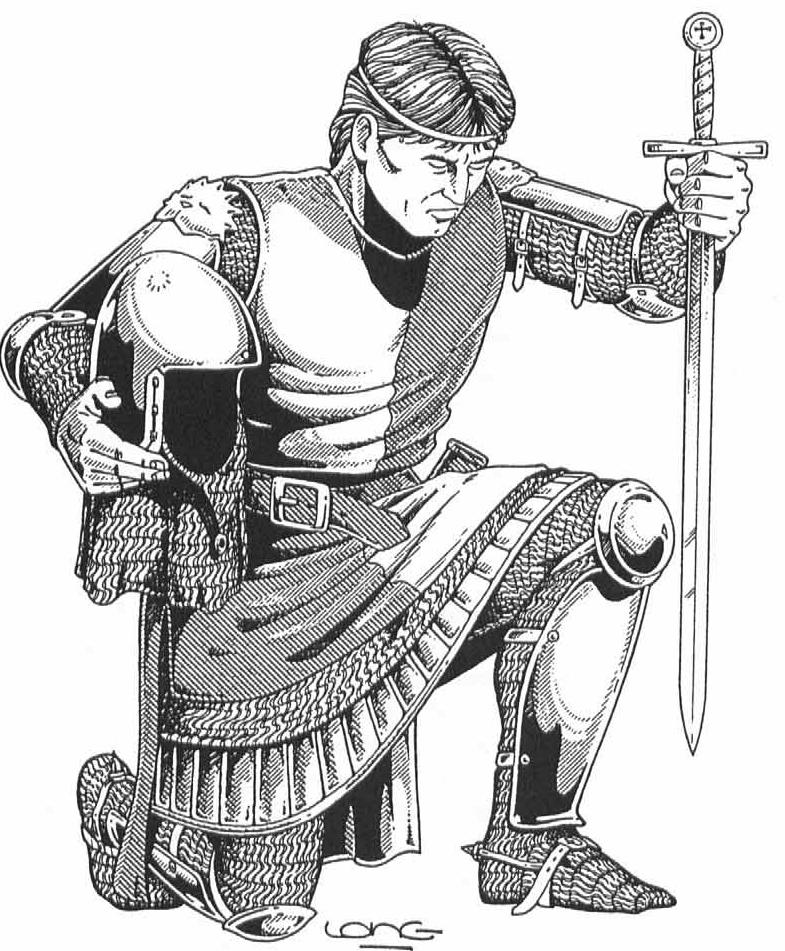
he took his helmet off!?
A selfish and arrogant young knight, easily manipulated to spy for Mrrlyn--and Prrcyvel as it happens, treated with a lot of disrespect, disrespects others in turn. Basically dumb enough to have thrown himself in harm’s way to save Mrrlyn, not realizing the spellcaster is a 2000 MDC shard of an alien god, and was granted knighthood.
Sir Galahad
An Atlantean Undead Slayer--wait, okay, I see now why Arr’thuu might suspect Prrcyvel but not why he’d think his friend would hide it; oh nevermind. Galahad is an ace dude, always helping people out and being gracious. He is at least bright enough to have some suspicions of Mrrlyn and has fought Zllyphan in the past but hasn’t put the pieces together yet. He has a lot of tattoo powers and I am amazed Mrrlyn is not SO plotting to kill him.

magic tattoos still look like temporaries from a vending machine even with a mohawk
Okay, now, for real, finally, New Camelot . This should have been at the front of the book, ahead of the Millennium Trees, ahead of all of Erin Tarn’s nonsense, ahead of the many different kinds of magical farmers and blacksmiths and random Asian dragons.
But it’s here, let’s see what it is. Currently only about 200 square miles total, and it is constantly expanding. About 16,000 people in the “city”. That’s...fewer than my hometown by a slight number, and 3500 of those are stated to be under arms, though 900 of those are militia or 1600 “other warriors” under the military divisions. The city is explicitly stated to be the largest and most powerful kingdom on the British Isles, everything else is wilderness. There are “A few other kingdoms” but the largest of these is 8,000 people, and the next after that only 3,500.
Apparently the rifts really did a number on highly-urbanized Britain and every physical structure on its surface.

New Camelot is celebrating its fiftieth anniversary. Okay. Mrrlyn did create it by uniting a few struggling settlements and basically knitting the whole thing together and establishing trade with the NGR and whatnot. The description of the attitudes of the people could probably be well-summarized by the musical version of Camelot so you can just look that up on Youtube if you like.
The city itself is a hodgepodge of styles with a shiny palace and university and also a Stone Magic pyramid on a line nexus that links to Zazshan’s other controlled Nexus to the north with a different pyramid. There are no tenements or slums, everybody is fairly happy, though humans have it marginally better than non-humans and this divide may grow etc etc.
Despite being happy and musical, the city is enclosed by a fortifying wall which is even more pointless in an era with teleporting, flying, invisible enemies than it was in an era with just artillery, but sure, okay, it has a wall. At least along the eastern side, with sections at the south and west; the north is left open but “this lack of defenses is illusory.” Oh, I see, two of the five (good to know) dragons of Camelot live on the north side. They will defend the city to the death. There are also earth elementals that work for the dragons and piles of rocks that are tectonic entities Mrrlyn commands.
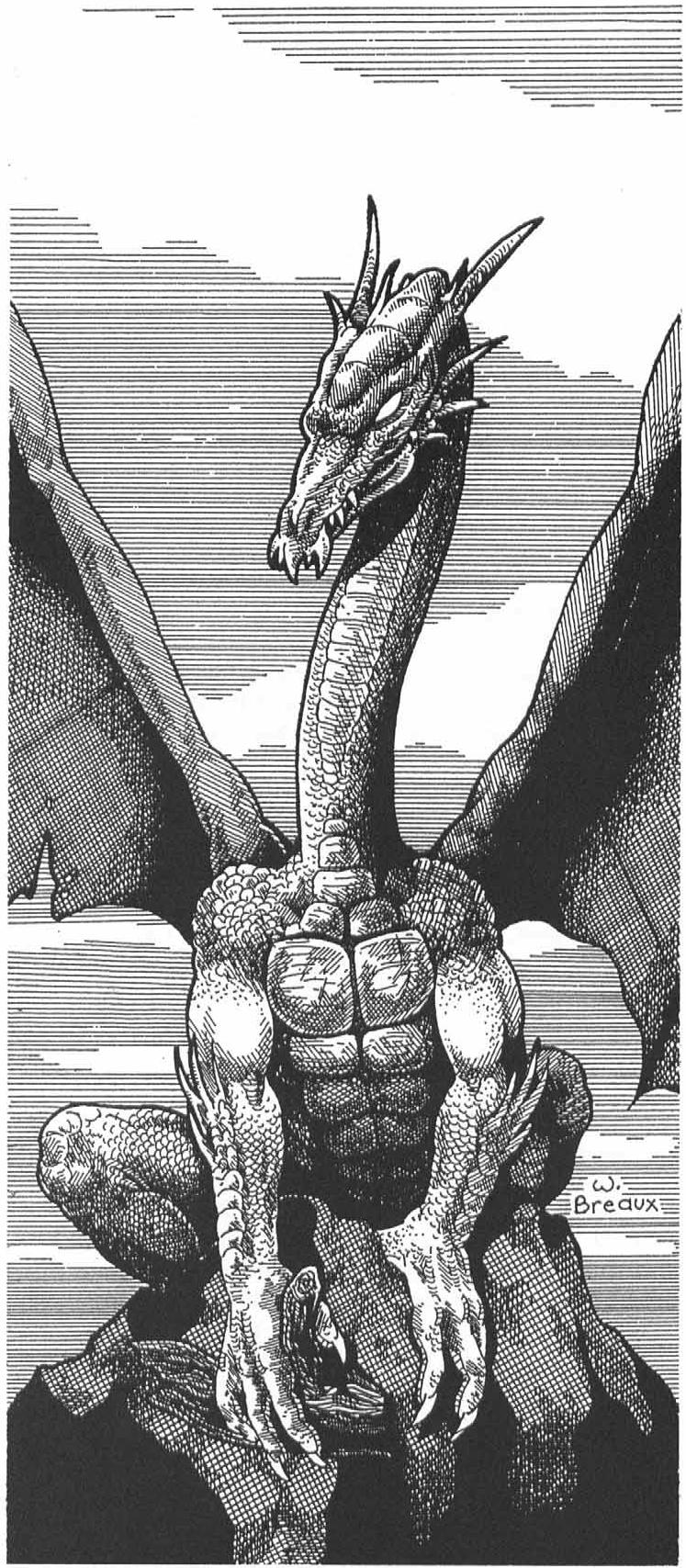
your friendly neighborhood...
Then we get to descriptions of various markets and services offered; basically ‘all’, including a prominent magic shop and a nefarious drug den called the Snake Pit which apparently sells things ranging from regular-grade opium through magical herbs to the occasional bio-wizard component. It apparently only sells to travelers and never messes with the Knights or something so it still exists. Just...moving on.
For some reason a city of 16,000 has an indoor arena that seats 60,000. All kinds of sporting events take place, at least twice a week, including things like boxing, wrestling and swordfighting, but “few are to the death.” I guess it’s like the Ultimate Medieval Times.
There’s also a stable that sells horses. Oh, and a few pegasi and also bionic horses, and throws in some rules and costs for bionic enhancements to regular horses. Cybernetic animals is a mildly interesting idea, particularly for mounts, but they attached these rules to the end of a shop description where you will never ever find them again.
And that’s it. New Camelot, three page writeup, basically a shopping guide. We don’t get any insight into how the governance of the city and surrounding kingdom actually work. Do the KoC get fiefs? Is there a council that advises Arr’thuu? Is there a minister who handles the city stuff while he’s away having adventures? They mention “lords and ladies” but give no structure to this. I imagine the answer to some of those questions is ‘Mrrlyn’ but he’s got his fingers in a lot of pies already to be directly administering even a “city” the size of New Camelot. There’s also a regular police force of some kind I imagine, and--well, at least they have lots of circuses to go with their inexplicable bread. It’s implied that the kingdom has some kind of hereditary nobility thing going on which, fine, the Coalition States has that too. They just actually explained it because Karl Prosek is perceived to be corrupt to be elevating his son to succeed him. New Camelot just sort of vaguely brushes aside all that important stuff like ‘how do they prevent oppression and corruption by a landed gentry’ and seems to assume the player will just know how the court is set up, because all European courts and knightly systems worked the same way, forever.
I know that playing courtly politics is not really a Riftly strong point but they did set up some interpersonal political conflicts, just without really explaining the powers that might or might not fall to the king or how these people influence each other besides ‘gossip, go on adventures, have parties’, maybe there’s just a hardworking civil servant class that just stares at all this weirdness and then gets the king to sign as many documents as possible while he’s sober and before he rides off again.
If Mrrlyn is the one keeping everything all hunky-dory and peaceful for the time being it might be worthwhile to leave him in place a while longer, most human administrations aren’t that efficient.
(I wrote this before ARB made basically the same point in a previous post; for all his evil evilness, Zazshan sure has spent a shitload of time crafting one of the most persistent myths of good in our culture and one of the nicest places to live in horrific wasteland Rifts Earth)
The British Isles, misc
Original SA post Rifts:™ England Part 13: “The British Isles, misc”
Okay, so now we’re branching into the larger realms of the Isles. We get more ‘Terrain and Climate’ and ‘Land Area’ stuff because Palladium just loves that sort of thing, and it also specifies that the coastline of England has changed a bit because of Atlantis bulging up in the center of the Atlantic, which, fair enough. The only sort of weird change there is that the Loch Ness has completely swelled and split north Scotland from the south. I’m not good at Scottish geography but if there is isn’t like a whole nest of sea monsters in there I will be a sad panda.
It also specifies that there are just a handful of large kingdoms and none of them exceed 20,000 people, which, well, we were already told New Camelot is humanity’s A-game in the British Isles so yeah.
there’s a generic illustration of stonehenge here, you know what it looks like
And then we get to Stonehenge, which you knew was coming. It’s on a line nexus point and the British Isles, we have been told repeatedly, are one of the very most magical places on Earth except for possibly the Yucatan Peninsula. I haven’t read either China book but I am going to assume there is some kind of super-mystical bullshit that is either better than, or more properly understood by being in harmony or some shit over there, but one cultural stereotype at a time. At the beginning of the book it says Spriggans rebuilt Stonehenge. Here it says it was untouched by the Great Cataclysm. I just want to note that they have to keep continuously restoring and digging around modern Stonehenge to keep it in something like shape so while Spriggans are dumb, they’re probably more likely.
Anyway, in Rifts Earth, Stonehenge is a super-powerful Nexus and Mrrlyn, the Lady of the Lake, New Camelot, and ‘The Eternal City’ have agreed to at least not let any one power control it. Given that like three of those are almost the same person it seems a bit of a sham. They have at least defended it in concert as a neutral zone on a few occasions. The other nexuses it’s connected to are illustrated in a little diagram and are all probably fairly famous archeological sites in their own right if one is into that. Nortown faerie kingdom is just that, full of fucking faeries. But being faeries they mostly just stick to their place and don’t go off bugging people.
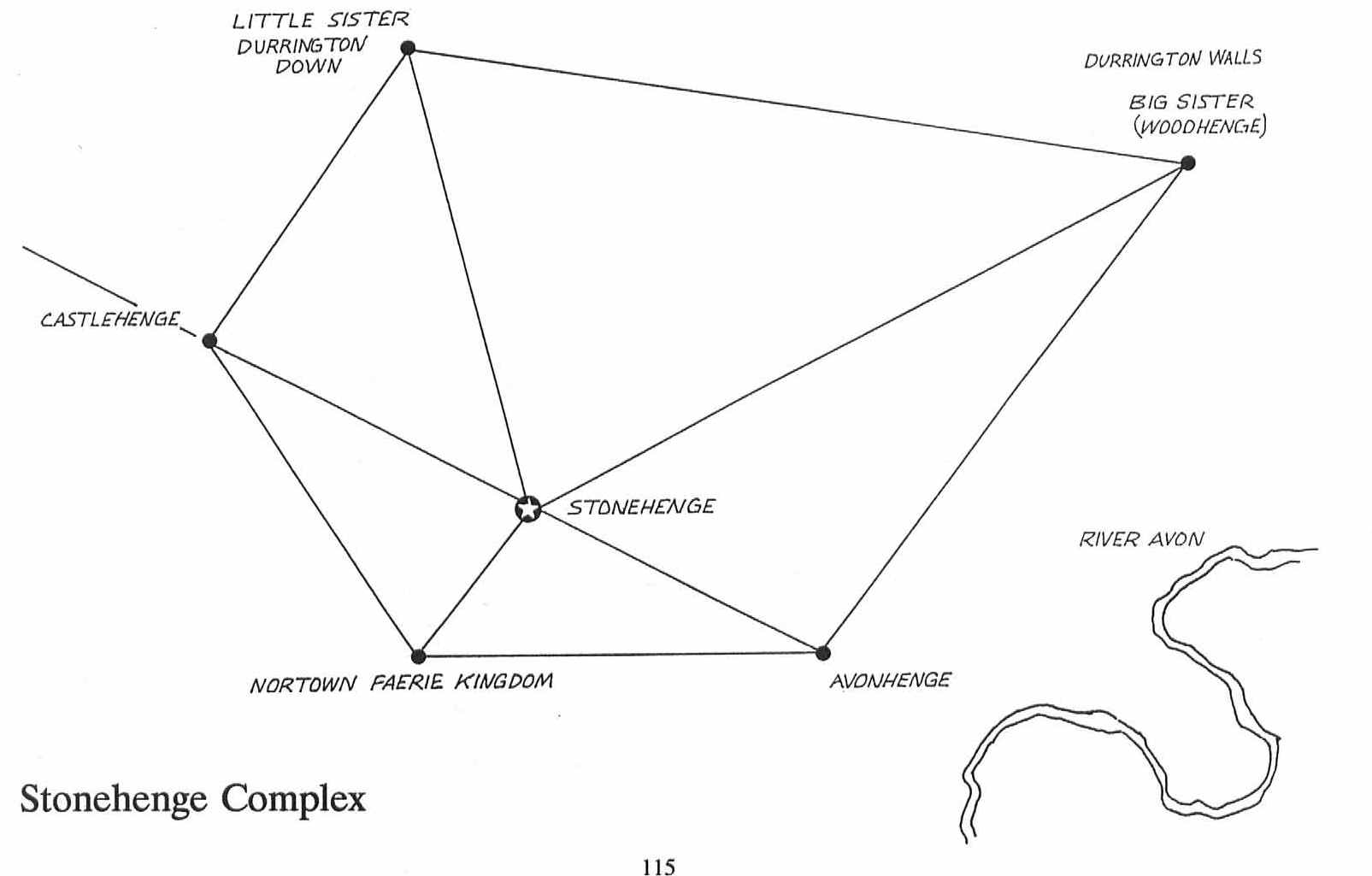
Let’s see, Mrrlyn’s pyramid gets another mention, they talk about another stone ring that was submerged by the Rifts but seems to have a calming effect on the sea, Merrivale and Old Sarum Hill host Millennium Trees, oh, and then they want to give us some NPCs for Sarum Hill. There’s...a nice old druid elder, a Dryad Druid elf healer, a Scathach blacksmith, and a Simvan Monster Rider who is the village champion and widely loved and respected. This section is best summarized by the illustration of what Craig, the monster rider, rides.

lisa frank on line one
Bath is still home to a curative spring, but now it’s magical for real. Also this is where the ‘Eternal City’ mentioned earlier is located; 7400 people, highly mixed population. They believe in freedom and democracy for all peoples and are a ‘friendly rival’ to New Camelot. They charge a nominal fee to “known druids, herbalists and healers” to use the magic water and everyone else has to go through “petitioning the courts.” They’re threatened by a Goblin Kingdom in south Wales and ruled by a King Bronin who--wait, democracy? Well he’s supposed to be a good guy, we hear about his kids, and his wife is cool too or something. I don’t think that’s how democracy works though.
Lemon Curdistan made the point that people in constitutional monarchies often may not make a lot of distinction here since you can totally have an awesome queen and still fundamentally be a republic at least. It just doesn't clarify this point with even the basic adjective of 'constitutional monarchy' which is what I would probably run the Eternal City as were I to use it in anything ever; it would make it an interesting contrast to Camelot's mysteriously enlightened despotism and play up the 'friendly rival' angle.
Next up is the Berwynmoore Kingdom which is a ‘not-so-friendly’ neighbor that keeps a slave population of 2000 or so goblins and seems to be human dominated. It’s located on the former site of the city of Swindon and is ruled by an evil Queen who is going to die soon and be succeeded by her warmongering son because primogeniture; older sister just made a demon pact instead. They actually use conscript troops and act pretty much like a feudal kingdom.
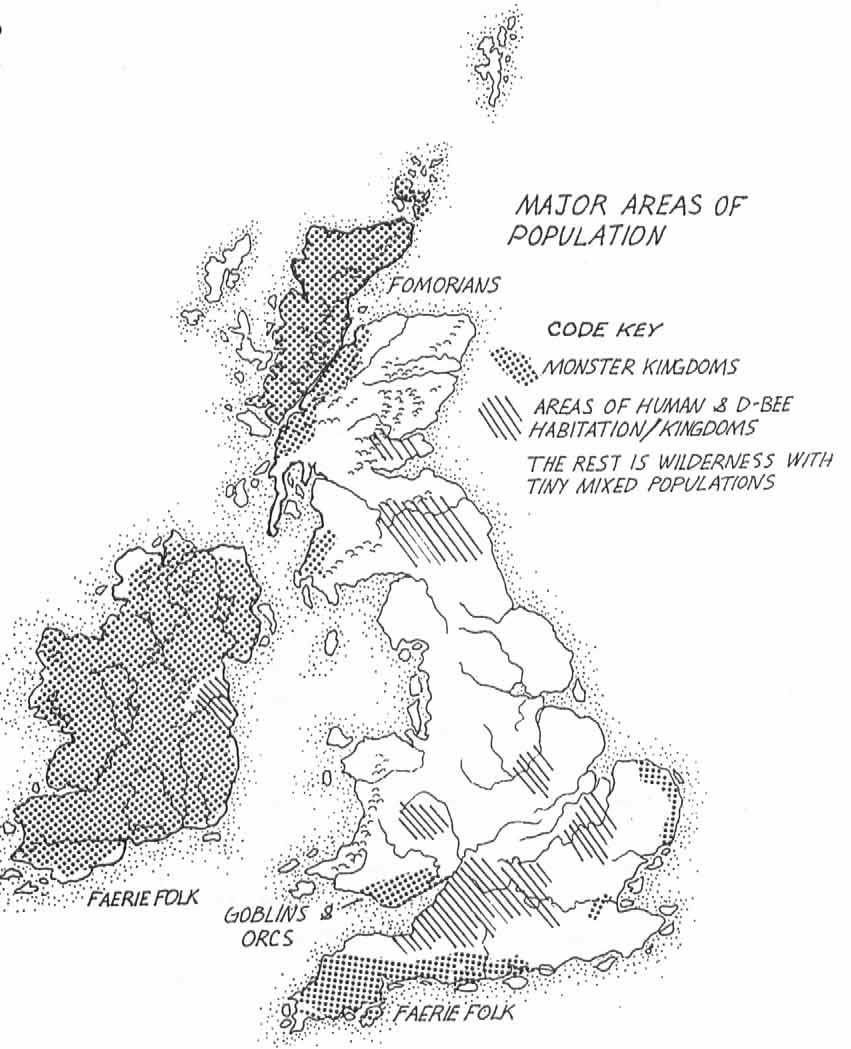
thank you for marking where all these ‘major’ cities are, jerks
A couple more tourist sites/trees are noted, and then we get to London--which is under the control of the Splugorth. They think of England as a wild game preserve and exotic slave hunting grounds, and compete for use of the Stonehenge nexus. Mrrlyn of course is of a rival species, and this is in addition to the Splugorth proudly wearing evil like a badge, so the good kingdoms and even the not-so-good kingdom oppose them. There’s about 6500 total beings there, which is almost twice New Camelot’s total armed forces--plus 1800 slaves, cause somebody gotta make the coffee.
They list some more trees; Margate island seems to be where ‘Dabuggh’
 live and in true Rifts tradition the forces of evil work together, they’re allied with London. They mention the Nog Henge tree (you remember those druids who are actually dragons?) and give an abbreviated stat block for the main guardian--a lot of these stat blocks include attributes and nothing else, no skills, powers, MDC values or anything else.
live and in true Rifts tradition the forces of evil work together, they’re allied with London. They mention the Nog Henge tree (you remember those druids who are actually dragons?) and give an abbreviated stat block for the main guardian--a lot of these stat blocks include attributes and nothing else, no skills, powers, MDC values or anything else.
The ruins of Newport (oh, British cities DO have some ruins) are inhabited by goblins and hate pretty people. The Llyn Fawr nexus is home to trolls and ogres (one of which is a Temporal Wizard) and I only even mention it because the one-paragraph entry is split by two pages of maps detailing (finally) where the major cities are, and also the major ley lines.
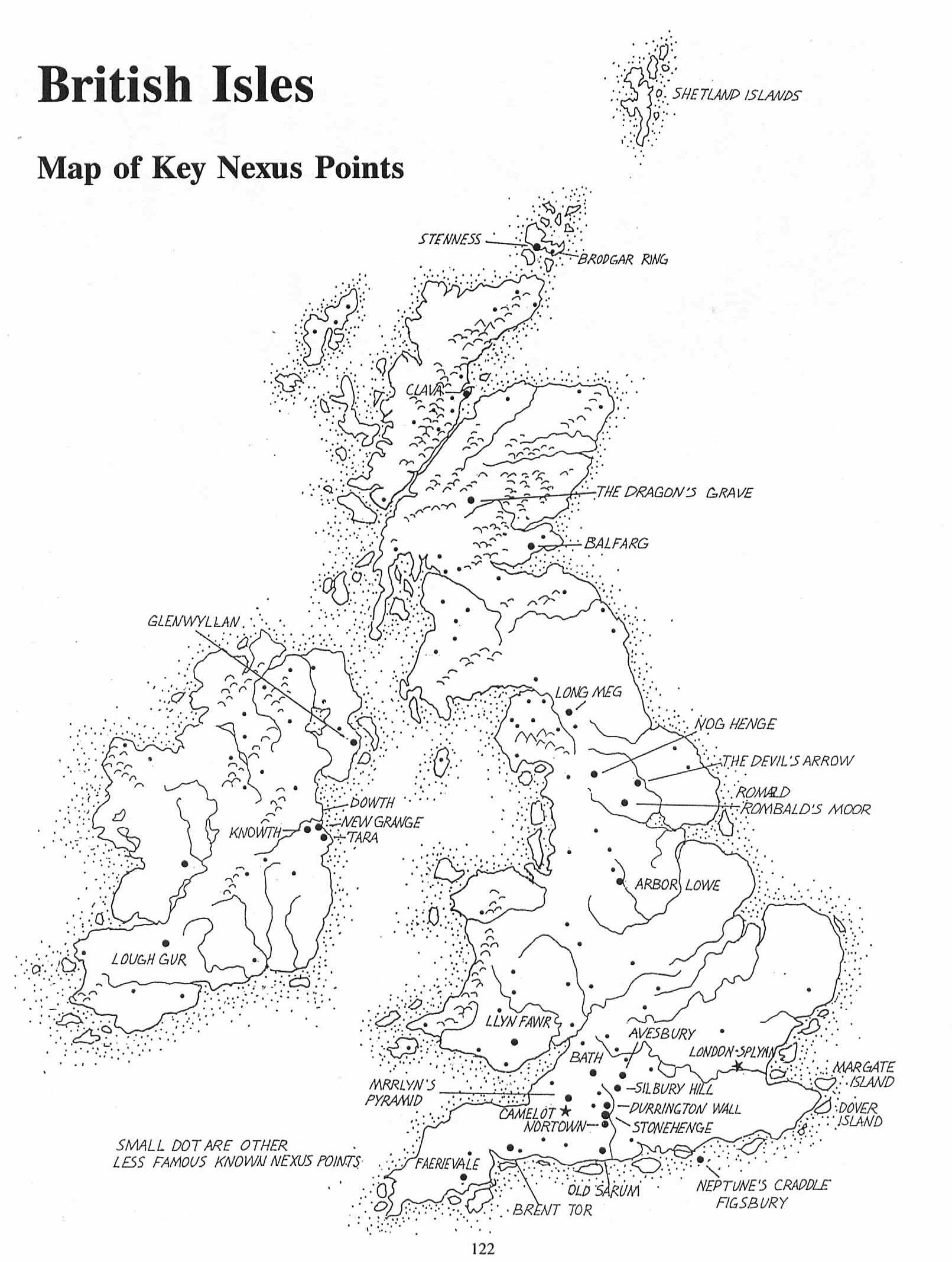
note that they only care about nexuses, which also happen to be cities
Okay almost done--Scotland is very briefly brushed over with ‘Balfarg’ that is a village of about 2000 people that are actually more Dabugghs, the human-looking ones, and human slaves. They plot with the Formorians from Devil’s Arrow.
Lastly, we have the Dragon’s Grave, which is a Nexus point that used to have a big old selfish dragon living in a stone pyramid there until a giant monster came out of a rift (aren’t pyramids supposed to control those?) and killed it and destroyed the pyramid; the text says this was Lord Splynncryth himself which makes very little sense since I thought he came in from Atlantis, and if he came into England 200 years ago (when this supposedly happened) that was before all these stupid human kingdoms established themselves and England is so full of magic and--ugh.
Oh, wait, not quite lastly. ‘The Highlands’ are the domain of the Formorians and the old Celtic Gods. Guess who’re getting statted next?!
Celtic Gods aka henna and psychosis
Original SA post Rifts:™ England Part 14: “Celtic Gods aka henna and psychosis”
So here we get yet another species of giant, Fomorians though I would be slightly surprised if they didn’t use these. The ‘Gigantes’ in the Conversion book were sort of similar but these are all specifically deformed, one-eyed and with a deformed left foot. They’re evil and blood-drinkingly murderous. They’re reasonably tough; a few are ‘Blood Druids’ in yet another thing to be explained later. They get ghostly warhorses that are as tough as some robot vehicles and there are 100,000 of them. Ugh, here we go with the overpowering villain factions again.
 Bres, their godly leader, can summon 1000 more an hour to get up to 100,000 more through a rift to a dimension where they have a million total. They just can’t come within 3000 feet of Millennium Trees.
Bres, their godly leader, can summon 1000 more an hour to get up to 100,000 more through a rift to a dimension where they have a million total. They just can’t come within 3000 feet of Millennium Trees.
We get stats for “Balor II,” the first one apparently died. He has a magic eyebeam and is tuff but not very remarkable. Bres the Beautiful meanwhile has 10,800 MDC exactly and is the legendary leader of the Fomorians who tried to destroy the Isles once before and was only stopped by Lugh the Shining One and forced back into their dark realm. I’m not very up on my Celtic myth and don’t feel like looking it up but I assume this is a Rifts-y rendition of the story. Funnily enough, I recall the Celtic Gods in this book being kind of wimps compared to what they started putting out in Pantheons of the Megaverse and some of the later books that started shoving mythology into Rifts but Bres is no pushover here. He’s about on par with the Conversion rules for ‘Supernatural Intelligences’ though he lacks their dimensional teleport fuck-you and possession abilities.
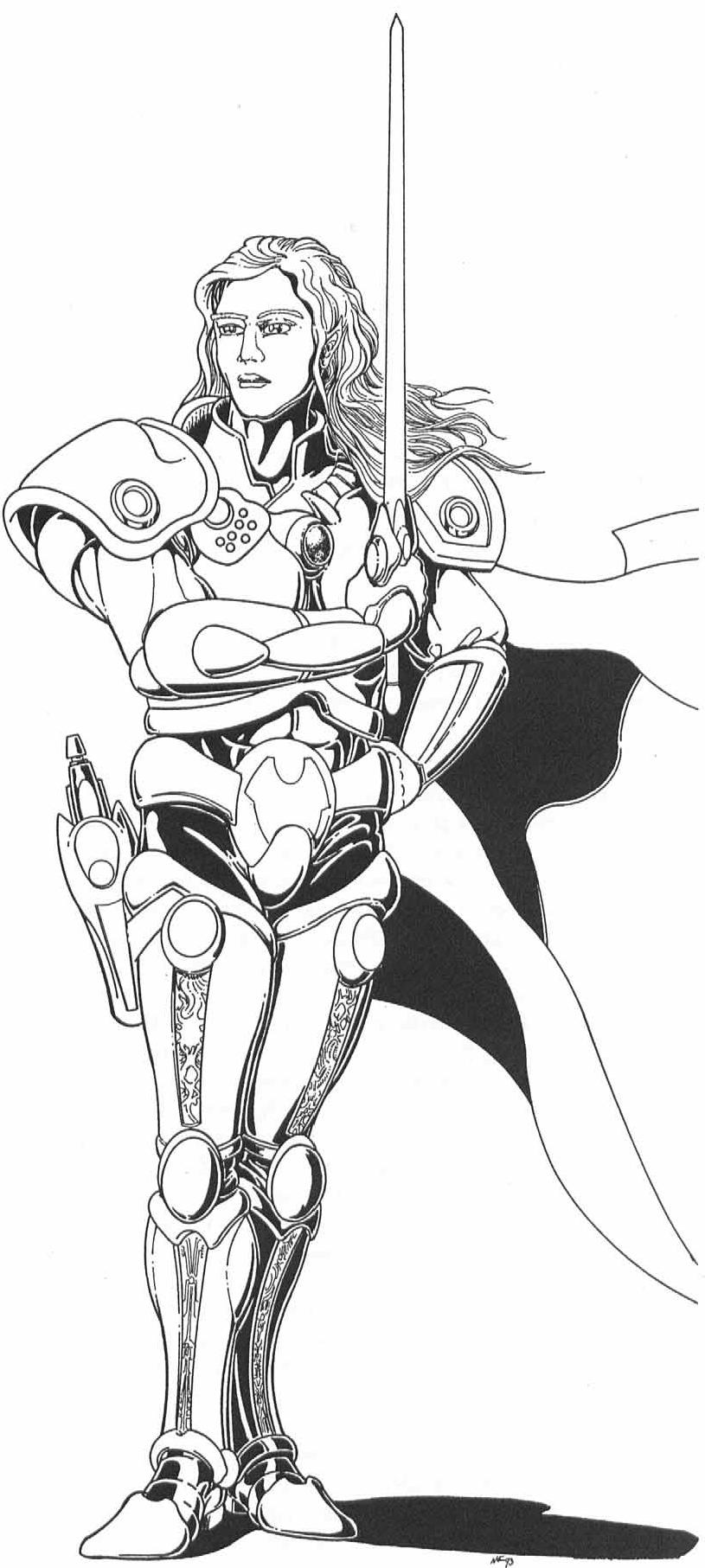
Lugh the Shining One is in a similar range of power though he has 16,300 (very specific again) MDC and no army of MDC giants. Also his powers have faded a little with time apparently but he can still shoot 6D6 MD lasers, which, yeah, he and Bres might be at this a little while if they fought directly.
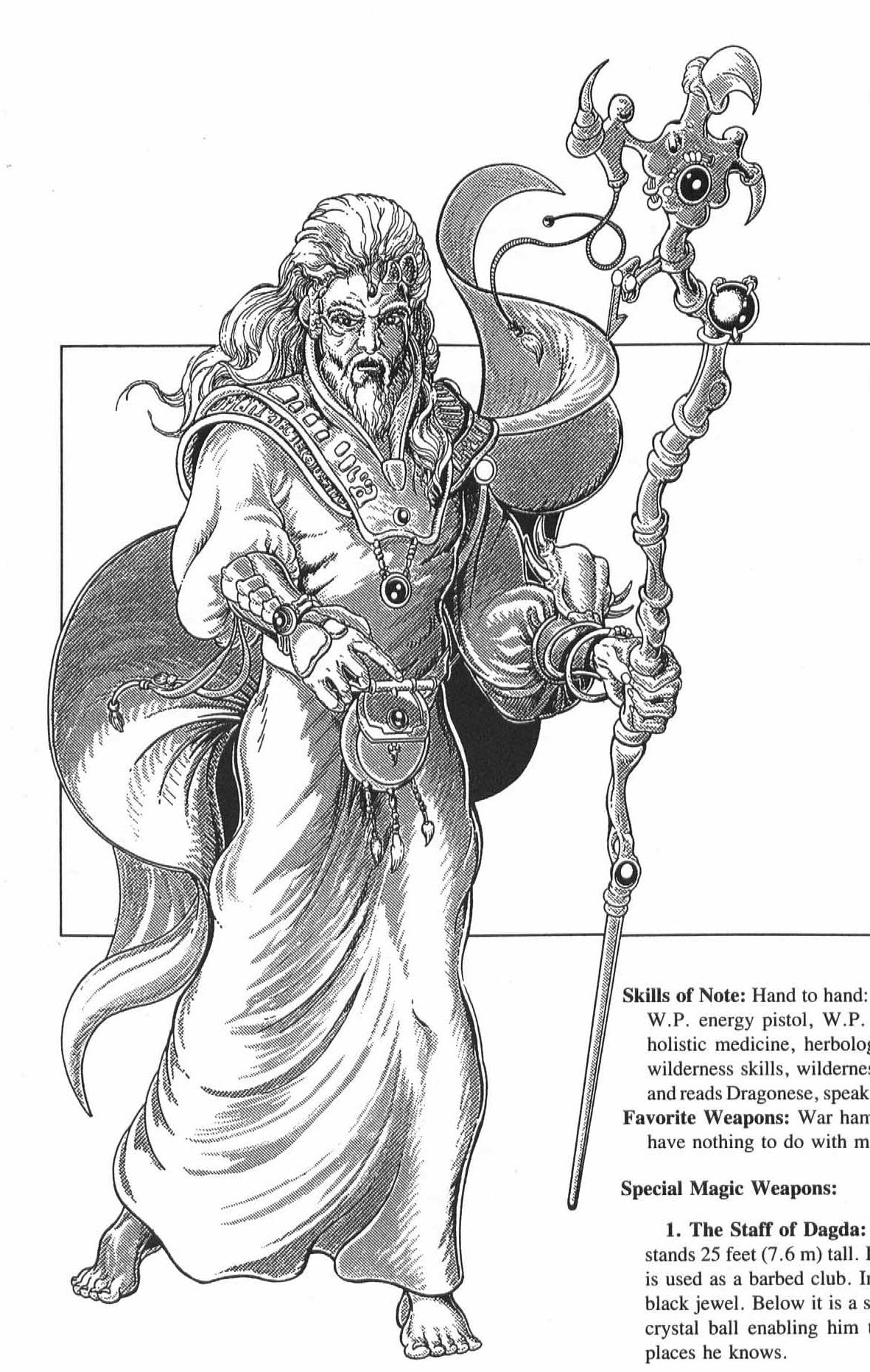
i have no idea what that staff is about
Dagda the All-Father is included as well, and he seems to have gone senile; Alignment is “once scrupulous, now anarchist.” But he still hates Fomorians and slays them whenever he finds them. He also still likes visiting Millennium Trees. He has some legendary magic items including his staff and an eight-foot magic rune harp that can hop and move itself around and must be totally inconspicuous following Dagda around.
That’s all the Celtic Gods we get. No Brigid or Morrigan or even some stupid version of Cu Chulainn as a high-level Dog Boy or something. They included some Mayan stuff in Vampire Kingdoms but it was just an excuse for more demons mostly--and they were wimps compared to these guys, looking back at the other writeup. MDC of 2500? Pfff. There just isn’t a lot of use of the material--I guess Siembieda used up his store of mythological appropriation on Zazshan.
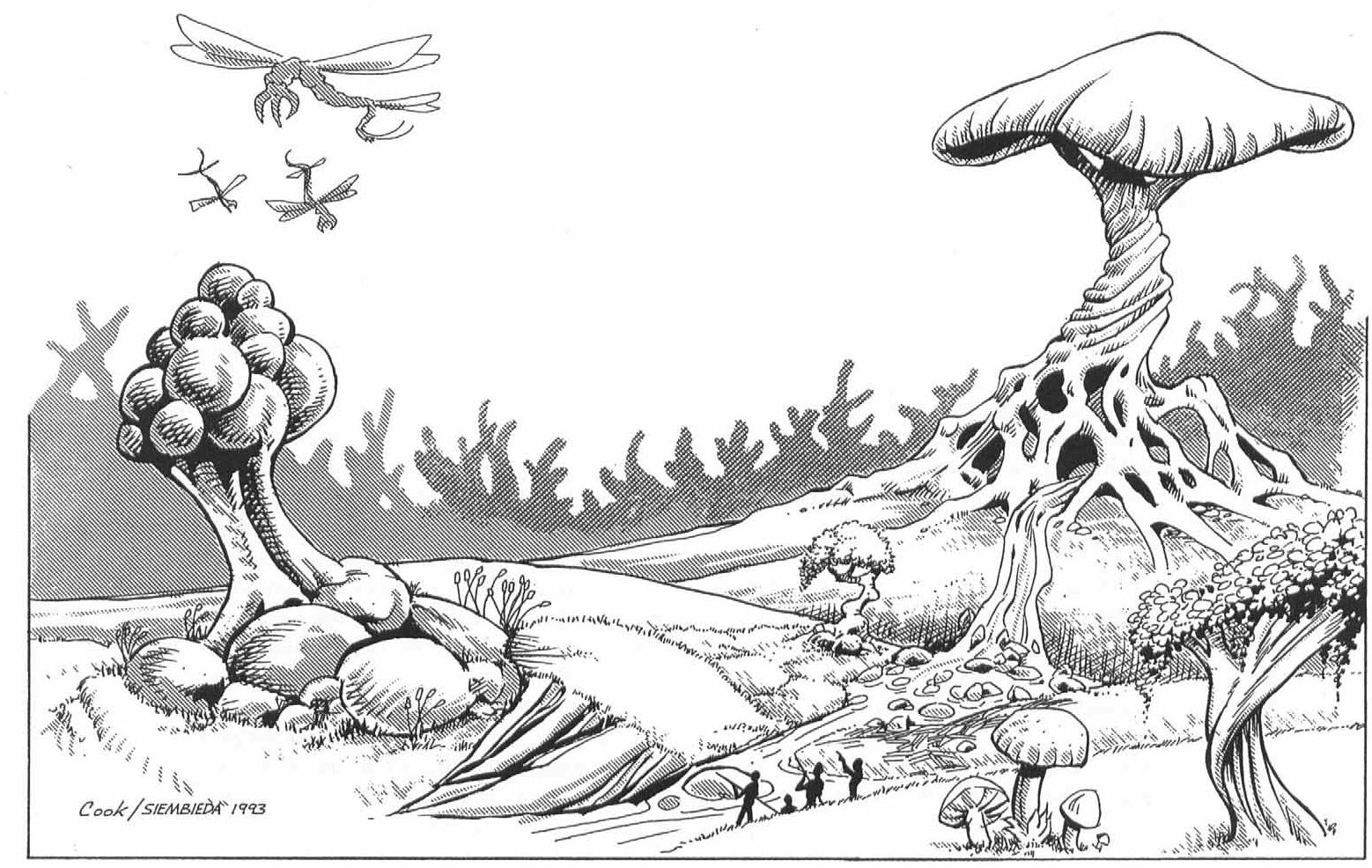
okay even i recognize this as a nausicaa ripoff
Oirland
Original SA post
Okay, we're almost done. This starts in on all the crap (I mean even by Rifts-levels crap) material that gets kind of shoved into the back of the books and is often equal parts 'dull junk' and 'good idea completely wasted'. Unfortunately for England it's mostly the 'dull junk' end of things.
Rifts:™ England
Part 15: “Oirland”

Today we get
Ireland, the Land of Enchantment
which sounds like a new ride the Epcot Center or a promotional video for a timeshare. Really, it’s just chock-full of faeries and monsters of various kinds.

like these
There are a lot more
 about the faeries and how they are just so darn
crazy
and prankful and how travelers best be wary and if you ever wanted to play a faerie PC, here is the right time and place for it because they’re everywhere. Hey, maybe you want to take a break from the normal serious business of a Rifts campaign, and just play a bunch of goofy faeries for a while! How does that sound!?
about the faeries and how they are just so darn
crazy
and prankful and how travelers best be wary and if you ever wanted to play a faerie PC, here is the right time and place for it because they’re everywhere. Hey, maybe you want to take a break from the normal serious business of a Rifts campaign, and just play a bunch of goofy faeries for a while! How does that sound!?

The biggest humanish kingdom in Ireland is Tarramore, which is at roughly a 19th-century tech level which means potato famine or something--no, wait, they’re wealthy and enjoy many of the luxuries of Triax technology--these two sentences directly contradict each other. Apparently obsessed Spriggans rebuilt Dublin and basically made a huge pile of pre-Rifts artifacts which human settlers then found and sold for billions of credits. They have a deal with Mrrlyn for trade and protection. I’m going to skip the other city highlights except for this bit: They have a ‘Goblorc heights’ where they have a well-behaved goblin/orc population who are “citizens” and generally paid half what others make but they “don’t mind because they know they have a bad reputation.”

Ireland apparently has other places in it too but most of these are just sort of bullet-pointed monster lairs; a bunch of sphinxes and ley line walkers are doing something weird at The Grange, a large goblin tribe considers some place sacred, more spriggans, faerie mounds and Millennium Trees.
And a section marked “Adventures” which is the following:
”Rifts England” posted:
The numerous descriptions of different characters, occupational character classes, monsters, gods, and places should give players and game masters tons of ideas of conflicts and adventures. Thus, there are no specific adventure scenarios presented.
There is an entry in the Table of Contents for this.
There’s also a Random Encounter table at least. At least? No, this is extremely random. “Two flash beetles mating.” “An evil 6th level Herbalist leading bandits, 4th-5th level” “A 1D6 level hatchling dragon, GM’s choice, looking for trouble.” “The Celtic God, Bres or Balor II, looking for a fight.” I--what--this table is half TPKs.
And then right after the table of random player-crushings, we get “An Adventure Plot Idea” in direct contradiction to the statement above. It’s titled “Leprechaun cave,” this already sounds like it will be full of whimsical excitement. Anyway, there’s a cave and it’s supposedly haunted
 but also rumored to be the treasure cave of a leprechaun pickpocket who has plundered the woods around this cave. It isn’t given a specific location, which is fine, just that it’s at the bottom of a cliff.
but also rumored to be the treasure cave of a leprechaun pickpocket who has plundered the woods around this cave. It isn’t given a specific location, which is fine, just that it’s at the bottom of a cliff.
‘Observant characters’ (note that Palladium has no perception rules) may note 1D4+1 gold coins, a dagger, and a spent e-clip atop the cliff and if they look down they’ll probably see the cave. There’s a small tribe of goblins that live there but players can dispose of those fairly easily. Further back is a room full of junk lit by bioluminescent moss and a torch, and a curtained alcove. There’s a petal thing behind the curtain but “before anyone looks behind it, it will try to possess one of the group” and try to make them attack. If they put a stop to this, the monster will “use other methods of attack to kill at least one or two of the group” and once it’s fed on the PPE of those deaths, won’t want any more fighting so will try to scare the PCs away, and of course if that works they totally won’t just come back and dynamite the place later. The petal thing also apparently has a mate and they stalk the woods together; there is no leprechaun at all. Also: there is shit for actual treasure as a reward for killing the Petal Thing.
I guess this isn’t bad for an example of a single planned encounter or short adventure. Petal Things are a huge pain for no gain except a little XP I guess, and the lack of reward makes the scenario kind of unfulfilling. It’s like all those Skyrim caves that don’t have levelled chests.
There’s another, longer scenario after this one but it’s long enough to merit a separate post, and some time for my liver to recover from the bile of reading it. Also there's a tiny bit about France.
The Well of Wisdom, Blood Druids, and France
Original SA post Rifts:™ England Part 16: “The Well of Wisdom, Blood Druids, and France”
Okay I guess this is only sort of an adventure seed, but also just another Location of Interest. It’s north of Silbury. It’s a 300 ft diameter 50ft mound with a single standing stone at the eastern side. The stone is called the Guardian, and at midnight a white mist forms around it, then vanishes, revealing an opening in the hill, and a big stone (literal) giant.
Now, we’re dealing with adventurers here, so they’ll approach, and hear this greeting:
”Rifts England” posted:
All those who come, compelled by a good and just cause, to seek an answer may enter. But be warned that all must exit before the birth of light or be forever encased in Earth and rock. Those with evil intent or who are the servants of evil, will be destroyed.

Whatever, anyway, obviously we’re going in the hole. Or through the door rather. Going inside washes good characters with a warm gentle breeze. Evil characters or anarchists with evil intentions will feel a sensation of doom at horror factor 19 , which is to say, higher than many cosmic evils. If they keep going they get wracked with agony and lose half their S/MDC, and if they continue they get destroyed by a “spinning wheel of light” that does 2000 MDC per round. Take note of that number, because there are numerous beings in existence that can stand that for a reasonable time, if they wanted to go fuck around with wishing wells.

Good-hearted souls who continue onwards find a room that can hold eight human-sized people around a solid gold four-by-two foot table on four-inch legs. The table (or someone) informs the listener that they are in service of all good causes and can ask their questions, warning them against trifling with the table. Asking the table questions will elicit answers but it isn’t omnescient nor can it see the future, and it flat-out refuses to talk about itself. Answers it can give are given in different voices depending on the subject; most of its knowledge is of a practical nature. Most useful, perhaps, is its knowledge of history, given that seems to remember a great deal from during the period of the Cataclysm. Of course that’s mostly interesting to academics. It knows a little bit about Mrrlyn and is pretty sure the Supreme Nexus Knights are evil. All its info seems about 25 years old, maybe that was when the table stopped paying its magical broadband?
Also, foolish or derogatory questions are likely to anger the table. It may ignore people or cast a ‘mute’ spell on them. If they really upset the table, it will teleport them outside in a huff. If they attack it, it will defend itself with its limited arsenal of spells and/or summon the disintegrating light. Also the Guardian will help out.

not the guardian
There’s a brief excerpt from a book about the Well of Wisdom about its theorized origins that actually does a great job of mimicking the tone of those books that write about how unexplained phenomena must be some kind of primordial consciousness or whatever. Also the author thinks all the dead great minds of the world get drawn to it and what it knows is what they know. Citizens of New Camelot are forbidden to talk to the Well though the penalty is a lecture and a fine.
Now presumably we will be getting an explanation for what the table really is, which is apparently ‘an Ogeeyin’. They appear as balls of flesh that are mostly smooth and pale pink or tan, with sectioning lines marking it into equal quarters, with two antennae and four hemispherical life nodes. Each of these quarters is a separate mind that’s part of the collective body. Why do I feel like I just described a modron? Anyway these are psychic/magical beings who have an Alien Intelligence-like ability to astrally project and become resident in an object of stone and one of them felt sorry for Earth. They observed for decades and discovered the table--it does contain dead minds within it, but other than that its origin is unexplained
 It’s indestructible and has some various magic to it, and the Ogeeyin (really?) put up this whole mound business over it to help protect it because they are one of the rare ‘generally good’ aliens in the Rifts universe.
It’s indestructible and has some various magic to it, and the Ogeeyin (really?) put up this whole mound business over it to help protect it because they are one of the rare ‘generally good’ aliens in the Rifts universe.
And that’s it. That’s the adventure seed. Have fun asking the GM about astronomy and woodworking!
Anyway, France
Normandy has been blighted by some kind of terrible plague that prevents all life from growing there up to 50 miles inland. Past that, much like England, France is a pastoral wonderland full of...what? Blood Druids?! Also Paris is full of goblins and mutants and other monsters and filth and I am not going to make any obvious France jokes here.
 The writeup for the area is basically a paragraph and a half.
The writeup for the area is basically a paragraph and a half.
The Blood Druids get a bigger section up ahead, they’re a death cult, not a rogue unit of the Red Cross, alas. They work like anti-Druids (as defined by this book) trying to spread anarchy and chaos and teaching monsters and d-bees secrets of the land. They occupy a little village with about 2600 inhabitants, most of whom are mysteriously unaware of the doings of their friendly local ‘Blood Druids’ elsewhere. They’re situated near where Geneva used to be. These guys are specifically listed as not being meant as PCs which is odd since they list possible alignments as ‘any’. I mean doesn’t every death cult deserve their Drizzt? Note: They don’t hate humans, they pretty much just hate everyone and try to stir up as much trouble as they can all over.
They have some of the standard druid powers plus some blood-sacrifice related stuff like seeing the future and limited psychometry and healing. The really most noteworthy thing here is that they can detect a possessing entity, or former presence of one. Also they don’t get much PPE, to encourage that human sacrifice to power mystic herbology. They’re not bad as villains really, you can make some decent stuff with the herb rules and they’re willing to engage in the nastier parts of ritual magic to do it more easily, but they’re not crazily overpowered like a lot of enemies.
Anyway, that’s France, and the end of the book. Mostly it’s terrible. The Herbologist class could be semi-interesting if they beefed it up a little, and certainly would be someone with a reason to go tramping out in the wilderness, but the herbs section is so long and padded, I know this was pre-internet but really. The Temporal classes are probably the single best thing in the book, honestly. Everything about Arr’thuu and New Camelot is annoying as hell, though it is nice to see an area of Rifts Earth with more than one non-dick civilization--of course the Fomorians are just waiting to sweep down and eat them all and Mrrlyn is an alien intelligence and
 . Most of this book is pretty dull, listings of locations almost like checkboxes in a travel book and stupid, stupid druid classes.
. Most of this book is pretty dull, listings of locations almost like checkboxes in a travel book and stupid, stupid druid classes.
Seriously, all the druid classes are next to useless and not good adventuring matter--this runs into the problem of NPC classes in general I guess, since some of them would definitely be people their community would want to have around but then you have to go and say they’re 7th level or something.
It’s also annoying how most of pre-Rifts England is just...gone. I realize that the roughly 300 years of the Cataclysm would in fact have done away with a lot of what came before but where North America was called out specifically as dotted with ruins (just imagine the Fallout Mod you could make out of Rifts) England seems to have lost all its urbanization and technology, except for a few spots pointed out specifically as having ruins, like Dublin. People ride horses in power armor. It’s all very Celty and Rustic-feeling I’m sure but despite Tolkien’s allegories, England is not the goddamn Shire.
And appropriately enough, we close with a mushroom.
